








































BIG MOVES ON CAMPUS 14 BIG ADVENTURE: THE RAMBLIN’ RAFT RACE 38 LARGERTHANLIFE CREATIONS 48 BIG IDEAS ON LIVING 56 THE
“In MSE, we liked to say everything is material, everything else is immaterial. There is no advancement that isn’t going to involve materials.”
—
Mary Z. McEneaney

Founders’ Council is the honorary society recognizing donors who have made estate or life-income gifts of $25,000 or more for the support of Georgia Tech. For more information, please contact:
404.894.4678
• giftplanning@dev.gatech.edu
• plannedgiving.gatech.edu

Make your impact in a data-driven world. Expand your skills and increase your career opportunities with a 100% online Business Analytics Graduate Certificate from the Georgia Tech Scheller College of Business.
Here are four reasons to apply for the program:

1 Elevate your career: Increase your expertise to stay ahead in today’s competitive business world.
Data Speaks. Are You Listening?
Gain hands-on experience: Learn how to use analytics tools in practical case studies and projects.
Make your impact in a data-driven world. Expand your skills and increase your career opportunities with a 100% online Business Analytics Graduate Certificate from the Georgia Tech Scheller College of Business.
Learn from anywhere: Study at your own pace online, with fall and spring semester starts.
Here are four reasons to apply for the program:
1 Elevate your career: Increase your expertise to stay ahead in today’s competitive business world.
2 3 4
2 3 4
Earn graduate-level credits: Select credits earned can be applied to a Georgia Tech Full-time MBA, Evening MBA, or OMS Analytics degree.
Gain hands-on experience: Learn how to use analytics tools in practical case studies and projects.
Learn from anywhere: Study at your own pace online, with fall and spring semester starts.
Learn More: TechGradCertificates.com
Earn graduate-level credits: Select credits earned can be applied to a Georgia Tech Full-time MBA, Evening MBA, or OMS Analytics degree.
Learn More: TechGradCertificates.com
BIG IMPACT
WWHEN I THINK BIG , I think of Georgia Tech. The following pages feature stories about big ideas, moments, decisions, and innovations from our community. Yellow Jackets like to “go big” with the way we revolutionize the industries we join, the structures we build, and the way we connect.
e growth we see on Georgia Tech’s campus is also big. Not only are we expanding our facilities, but our student body continues to grow. Last December, we saw over 6,300 students receive their diplomas and join our alumni family. This growth would not be possible without support from Roll Call, which is an easy way to give what you can to make a meaningful impact on the future of our community.
Back in 1947, in the wake of World War II, Georgia Tech faced a critical lack of funding. e Institute and the Georgia Tech Alumni Association asked students and alumni to help. We dropped our dues requirement and asked everyone to give $5 plus a dollar for every year that passed since they had graduated. We called it Roll Call because alumni were asked to be “present” in support of Tech. e tradition stands strong today. Georgia Tech has grown since Roll Call began, but that doesn’t lessen the need for your support. Any amount makes a big impact on the community. Gifts to Roll Call are unrestricted, which means they can

I had this jacket made to make it easy to give to Roll Call, which supports the Institute’s Transforming Tomorrow campaign.







address sudden challenges like in 2020, when the Alumni Association partnered with the Division of Student Life and the O ce of Development to support students who were impacted by the pandemic. Yellow Jackets take pride in being part of the Roll Call tradition. I think back to a handwritten note and a $10 bill that I received in the mail from an alumnus who had given to Roll Call for decades. He explained that he had made bigger gi s in the past, but he didn’t have the resources now that he used to have. The alumnus said he couldn’t stand to miss a year, so he was enclosing a small gift to be “present and accounted for.” That was so meaningful to me. Even the smallest gi s add up to make a big impact.
Roll Call supports students like Kyle J. Smith, PP 22, who traveled to Washington, D.C., for an internship in the U.S. Senate through Tech’s Federal Jackets Fellowship. I also think of all the students who bene t from the Tech Promise Scholarship and other programs supported by Roll Call such as one-on-one mentoring and funding for study outside the classroom.
Georgia Tech is a network of experts who love to make an impact and support our community. Join me and do this in a big way through traditions like Roll Call.
Go Jackets!
 DENE SHEHEANE, MGT 91 PRESIDENT GEORGIA TECH ALUMNI ASSOCIATION
DENE SHEHEANE, MGT 91 PRESIDENT GEORGIA TECH ALUMNI ASSOCIATION
GEORGIA TECH ALUMNI MAGAZINE
VOL. 100 | NO. 1
PRESIDENT & PUBLISHER
Dene Sheheane, Mgt 91
VP STRATEGIC COMMUNICATIONS
Lindsay Vaughn EDITOR
Jennifer Herseim
ART DIRECTOR
Steve Hedberg
COPYWRITER
Matt Sowell
COPY EDITOR
Barbara McIntosh Webb
STUDENT ASSISTANTS
Riddhi Bhattacharya, Sadie Mothershed, Alisha Tan
EXECUTIVE COMMITTEE
Chair
Betsy Bulat, IAML 04
Past Chair/Vice Chair of Finance
Magd Riad, IE 01
Chair Elect, Vice Chair/Roll Call
Tommy Herrington, IM 82
Vice Chair
Rita Breen, Psy 90, MS IE 92
Member at Large
Jason Byars, ME 96
Member at Large
Amy Rich, MBA 12
Member at Large
James “Jim” Sanders, IE 88
Member at Large
Anu Parvatiyar, BME 08
BOARD OF TRUSTEES
Jennifer Abrams, PP 17; Latanza Adjei, IE 98; Thomas Antonino, BA 15, MSA 22; Sybrina Atwaters, EE 94, MS HSTS 09, PhD HSTS 14; Donald Beamer, Econ 05; Michael Bogachek, IE 00; Alexia
Borden, IE 01; Jasmine Burton, ID 14; Jacky Cheng, IE 17; Catherine Cooper, IE 90; Aurélien Cottet, MS AE 03; Cynthia Culbreath, IE 93, MS IE 95; Elizabeth
Serafine Donnelly, IA 08; Matthew Dubnik, Mgt 03; Adam Fuller, Mgt 93; Robyn
Gatens, ChE 85; John Gattuso, ME 15; Joy Jordan, ChE 92; Olivia Langevine, IAML 13; Meghan Green LaRue, Mgt 13; Antonio
Llanos, CS 95; Matthew Mason, IE 01; Randolph McDow, IE 95, MS PP 03; Meredith Moot, Mgt 08; Kyle
4 SPRING 2024 | GTALUMNI.ORG/MAGAZINE
Porter, Mgt 04; Jacquelyn Renée Schneider, BC 06, MBA 18; Rene Simon, MBA 18; Chad Sims, BA 15; Greg Sitkiewicz, IE 00; Courtney Robinson Smith, Mgt 00; Mary Lynn Smith, EE 88; Miya Smith, IE 03; Russell Smith, Cls 98; John R. Spriggle, ME 02; Kenji Takeuchi, ME 94; Maurice Trebuchon, IE 86 GEORGIA TECH ALUMNI MAGAZINE (ISSN: 1061-9747) is published quarterly by the Georgia Tech Alumni Association, 190 North Ave. N.W., Atlanta, GA 30313. Periodical postage paid in Atlanta and additional mailing offices. © 2024 Georgia Tech Alumni Association POSTMASTER Georgia Tech Alumni Magazine, 190 North Ave. N.W., Atlanta, GA 30313 editor@alumni.gatech.edu (404) 894-2391 PUBLISHER’S LETTER
GUINNESS WORLD RECORD
In 1978, Guinness declared the Ramblin’ Raft Race the largest participatory sporting event in the world.

BIG ADVENTURE
In the 1970s, the Ramblin’ Raft Race drew hundreds of thousands of people to a 9.2-mile stretch of the Chattahoochee River.
LARGERTHANLIFE CREATIONS
Ten examples of Yellow Jacket ingenuity pushing upward and outward.
FEATURES
BIG IDEAS ON LIVING
What happens when you super-size an idea? See where “going big” has led these Yellow Jackets.
GTALUMNI.ORG/MAGAZINE | SPRING 2024 5
COVER ILLUSTRATION CHARLIE LAYTON VOLUME 100 ISSUE 1
38 48 56
DEPARTMENTS

TAKE A HIKE
A steep 56 feet of elevation, Freshman Hill was named for the freshman dorms located at the bottom of the hill on the corner of Techwood Drive and Bobby Dodd Way. Check out the size of other campus spots on page 98.
VOLUME 100 ISSUE 1
PHOTOGRAPH ROB FELT

GTALUMNI.ORG/MAGAZINE | SPRING 2024 7 AROUND CAMPUS Talk of Tech 12 Big Moves on Campus 14 Big Breakthrough 20 10 ON THE FIELD A Slam-Dunk Idea 26 Big Return 28 Sports Shorts 30 24 IN THE WORLD The Gigantic Art Space Where Euclid, Galileo, and a Robot Meet 34 Jacket Copy 36 32 ALUMNI HOUSE A Big Legacy: The 2024 Gold & White Honors 64 Let Us Wrecksplain 76 Ramblin’ Roll 78 In Memoriam 84 62 TECH HISTORY The Big Moment 92 How Big Is Big Buzz? 98 92 CONTENTS
LETTERS TO THE EDITOR
POST OFFICE TRIVIA
AS A STUDENT in the 1960s and a student postal worker, I enjoyed the article in the Alumni Magazine Fall 2022 (Vol. 98, Issue 3).
In January 1964, the old post office on The Hill was completely destroyed by a late-night fire. Immediately, a call went out for student workers to staff the temporary G.I.-style post office located in the Crenshaw building behind The Varsity. There were no typical combination mailboxes, only numbered slots. Students had to line up and request their mail. The workers would retrieve their mail from the slots. Within a few months, a traditional post office was located on the ground floor of the Electrical Engineering building. The walls contained the many two-dial combination style mailboxes. Later, these boxes were relocated to the student union building. I used the mailbox doors to make wooden banks and paperweights. The repurposed doors now serve as lasting memories of the good ole days at Georgia Tech.
—John Cork, Text 65


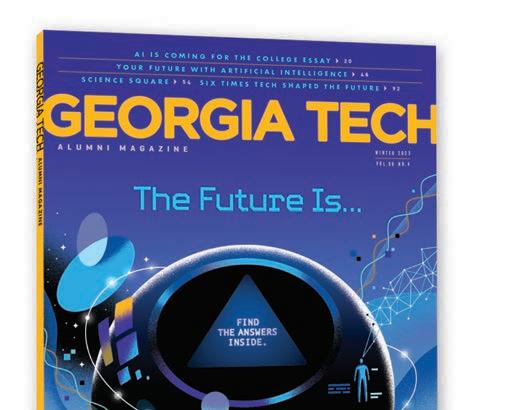

TECH STUDENTS IN WASHINGTON, D.C.
THANK YOU SO MUCH for the article describing GTDC (Winter 2023, Vol. 99, Issue 4). This is a big step toward bringing to bear the wisdom of Tech grads on the forming of good public policy. I took a career detour a while back and served as district staff director for Ben Jones, who represented Georgia’s Fourth Congressional District. (Ben, an actor, was probably better known for the part he played on The Dukes of Hazzard TV show. He was “Cooter.”) Forming good public policy is all about building relationships. GTDC will help Tech students and grads learn how to do that in the public arena. Thank you again for letting us know about this great project. —Jim “Joe” Watkins, IM 65, of Pawleys Island, S.C.
HAPPY BIRTHDAY, LEAP YEAR JACKETS!
THERE HAVE BEEN 120 Georgia Tech alumni born on Feb. 29. That’s 0.061% of all alumni and just below the national percentage of 0.068% of Americans born on Leap Day.
8 SPRING 2024 | GTALUMNI.ORG/MAGAZINE FEEDBACK
YELLOW JACKETS OUTSMART AI
WITH AN AVERAGE score of 3.21 out of 4, Yellow Jackets proved in our online AI quiz that they can’t be fooled by AI—yet! Here’s the answer to the question printed in last issue: Which is the real headshot of Pres. Cabrera?
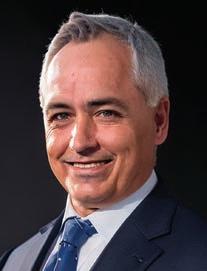

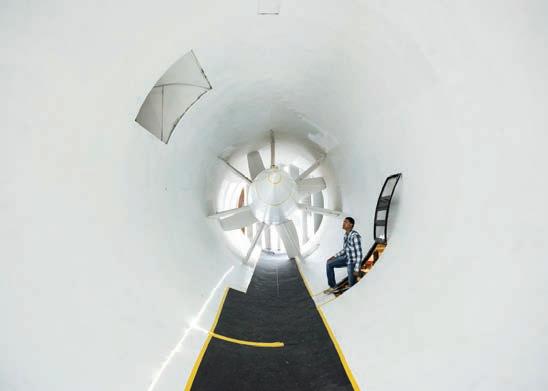


NEXT ISSUE: HIDDEN GEMS ON CAMPUS
What’s the place that you’ve heard about but never seen? Email editor@alumni.gatech.edu.










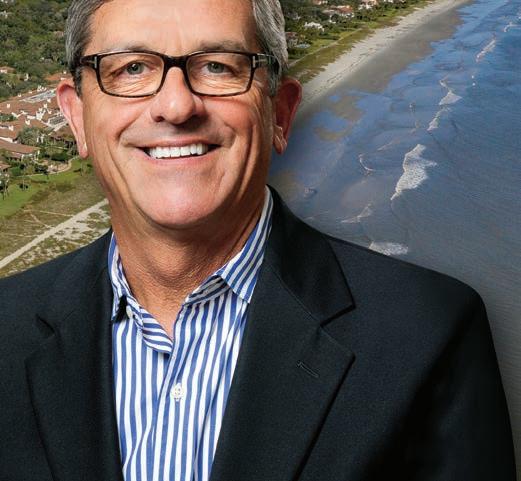
GTALUMNI.ORG/MAGAZINE | SPRING 2024 9
The wind tunnel inside the Daniel Guggenheim School of Aerospace Engineering. ROB FELT
AROUND CAMPUS
BIG SKIES
The Georgia Tech Observatory offers several public nights during the fall and spring semesters where everyday stargazers use a series of telescopes and see sights like the moon, Mars, and the Orion Nebula.


VOLUME 100 ISSUE 1 PHOTOGRAPH ROB FELT
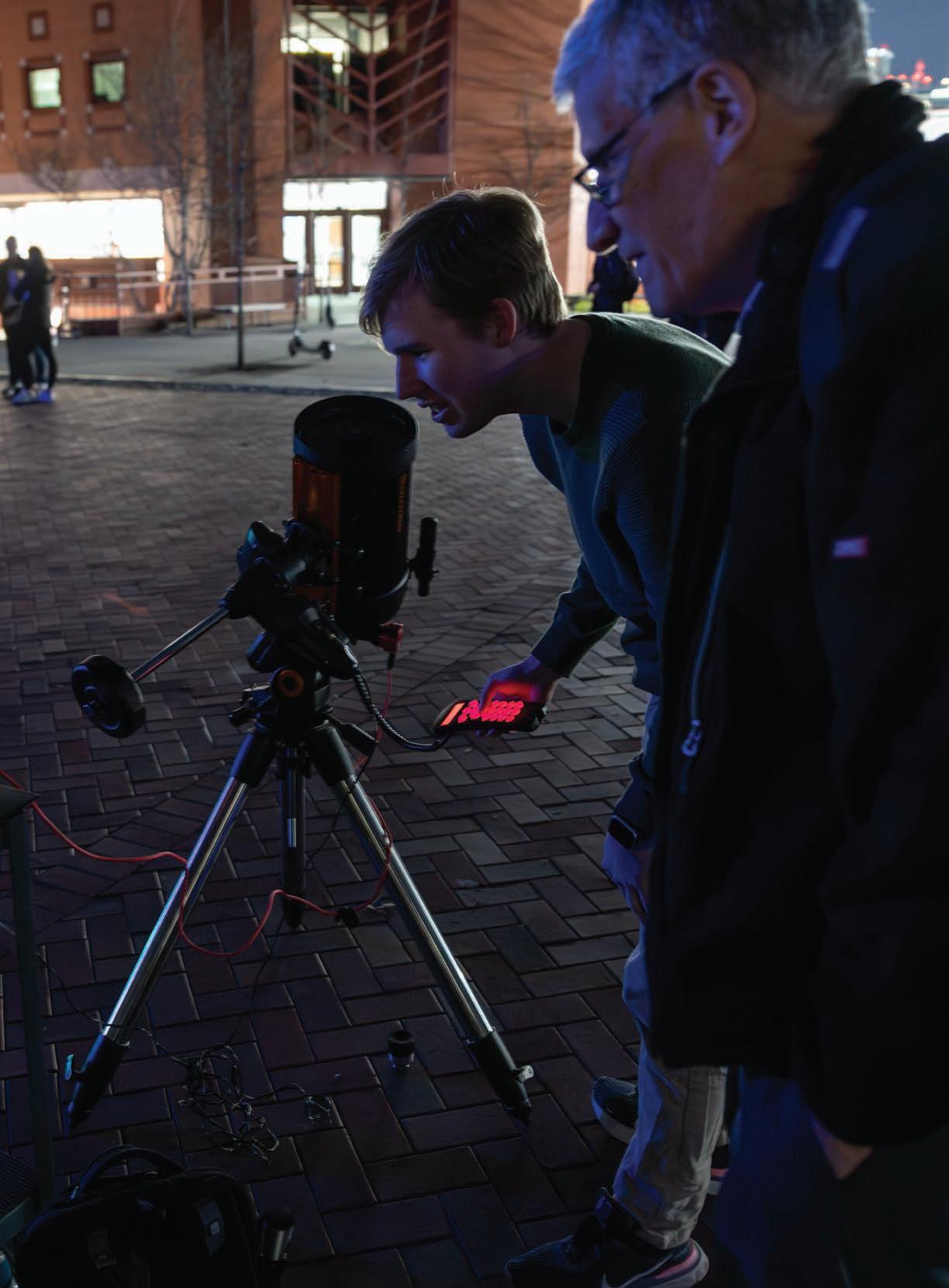

GTALUMNI.ORG/MAGAZINE | SPRING 2024 11
RECORD-BREAKING enrollment, the biggest contributor among University System of Georgia institutions to Georgia’s economy, over a billion dollars in research awards—it’s di cult to keep up with the rising numbers showing Georgia Tech’s outsized impact. We tried anyway. SEE



























































































































TALK OF TECH
BIG NUMBERS PHOTOGRAPHS GEORGIA TECH BEST VALUE PUBLIC UNIVERSITY, PRINCETON REVIEW JOBS CREATED 12 SPRING 2024 | GTALUMNI.ORG/MAGAZINE STATE ECONOMIC IMPACT (7.4% INCREASE FROM PRIOR YEAR)
OF UNDERGRADS ARE FROM GEORGIA $1.45 BILLION IN RESEARCH AWARDS PUBLIC UNIVERSITY, U.S. NEWS & WORLD REPORT # 1
ENROLLED IN FALL 2023 30, 283 $4.5 BILLION # 10
GEORGIA TECH’S IMPACT CONTINUE TO GROW. BY JENNIFER HERSEIM
62%
~48,000
JOIN 84,000 YELLOW JACKETS IN MAKING A BIG IMPACT FOR STUDENTS

Dear fellow Yellow Jackets,
When I rst arrived on campus, fresh o the plane from Spain, for my graduate education, I experienced plenty of culture shock. Everyone drove everywhere, fútbol looked di erent, and my psychology professor, Terry Maple, taught classes at the zoo with a silverback gorilla lounging behind him. Re ecting on Prof. Maple’s passing a few months ago, I thought about the lasting impact he made on his students—many of whom have gone on to transform the world of conservation and zookeeping.
Of all the things that caught my attention as an international student, I was particularly struck by the fundamental role of philanthropy in American culture. Our own beloved institution is the result of a group of business and community leaders in Georgia who dreamed of a technological university that had the power to transform the South. ey pooled their resources, championed the idea, persuaded friends and colleagues, appealed to elected o cials, and made the dream a reality. Today, the school they’ve created has become one of the most impressive technological institutions in the world.
Now it’s our turn.
Last year, we launched the most ambitious fundraising e ort in the Institute’s history— Transforming Tomorrow: The Campaign for Georgia Tech. Our goal is to raise over $2 billion by the end of 2027; I’m thrilled to share that we’re more than halfway there.
The campaign focuses on several key areas, the most crucial being support for students. Like you, I had the opportunity to come to Georgia Tech to solve problems, to be challenged, to learn from my failures, and to persevere. Like many of you, I did that thanks to a generous, life-changing scholarship. To uphold the Institute’s reputation for excellence, we need to ensure that any high-potential student can attend, regardless of their situation. Our campaign will provide access and opportunity to students so that we can build on the Institute’s reputation of producing the leaders who will shape the world for the better.
You can make a powerful impact—a big one—by joining over 84,000 fellow Yellow Jackets who have already pledged their support.
Visit transformingtomorrow.gatech.edu to learn more and contribute.
Go Jackets!
ÁNGEL CABRERA, MS PSY 93, PHD PSY 95 PRESIDENT, GEORGIA INSTITUTE OF TECHNOLOGY






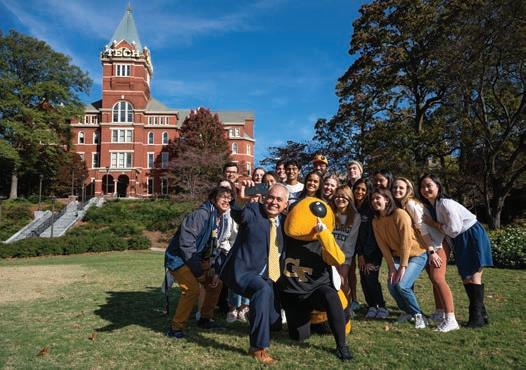
TRANSFORMING TOMORROW FOCUS AREAS
Transforming lives: Attract, retain, and inspire the brightest, most talented students from all backgrounds and places.
Transforming ideas: Advance innovation and entrepreneurship from research to student startups and makerspaces and recruit exceptional faculty and researchers.
Transforming learning:
Support students, faculty, and staff by expanding growth, well-being, and holistic learning through athletics, study abroad, leadership initiatives, and an inclusive campus.
Transforming our community and our world: Enhance our global campuses, lifelong learning platforms, K–12 programs, and dedication to sustainability and collaboration.
GTALUMNI.ORG/MAGAZINE | SPRING 2024 13 PRESIDENT CABRERA
BIG MOVES ON CAMPUS
THE NEW COMPREHENSIVE CAMPUS PLAN WILL GUIDE CAMPUS IMPROVEMENTS FOR THE NEXT 10 YEARS AND BEYOND.
BY CATHY BRIM

REOPENING OF THE THIRD STREET TUNNEL. A car-free campus core. An on-site water reuse facility. A new thermal energy plant. A North Avenue welcome center. Additional recreational elds. Two new residence halls. A new performing arts center. Peters Park instead of Peters Parking Deck. These are some of the exciting possibilities proposed in the 2023 Comprehensive Campus Plan (CCP).
After more than two years of preparation, intensive data collection, and analysis, the Planning, Design, and Construction department within Georgia Tech’s Infrastructure and Sustainability unit has nalized the new campus plan. Steeped in a rich culture of planning and innovation, the CCP is a living document that will guide how campus space will evolve to support the growing needs of the Georgia Tech community for the next 10-plus years.
Planning involved extensive in-person and virtual outreach efforts, which included students, faculty, staff, and alumni as well as external stakeholders such as neighborhood associations, churches, the Atlanta City Council, and Mayor Andre Dickens. The previous campus plan, issued almost 20 years ago, guided $2 billion in capital investment and laid the groundwork for several defining campus improvements, including the John Lewis Student Center, the EcoCommons, and the initial development of Tech Square. The new plan includes recommendations such as redeveloping surface parking lots near the Alumni House to create a major gateway to campus on North Avenue. The plan also suggests a mix of uses that support alumni and faculty activities, a new visitor welcome center, and student housing. e Comprehensive Campus Plan also aligns with the Institute’s Sustainability Next initiative and the newly released Climate Action Plan. Collectively these plans strive for a campus environment that is innovative, sustainable, and resilient.

14 SPRING 2024 | GTALUMNI.ORG/MAGAZINE
CAMPUS
AROUND


ARTS SQUARE
Arts Square, an adaptive reuse project planned for the site of the former Randall Brothers buildings, will be a destination space designed to explore the intersection of art and technology. Supporting education, research, and culture, Arts Square will help Georgia Tech engage with the state of Georgia’s multi-billion-dollar creative media industries.
NORTH AVENUE GATEWAY/ WELCOME CENTER
Gateways signify a special point of entry to a space that can either be physical, programmatic, or visual in nature. During research efforts, Georgia Tech community members expressed the need for a more pronounced entry experience on North Avenue to make the campus more welcoming, both physically and programmatically.
The campus land on either side of the Alumni House is currently occupied by parking. The CCP recommends the area be reimagined into a mix of uses that support alumni/faculty activities, a visitor welcome center, and potentially student housing.
PETERS PARK
The CCP recommends redeveloping Peters Parking Deck into Peters Park. By doing so, an important open space resource will be created to support the undergraduate and affinity group housing that surrounds it and an overall recreation resource for the campus. Integrating innovative stormwater management infrastructure to reduce campus stormwater runoff would be an essential component of this project.
WESTSIDE CONNECTIVITY BRIDGE
A pedestrian and micro-mobility bridge, designed by Georgia Tech students, would cross the train tracks and connect the heart of campus with Arts Square, Science Square, and the Westside community.
MARIETTA STREET CORRIDOR
An artist rendering of the CCP’s recommended concept for Peters Park, which would replace Peters Parking Deck. All renderings shown are subject to change.
This area represents a significant growth and redevelopment opportunity for campus with a focus on establishing more open space, serving the needs of athletics and recreation. The area between Ferst Drive and Northside Drive offers an opportunity to contribute additional green space to the campus, providing greater stormwater absorption and programmable athletic and recreation space, perhaps even an NCAA women’s soccer and/or field hockey facility.
GTALUMNI.ORG/MAGAZINE | SPRING 2024 15
Key components of the plan emphasize open space, sustainability, and multimodal access.
AROUND CAMPUS


ADDITIONALLY, THE NEW PLAN OUTLINES FIVE BIG IDEAS:
1
Harmonize With and Expand EcoCommons
The EcoCommons serves as a performance landscape, effectively and responsibly managing stormwater while also providing outdoor recreation space. The CCP encourages that the EcoCommons remain a key driver in shaping future development on campus.
PLANNING FOR TECH’S GROWTH
The new CCP addresses current campuswide goals and space needs, such as:
A 26% projected increase in on-campus students, faculty, and staff
An additional 2.2 million gross square feet of learning, research, and work space to accommodate growth
2,000 new beds for first-year students
Additional indoor recreation and outdoor recreational and athletic fields
A car-free campus core
Increase in the campus tree canopy
Increase in alternative mobility options
2
Densify the Core
The CCP recommends that Georgia Tech embrace its urban context by exploring vertical density with building heights surpassing five stories within a car-free campus core. Accommodating growth in this way amplifies activity in the heart of campus while reducing interactions between pedestrians, cyclists, and cars. Some surface parking in the core of campus is also reimagined as open green spaces, ideal for recreational use and stormwater management, similar to how the most recent portion of the EcoCommons occupies a former parking lot.
4
Connect Science Square, BioSciences, and Tech Square
Three distinct areas of innovation on campus—Science Square in the south, BioSciences in the north, and Tech Square in the east—share faculty, students, and researchers. The CCP recommends improving the connections through physical infrastructure, such as bridges, and through enhanced mobility.


3
Heal the Ridge
A topographical ridge exists on the west side of campus following Marietta Street, with stormwater runoff flowing north into the center of campus. The CCP recommends capturing stormwater on top of the ridge with a series of active and passive open spaces, fulfilling athletic and recreation needs. The ridge also physically divides the Georgia Tech campus from its neighbors to the west, a historically underserved area. Activating the ridge can stimulate this area for redevelopment.
5
Anchor Southwest Community Edge
Through thoughtful planned growth, the CCP recommends the development of the campus to the west by healing the ridge and establishing an anchor between campus and the surrounding community.



16 SPRING 2024 | GTALUMNI.ORG/MAGAZINE
This preliminary rendering shows Marietta Street.


Sponsor the Georgia Tech Alumni Association® Proud Sponsor the Georgia Tech Alumni Association®
Proud













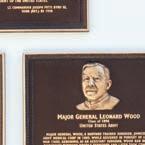



BIG COURAGE ON DISPLAY





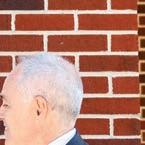






EXPLORE THE VETERANS WALK OF HONOR OUTSIDE THE VETERANS RESOURCE CENTER.
BY JENNIFER HERSEIM
OON JAN. 10 , Georgia Tech unveiled the Veterans Walk of Honor, continuing a deep history of supporting and honoring Yellow Jackets who have served their country.
The display recognizes the sacrifices made by veterans and symbolizes Tech’s enduring commitment to active-duty service members, veterans, and their families. Along the pathway leading to the Veterans Resource Center (VRC) near the BioTech Quad, you’ll see markers representing every branch of the U.S. military, each with its motto in Morse code. e display also features plaques honoring Tech’s Medal of Honor recipients (pictured above) and markers honoring alumni who have given their lives in the service of their country.
“Georgia Tech has a distinguished history of supporting active-duty veterans spanning over a century,”
Kim Harrington, interim associate vice president for Arts, Belonging, and Community, said at the unveiling ceremony.
Georgia Tech opened the VRC more than a decade ago, continuing a commitment that began in July of 1917 with the School of Military Aeronautics establishing training for veterans.
During the unveiling, David Ross, the VRC’s director, invited the community to explore the center’s work and reflect on Tech’s rich military history, as represented through the Veterans Walk of Honor.
In addition to Ross and Harrington, the ceremony featured speeches from Georgia Tech President Ángel Cabrera, MS Psy 93, PhD Psy 95, Mike Shannon, MS HP 03, PhD NRE 09, and President of Tech’s Student Veterans Association Michael Bauby.
The event opened with the Georgia Tech Glee Club singing the national anthem and concluded with a performance by the University of


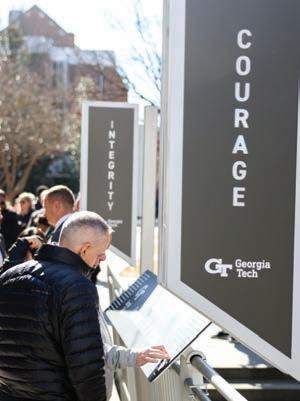
North Georgia ri e team.
Some of the plaques along the display were relocated from other spots across campus. One plaque honors war hero Lieutenant Commander Mercer McCall arpe, Cls 1926, who gave his life at the battle of Iwo Jima in 1945. Tharpe, a former player for Coach Alexander, was at one point an assistant football coach at Tech.
Another plaque, erected by the former members of Tech’s 1920–1943 track squads, pays tribute to their teammates who gave their lives in World War II.
Engraved above two columns of names the plaque’s inscription reads, “They finished their course with the torch of victory held high so that those that come a er may enjoy the fruits of democracy.”
18 SPRING 2024 | GTALUMNI.ORG/MAGAZINE
AROUND
CAMPUS
BIG MILESTONE A
CELEBRATING 10 YEARS OF IMPACT BY THE LGBTQIA RESOURCE CENTER.
BY MATT SOWELL
“AT THE TIME I started college, it would have been illegal for me to serve openly in the armed forces, illegal for me to marry, and illegal for me to adopt children,” says Steven Girardot, ChE 97, MS Chem 00, vice provost for Undergraduate Education at Georgia Tech. Despite the early ’90s being a time when the LGBTQIA community wasn’t prominently out on campus, Girardot was still able to find community as a student.
During his sophomore year, Girardot learned about the Gay and Lesbian Alliance (GALA), an organization on campus for LGBTQIA students to connect and have community. According to Girardot, GALA met in various classrooms around campus.
Today, Georgia Tech’s queer community has the LGBTQIA Resource Center, located in the Charles A. Smithgall Jr. Student Services Building. The center celebrates its 10-year anniversary this year. Tegra Myanna, the center’s director since 2020, looks back on the progress and impact the center has shepherded.
“I see our trans and nonbinary students out across campus at an institute heavily influenced by STEM culture, which research tells us is not
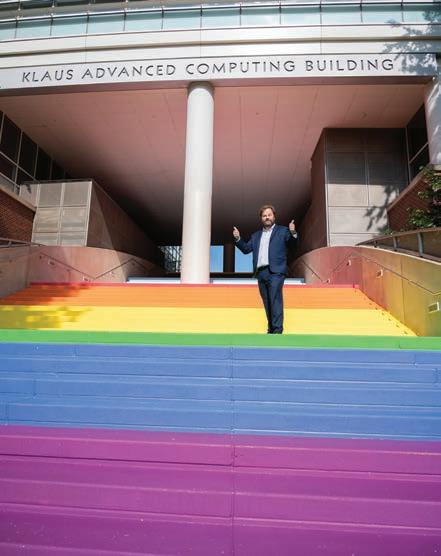
particularly inclusive of LGBTQIA researchers or educators. The resilience of our members and students who navigate what can feel like an unsupportive environment and going into industries that may not feel welcoming is pretty incredible,” says Myanna.
According to Myanna, the way the center has provided for the community has evolved over the years. The early work focused on making the queer community visible on campus, identifying allies across Georgia Tech to partner with for support, and working to enact policy changes that create a more welcoming culture.
One of those early policy changes spearheaded by the center’s former director, Aby Parsons, was to allow students to update their names. “[Parsons] worked with the registrar’s office and others on campus to be able to allow students to update their name from a legal name to a chosen name, so they could navigate Tech in ways that were affirming to them,” says Myanna.
The center also achieved Gender Inclusive Housing, which allows students to live with roommates of any gender. “It didn’t limit your housing selection,” Myanna says. “You could live with a best friend even if they happened to be another gender.”
Genny Kennedy, IA 20, who served
as the president of Pride Alliance from fall 2017 to spring 2020, says, “I found a rich, vibrant community through Pride Alliance and the Resource Center. From planning and attending weekly meetings to organizing Georgia Tech’s presence at the Atlanta Pride Parade for three years, I met so many folks from different backgrounds who I shared interests with.”
Kennedy explains that the hardwon inclusion of LGBTQIA students at Tech over the last 10 years has enabled the creation of displays like the Progress Pride Staircase located at the Klaus Advanced Computing Building. “I hope more students than ever feel celebrated for who they are. Georgia Tech is such a unique institution that attracts multi-talented students, faculty, and staff who can change the world,” says Kennedy.
Myanna says that Georgia Tech is special in the way it recognizes the work the LGBTQIA Resource Center does. “Georgia Tech has a very specific interest in improving the human condition. That comes with a recognition that our work, and who we are, matters.”
AROUND CAMPUS
GTALUMNI.ORG/MAGAZINE | SPRING 2024 19
Alumnus Chris Klaus stands in front of the Klaus Advanced Computing Building, which features the Progress Pride Staircase.
A new technology could allow for smaller and faster electronic devices and may have applications for quantum computing.

BIG BREAKTHROUGH
GEORGIA TECH RESEARCHERS HAVE CREATED THE WORLD’S FIRST SEMICONDUCTOR MADE FROM GRAPHENE.
BY CATHERINE BARZLER
HHERE’S ONE MORE worldrst that Yellow Jackets can claim with pride: the first functional semiconductor made from graphene, a single sheet of carbon atoms held together by the strongest bonds known. Semiconductors, which are materials that conduct electricity under specific conditions, are foundational components of electronic devices. e breakthrough throws open the door to a new way of doing electronics.
This discovery from a team of researchers at Georgia Tech comes at a time when silicon, the material from which nearly all modern electronics are made, is reaching its limit in the face of increasingly faster computing and smaller electronic devices.
Walter de Heer, Regents’ Professor of physics at Georgia Tech, led a team of researchers based in Atlanta and Tianjin, China, to produce a graphene semiconductor that is compatible with conventional microelectronics processing methods—a necessity for any viable alternative to silicon.
In this latest research, published in Nature , de Heer and his team overcame the paramount hurdle that has been plaguing graphene research for decades and the reason why many thought graphene electronics would never work. Known as the “band gap,” it is a crucial electronic property that allows semiconductors to switch on and off. Graphene didn’t have a band gap—until now.
Professor de Heer achieved a breakthrough when he and his team figured out how to grow graphene on
silicon-carbide wafers using special furnaces. They produced epitaxial graphene, which is a single layer that grows on a crystal face of the silicon carbide. The team found that when it was made properly, the epitaxial graphene chemically bonded to the silicon carbide and started to show semiconducting properties.
Over the next decade, they persisted in perfecting the material at Georgia Tech and later in collaboration with colleagues at the Tianjin International Center for Nanoparticles and Nanosystems at Tianjin University in China. De Heer founded the center in 2014 with Lei Ma, the center’s director and a co-author of the paper.
The team’s measurements showed that their graphene semiconductor has 10 times greater mobility than silicon. In other words, the electrons move with
20 SPRING 2024 | GTALUMNI.ORG/MAGAZINE
RESEARCH
“TO ME, THIS IS LIKE A WRIGHT BROTHERS MOMENT.”
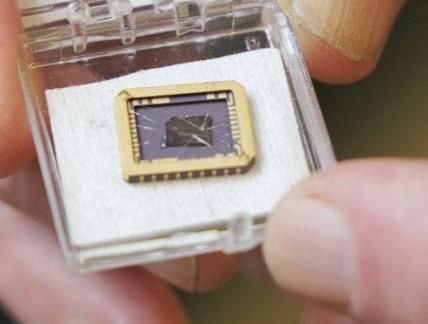
very low resistance, which, in electronics, translates to faster computing. “It’s like driving on a gravel road versus driving on a freeway,” de Heer says. “It’s more e cient, it doesn’t heat up as much, and it allows for higher speeds so that the electrons can move faster.”
e team’s product is currently the only two-dimensional semiconductor that has all the necessary properties to be used in nanoelectronics, and its electrical properties are far superior to any other 2D semiconductors in development.
Epitaxial graphene could cause a paradigm shift in the field of electronics and allow for completely new technologies that take advantage of its unique properties. The material allows the quantum mechanical wave
properties of electrons to be utilized, which is a requirement for quantum computing.
According to de Heer, it is not unusual to see yet another generation of electronics on its way. Before silicon, there were vacuum tubes, and before that, there were wires and telegraphs. Silicon is one of many steps in the history of electronics, and the next step could be graphene.
“To me, this is like a Wright Brothers moment,” de Heer says. “They built a plane that could fly 300 feet through the air. The skeptics asked why the world would need flight when it already had fast trains and boats. But they persisted, and it was the beginning of a technology that can take people across oceans.”
the
60 2%
BASELINE
Georgia Tech researchers have engineered one of the world’s first strains of light-powered yeast, and it grows 2% faster in the light than in the dark.
THE BIG PROBLEM:
Researchers have been searching for an alternative to silicon semiconductors to keep pace with faster, smaller electronics and computing. Graphene wasn’t a viable option because it didn’t have a “band gap,” which would allow it to be turned on and off like silicon.
THE EVEN BIGGER DISCOVERY:
By putting atoms on the graphene that “donate” electrons to the system, researchers created a band gap on the graphene without damaging its properties. The new graphene semiconductor has 10 times greater mobility than silicon.
3 HOURS MPH
Speed that a train can move through a new digital train inspection portal developed by the Georgia Tech Research Institute. Length of added time that people in lower socioeconomic tiers wait compared with other groups to have power restored after a major storm, according to a new study conducted by Tech researchers.
35
Number of times cheaper a new lightbased means of printing nano-sized metal structures developed by Tech researchers is compared with the current conventional method.
GTALUMNI.ORG/MAGAZINE | SPRING 2024 21
The graphene is grown on a silicon carbide substrate chip.
CLEAN, OLD FASHIONED HATE ON THE BRIDGE BOARD IN THEIR ANNUAL RIVALRY GAME, GEORGIA TECH’S BRIDGE CLUB BEAT UGA, SECURING A PIECE OF CAMPUS WITH THEIR WIN.

AS REIGNING North American champions, Georgia Tech’s Bridge Club beat the University of Georgia’s team in a tight match 79-73 for their annual rivalry game on Dec. 2, 2023. Along with the win, Tech also claimed a one-of-a-kind wooden trophy that was crafted using trees from both campuses. The unique trophy, which holds two decks of playing cards, stays in Atlanta until the next matchup.
JENNIFER HERSEIM

BIG THROW
THIS STUDENT MADE A LIFECHANGING THROW WORTH $100,000.
SIDDHARTH “SID” SURATIA never thought throwing a football would help him pay for college, but on Dec. 2, 2023—just one day a er his 20th birthday—he found himself on the eld of the Big Ten Football Championship Game with a chance to win $100,000 as a finalist in the Dr Pepper Tuition Giveaway.
The Georgia Tech aerospace engineering student was one of 15 nalists selected to compete in the Dr Pepper Tuition Giveaway to see who can throw the most footballs into a replica can in 30 seconds. “I remember telling myself, ‘ ere are only three things that exist in this moment: me, the football, and the target,’” says Suratia.
In true engineering form, Suratia had done his research prior to the competition. He reached out to prior winners to get their insights, designed his own target out of plywood (which his dad later perfected), used Spotify to play loud crowd noises as he developed his throwing rhythm, and made sure to get lots and lots of practice.
“I found out I was a finalist right

before Thanksgiving break, so the whole break I was focused on practicing. I would practice two to three hours every day and kept practicing until the nal competition day,” he says.
He and the other nalist had 30 seconds to throw 30 footballs from five yards away into a replica can with a 2-foot-diameter target. “I remember walking out on the field and then walking back into the tunnel. I don’t really remember what happened in between,” laughs Suratia.
e part he doesn’t remember is that he successfully threw 15 footballs into the target, narrowly beating runner-up Darcy Wonsick, who received $20,000 toward her dental school tuition.
Stunned, Suratia accepted his giant check and thanked the Dr Pepper company while millions of viewers watched.
“It still doesn’t feel real. I think it will take a few days for it to set in, but anytime I see the Dr Pepper logo or drink a Dr Pepper, I will always think of this trip and how I received one of the best birthday gi s.” KELSEY GULLEDGE
22 SPRING 2024 | GTALUMNI.ORG/MAGAZINE STUDENT NEWS
I FROM ARMY MEDIC TO NASA ‘SPACE PLUMBER’
COREY CRISOSTOMO SERVED AS A UNITED STATES ARMY MEDIC FOR SEVEN YEARS. DURING THAT TIME, HE CULTIVATED A LOVE FOR ENGINEERING THAT BROUGHT HIM TO GEORGIA TECH.
BY AMANDA BUDD
IN HIS SEVEN YEARS in the Army, Corey Crisostomo often found himself fiddling with medical devices and thinking about how designs could be improved for the medics to use more effectively.
“I remember being on medical calls and messing with the equipment,” says Crisostomo. “I’d be thinking, who designed this? It doesn’t do what we need it to. This was made by someone who only thinks they know what we do.”
So, when his time in the Army ended, Crisostomo was set on pursuing this newfound interest in engineering. He enrolled at Georgia Southern University to complete his core classes, but Georgia Tech was always his end goal for its reputation in the engineering field.
After a year, he transferred to Tech as a mechanical engineering major via the Veterans Transfer Pathway, a program that assists veterans who have completed active duty within the past five years to gain admission into Tech.
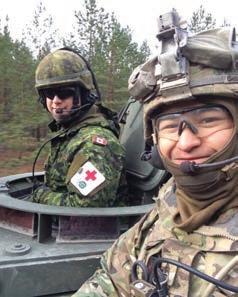
Crisostomo has now been at Tech for two years and rotates between semesters of classes and working as a NASA Pathways intern. In his role at NASA, he works as a cryogenics propulsion specialist on the Artemis Project, a job that others in the unit fondly describe as a “space plumber.”
“I make sure that all the valves and pumps involved with fuel delivery work correctly,” Crisostomo explains, “essentially making sure that fuel can get to the rocket’s engines so that it actually gets up into the air.”
The position has been enlightening for Crisostomo, especially when it comes to understanding the breadth of the field of engineering and where it can take him.

“I would love to help Army medics, and the more I think about it, the more I think I might want to follow that path,” he says, “whether that be with Army Medical Research or companies that interface with those products.”
Crisostomo also credits his experience in the Army with helping him tackle the academic rigor of his Tech coursework.
“My time in the Army gave me the ability to know that I can do hard things,” he says. “The military gives you a lot of soft skills that help you frame problems and have a system for approaching a solution. Also, it teaches you how to operate in nearly any environment.”
STUDENT NEWS
GTALUMNI.ORG/MAGAZINE | SPRING 2024 23
Left: Crisostomo during his time serving in the Army.
Top: With Pres. Cabrera at the Artemis Project site.
ON THE FIELD

VOLUME 100 ISSUE 1 PHOTOGRAPH DANNY KARNIK, EE 07, MS ECE 16
BIG VICTORY!
Claiming their first bowl since 2016, the Yellow Jackets beat the University of Central Florida 30-17 to win the 2023 Union Home Mortgage Gasparilla Bowl on Dec. 22, 2023.
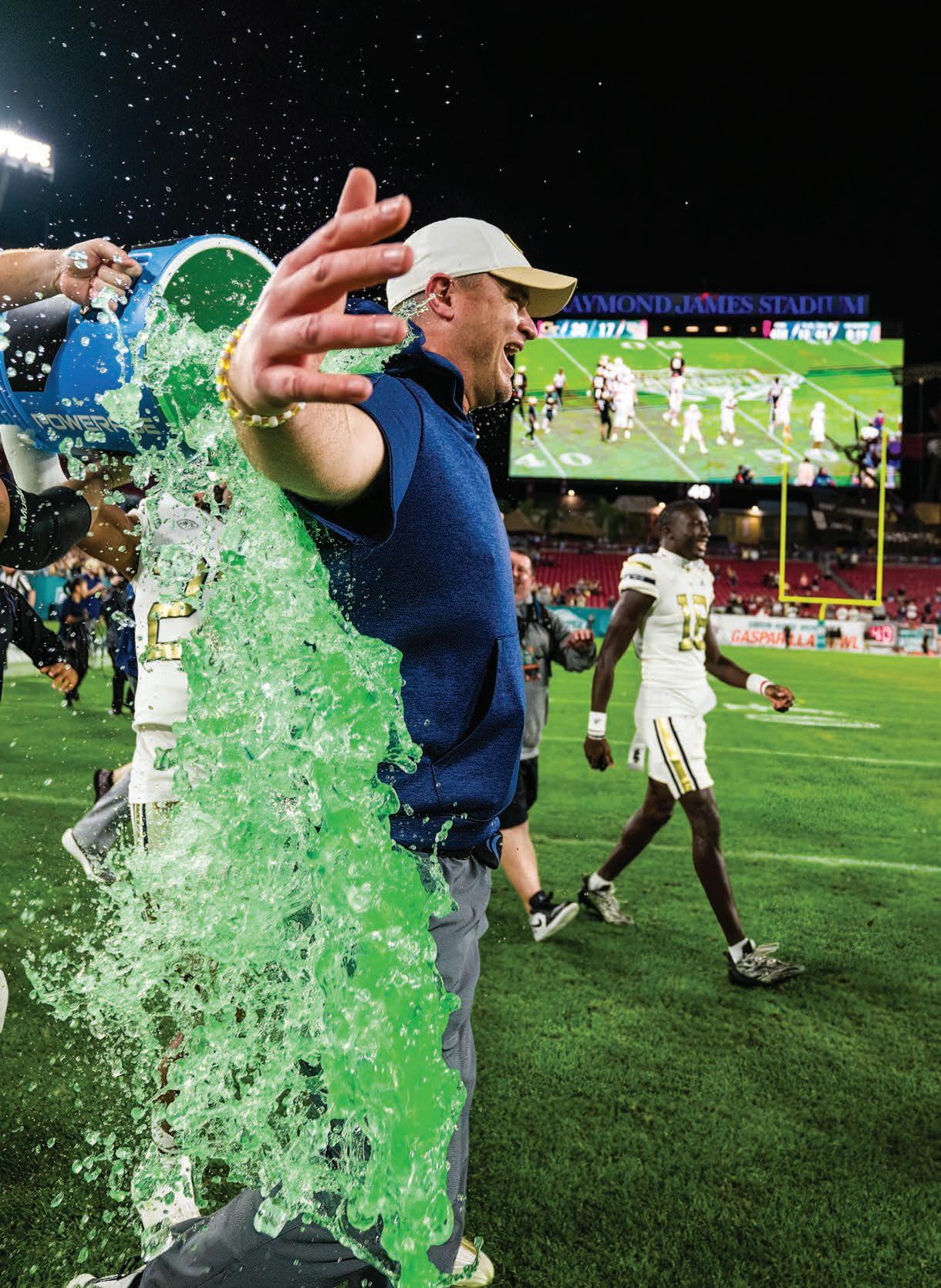

GTALUMNI.ORG/MAGAZINE | SPRING 2024 25

BIGHOOPS
THE NEW “TOP GOLF FOR BASKETBALL” IS THIS GEORGIA TECH GRAD’S SLAM-DUNK IDEA.
BY CHRIS QUIRK
PPAUL BROWN, MGT 08 , is a sports guy. “When we have Thanksgiving and Christmas, I’ll set up the croquet in the yard for family and friends,” he says. “I like something to do while we’re hanging out. It creates a second dimension beyond eating and drinking.”
Brown, who worked in consulting and finance for 14 years, is combining his expertise and love of good-natured rivalry in his first entrepreneurial venture, BigHoops.
BigHoops is an active basketball game created for a pub or arcade. Instead of the typical bar game where players lob free throws, BigHoops is engineered to level the playing field and provide
ON THE FIELD 26 SPRING 2024 | GTALUMNI.ORG/MAGAZINE
a little whiz-bang through technology. Players can set their own skill levels, and BigHoops adjusts accordingly to equalize the challenge. e basket moves, requiring players to hit shots from 8 to 21 feet away, the height of the basket varies, and the signature big hoop—which deploys for lesser-skilled players—is 23 inches in diameter, as opposed to a standard 18-inch rim. In addition, the setup has large video screens that mimic a basketball arena, or players can choose themed displays for birthdays or a futuristic look. ere’s nothing else out there quite like it, Brown says. “There are some basketball machines that move back and forth, but nothing that does it with any intelligence and has the exibility that ours has,” he says.
BigHoops is part of a new hybrid activity niche that Brown calls “competitive socializing,” a little something for people for whom watching a basketball game while partaking of onion rings and an IPA isn’t enough. “If you look at basketball, there’s around 150 million combined current players, previous players, and fans. at’s darned near half the country,” says Brown, explaining that these fans don’t have a lively game to take part in, such as Top Golf. “We call that ‘orphaned interest.’ ey might go to Dave & Buster’s to play some small ball, but there’s no real social interaction around it.”
While the goal is entertainment, Brown is a seasoned management consultant, and he performed extensive due diligence and research to test the viability of his idea, including nding ways to knock down barriers to entry as part of the process. Many of the performance levelers—like using an algorithm to decrease or increase difficulty for players during their turns—are meant to keep players involved. “If you start to miss something like four or five times, you’re going to lose interest,” he says.
Brown tested BigHoops by installing the homemade

prototype at the Second Self Beer Company—another company founded by Georgia Tech grads—in August of 2022. “I literally cut the metal and welded it, and my brother did the coding.” Once BigHoops was up and running, Brown reports that tra c at the brewery doubled, with BigHoops booked up to two weeks in advance. “We saw a certain pattern and called it the conversion. Someone might be unwilling to play, but once they made a few shots, they’d get that dopamine reward and they’d light up or start joking or trash-talking,” Brown says.
THE SIGNATURE BIG HOOP DEPLOYED FOR LESSER SKILLED PLAYERS IS 23 INCHES IN DIAMETER, COMPARED TO 18 INCHES.
The BigHoops venture was years in the making, with Brown working weekends on the project before taking it live, and despite the high failure rate for startups, Brown is quietly con dent. “It’s a simple concept. We know people like basketball. We’ve developed a tested solution, and we know that people go out and they pay for entertainment, food, and beverages.” He credits the drive he developed studying at Georgia Tech as being a catalyst to take the entrepreneurial leap. “You have to achieve there. It’s not a negotiation,” he says. “ at instills this little engine in you to look for progress and see how you can make an impact.”
Brown is now working to build a large space with 10 BigHoops units in Atlanta. “Our demographic is age 8 to 88. You could have a birthday party in there during the day, and we’ll lower the lights in the evening to create a lounge vibe for the nightlife scene.” e potential opening is November 2024.
GTALUMNI.ORG/MAGAZINE | SPRING 2024 27
PHOTOGRAPHS COURTESY OF PAUL BROWN
BIG RETURN
STAR ATHLETES RETURN TO GEORGIA TECH TO TAKE CARE OF UNFINISHED BUSINESS
BY MATT SOWELL
STUDENTS WHO graduate from Georgia Tech do so with proud stories of late-night study sessions, rigorous professors, challenging exams, and a high bar for success. For Dennis Scott, MBA 23, and Matt Wieters, BA 23, Tech’s reputation was a welcome challenge. Both athletes returned to Tech after successful careers on the court and field to complete their education. Read their stories and big takeaways from their time at Tech below.
DENNIS SCOTT, MBA 23
Before Dennis Scott walked across the stage to get his diploma, he was already a part of the Orlando Magic and Washington, D.C., Halls of Fame. His high school number, No. 24, was retired from the Flint Hill School in Oakton, Va. And though he was a member of the Georgia Tech Sports Hall of Fame, he had one un nished goal that still haunted him. “My mom would bring it up. If I was at a Tech game or talking about college basketball, it would come up. People would ask why No. 4 wasn’t in the ra ers. I’d tell them: Because I haven’t graduated,” says Scott.
Scott started his collegiate basketball career at Georgia Tech but le a er his junior year. “I was raised by a single mom, who pretty much did everything possible to provide and do things for me. I knew it was time for me to leave and provide for her,” he says. He celebrated a successful career in the NBA and after 16 years of working in television, his mom again inspired him. This time, it was to return to campus.


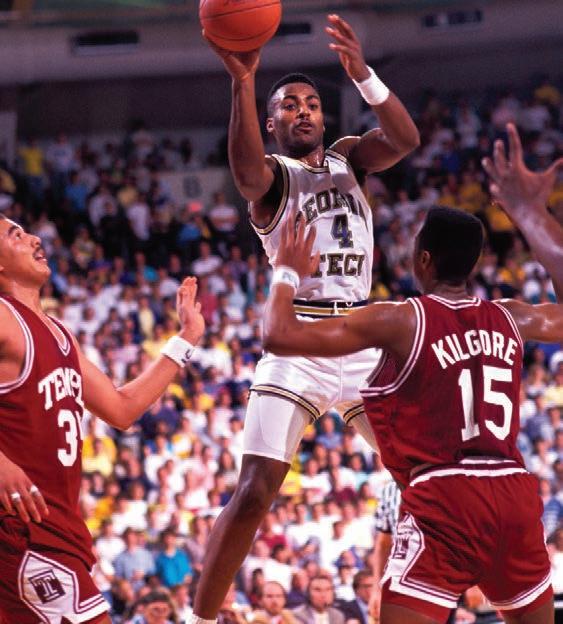


“She turned 80 years old and said, ‘Hey, you know, I’d like to see you graduate before I pass.’ And when your mom puts that type of pressure on you, you get back to work,” he says.
Scott credits Tech’s faculty for helping him finish his degree. Professors like Jonathan Clarke, senior associate dean for Strategic Initiatives and associate professor of finance in the Scheller College of Business, pushed him and allowed him to grow. “When I started, [Clarke] was like, ‘I’m gonna be hard on you, and I will push you because I know you can do it. And I want you to do it.’ And that was just pretty inspiring.”
The first few months of the program were tough. Scott says the transition from working professional to student was hard. In the end, it was worth it. “To put on a cap and gown actually made me feel young again. It took discipline to show up every Friday and Saturday for 18 months. It was surreal.”
Today, Scott’s number is eligible to hang in the rafters of the McCamish Pavilion, all because of his perseverance on campus.
28 SPRING 2024 | GTALUMNI.ORG/MAGAZINE
Dennis Scott receives his diploma, 33 years after leaving to pursue a professional basketball career.
ON THE FIELD

MATT WIETERS, BA 23
Matt Wieters arrived at Tech in 2004. He left three years later to pursue his dream of playing in Major League Baseball (MLB). “From the moment I got on campus, it has always felt like home,” says Wieters, whose career includes major milestones like being one of three players in Tech baseball history to become a two-time rst-team All-American and being the h overall pick of the MLB dra by the Baltimore Orioles.
He retired from baseball in 2020, and that’s when he started to feel Tech calling him. “Coach Hall was always so welcoming anytime I wanted to come on campus. Coming back was always a goal of mine, I just didn’t know when or how that was going to happen,” he says.

This time, Wieters arrived on campus with years of life experience that helped guide him toward his degree. He saw how applicable what he learned in class would be to real life. This didn’t make the classwork any easier, though. “Tech tests you in every facet. ere is no easy way to get through. You just have to work hard and be prepared the best you can,” he says.
Wieters joined the Georgia Tech baseball coaching sta in 2022 when he began working toward his degree. He explains that knowing he will be able to help young people navigate the world makes it worth it. “Being back in college helps me see what they are going through clearly,” he says.


WHAT I LEARNED
Returning to Tech teaches Yellow Jackets more than how to solve the problems of tomorrow. Dennis Scott shares some lessons he learned while working towards his degree as an adult:
Don’t take things for granted.
Scott traveled to South Africa while completing his MBA. While there, he saw power load shedding, which would cause the electricity to go out daily.
Be a sponge.
Accumulate knowledge and never stop learning.
Listen well.
Scott is naturally outgoing, but he says returning to Tech taught him how to listen well. “I’m more open to listening to the people around me who have ideas because I think we all have great ideas. Now I think about how to bring those ideas to life.”
Get your work done early.
“I should have gone to summer school every summer. I went once and it was my best overall year in the classroom and on the court. It gave me more focus,” says Scott.
Go deeper, think deeper, and stay outside the box.
“That’s what I took away from my marketing classes.”
It’s never too late.
“I’m 55. You get to a place where you’ve already made mistakes and you’ve already had failed businesses. You’ve already probably been fired once or twice, but you still stand on your two feet. You’re still eager to learn.”
GTALUMNI.ORG/MAGAZINE | SPRING 2024 29
Matt Wieters celebrates completing his degree program at winter Commencement with his family.
PAPAKOSTA
WINS GOLD IN HIGH JUMP AT ACC CHAMPS
SIX YELLOW JACKETS EARNED ALL ACC PLACEMENT.
THE GEORGIA TECH track and field teams had multiple impressive performances at the ACC Indoor Championships, held Feb. 22–24. Junior Shanty Papakosta placed first in the Women’s High Jump with a season-best of 1.83 meters (6 feet). This is her second year championing the women’s high jump. Along with Papakosta’s first team placement, five Yellow Jackets earned second team All ACC placement at the indoor championships: Ameia Wilson, 4th Women’s Long Jump; Eric Singleton Jr., 4th Men’s 60m; John Watkins, 5th Men’s Triple Jump; Anna Witherspoon, 6th Women’s 60m Hurdles; and Camille Trotman, 6th Women’s High Jump. At the end of the meet, the women finished 12th and the men finished 13th.

BUTKER MAKES HISTORY IN FOOTBALL’S BIGGEST GAME
YELLOW JACKETS HARRISON BUTKER AND JORDAN PONCHEZ MASON FACED OFF IN SUPER BOWL 58. BUTKER MADE HISTORY WITH A 57YARD FIELD GOAL.

FORMER YELLOW JACKET and Kansas City Chiefs kicker Harrison Butker etched his name in the NFL record book, kicking a 57-yard eld goal in Super Bowl 58—the longest eld goal in Super Bowl history.
Butker wasn’t the only former Yellow Jacket representing Georgia Tech in football’s biggest game. Facing off against the Chiefs, Jordan Ponchez Mason, BA 21, was a running back on the San Francisco 49ers.












Butker, who played at Georgia Tech from 2013 to 2016 and is the Yellow Jacket’s all-time scoring leader with 337 career points, kicked four field goals and scored 13 of the Chiefs’ 25 points in the Super Bowl. His record-breaking kick sailed through the uprights with just over ve minutes remaining in the third quarter, breaking the previous record of 55 yards, set just one quarter earlier by San Francisco 49ers kicker Jake Moody.
No stranger to setting records, Butker, now a three-time Super Bowl


champion, leads the school record of most Super Bowl wins, surpassing Tech alumni and two-time Super Bowl champs Bill Curry (Green Bay Packers and Baltimore Colts) and Shaq Mason (New England.) With four field goals and a pair of extra points, Butker has accounted for 37 points across his four Super Bowl appearances, trailing only 49ers wide receiver Jerry Rice’s 48. With his game-tying kick, the industrial engineering grad moved past Patriots kickers Adam Vinatieri and Stephen Gostkowski for the most career Super Bowl eld goals, with nine.
GEORGIA TECH ATHLETICS

GTALUMNI.ORG/MAGAZINE
SHORTS |
SPORTS
PHOTOGRAPHS COURTESY OF KANSAS CITY CHIEFS AND SAN FRANCISCO 49ERS

A Top-tier Degree for Driven Jackets





Earn your degree 100% online for total tuition under $10,000.
According to the 2023 Indeed Career Guide, employees with master’s degrees earned approximately 20% more than those with only a bachelor’s degree. And, they experienced an unemployment rate of just 2%!
Georgia Tech’s Online Master of Science in Analytics is a top-5 data science and analytics program that allows you to earn your M.S. in 24-36 months while working full-time.
Earn your master’s degree 100% online for total tuition under $10,000.
Now accepting applications for Fall 2024.
Online Master of Science in Analytics
•Top-5 nationally ranked program
•100% online and self-paced
•Complete in 24-36 months
•Same faculty and curriculum as on-campus program
•3 specialized tracks:
-Analytical Tools
-Business Analytics
-Computational Data
Analytics
•Total tuition under $10,000
•No GRE/GMAT required

“The OMS Analytics program gave me the opportunity to enhance what I was already doing and made my skills portable across a wider set of fields.”
Patrick Kriengsiri


omsanalytics.gatech.edu

IN THE WORLD
VOLUME 100 ISSUE 1 PHOTOGRAPH SCOTT DINERMAN, STC 03
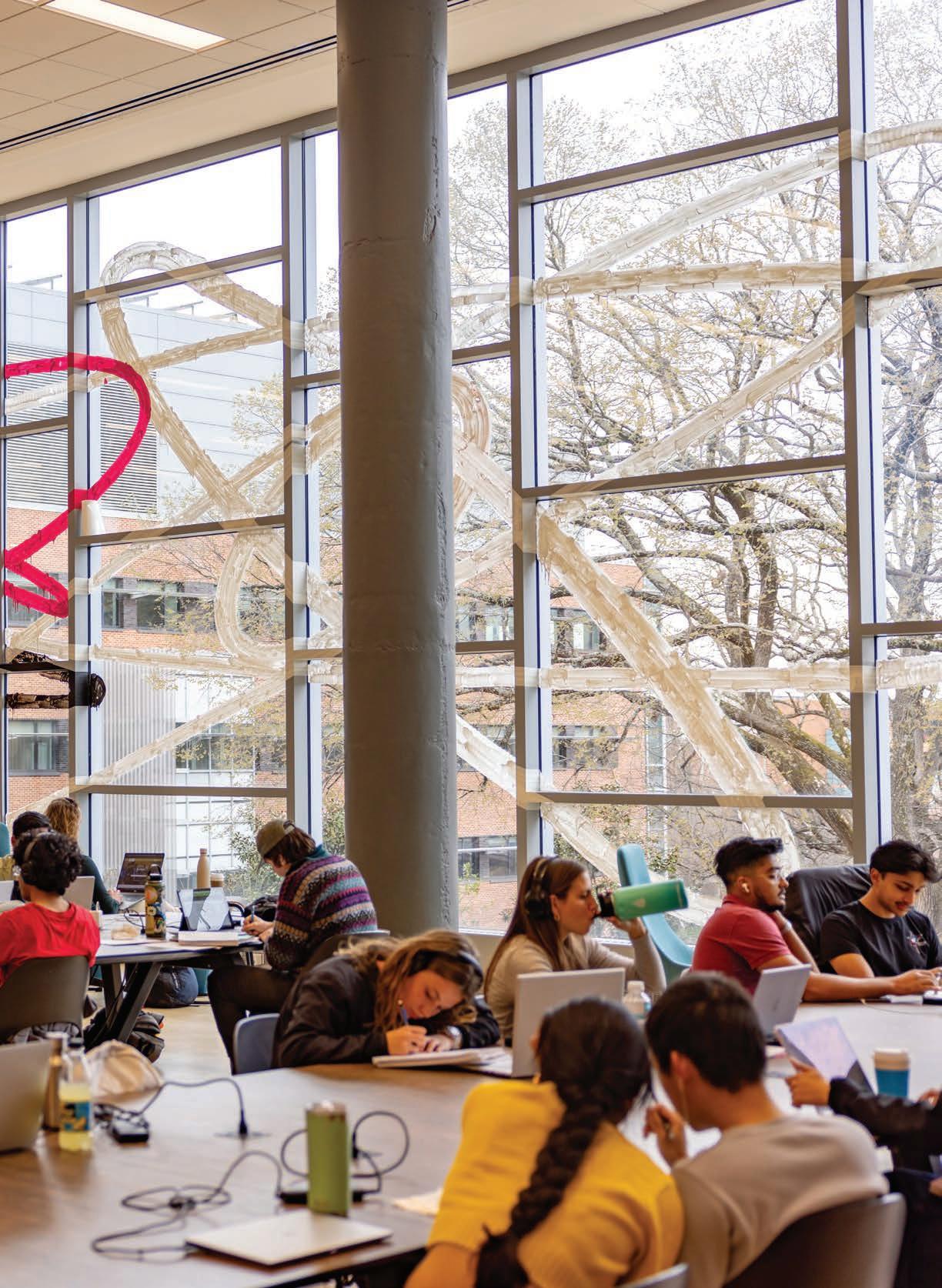
MASSIVE MURAL
A graffiti-painting robot is bringing color to the first and second floors of Price Gilbert Library. Artist-in-residence Tristan Al-Haddad is working with PhD student Gerry Chen to install the mural using a robot that mimics human-style painting.
THE GIGANTIC ART SPACE WHERE EUCLID, GALILEO, AND A ROBOT MEET
POLYCENTRIC TRUTHES AT THE PRICE
GILBERT MEMORIAL LIBRARY IS THE BRAINCHILD OF ARTISTINRESIDENCE AND TECH ALUMNUS TRISTAN ALHADDAD.
BY JASON WRIGHT
TTHERE IS AN extra buzz on Wednesdays and Thursdays in the rst- oor reading room of Price Gilbert Memorial Library. A literal buzz, plus some whirrs and clanks, emanating from a small, oddly shaped box as it scours the oor-to-ceiling windows that overlook the Hinman Building and the College of Design.
Back and forth goes the box, controlled by four tethering cords, with its small, articulated arm trailing behind a swath of black, white, or bright magenta paint. It is known as the human-style painting robot, and it is creating, two days at a time, a massive mural called Polycentric Truthes
The brainchild of Library Artistin-Residence Tristan Al-Haddad, Arch 01, M Arch 06, with help from the robot’s creator, PhD student Gerry Chen, the mural was created from
Tech should be a very unique type of inquiry,” says Al-Haddad. “It should be an exploration at the intersection of art and technology such that it is speci c to the culture of the place.”
e new mural, which is an interpretation of Galileo’s Dialogue Concerning the Two Chief World Systems, unfolds as a massive expressive diagram on the building. e piece speaks to what the philosopher Nelson Goodman called “Irrealism” or “Worldmaking,” says Al-Haddad.
“ ree systems, three worlds, three realities, all using identical elliptical geometries, create sameness and difference simultaneously, ” says Al-Haddad.

January to early February and is now on display.
Polycentric Truthes complements Watermark, another massive installation by first Artist-in-Residence Deanna Sirlin, which currently bathes the Grove Level of Crosland Tower in colorful light.
(See the installation on page 6.)
“An artist residency at Georgia
For Chen, being able to use the robot in a novel indoor setting—with a complex network of inset windows—has been a learning opportunity.
“It’s been a really amazing and unique experience to take my research from the lab and bring it into Price Gilbert,” says Chen, who studies in the School of Interactive Computing. “There have been a lot of unforeseen challenges, but that’s just part of the artistic and learning process at a research institution. ere have been so many things I couldn’t possibly have learned without taking this technology into the real world.”
In January 2023, the Library partnered with Al-Haddad, a former Tech assistant professor and double Jacket, for the second installment of its Artist-In-Residence program.
34 SPRING 2024 | GTALUMNI.ORG/MAGAZINE PHOTOGRAPHS CHRISTA ERNST
BIG ART

program. Polycentric Truthes is the culmination of the program and drew from student work in three workshops throughout March and April 2023.
ese included a “RoboGra ti” technical workshop, a reading discussion and sketching session, and a live drawing party to close out the semester.
In the sessions, students read portions of Euclid’s Elements and Galileo’s seminal work as “provocations” to get their creativity flowing. From there,
they drew and sketched ideas that were eventually translated into the robot’s gestural painting style.
Al-Haddad, who also designed and implemented the Library’s seventhfloor roof terrace Crosland Chroma project, says Polycentric Truthes represents more than a year of research and exploration and the convergence of robotic technology and conceptual design. e merger of art, science, and engineering perfectly encapsulates
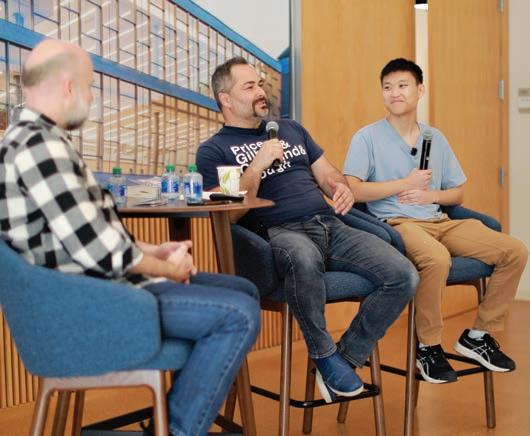
the type of exciting work that can be realized through multi-disciplinary research and design projects at Georgia Tech, he says.
“Prior to the specialization that occurred during the Industrial Revolution, artists were engineers, architects were master builders, and geometers ran the military… I think we need more blurring of the lines,” he says. “I recommend we all practice squinting from time to time.”
MEET THE ARTISTS
Alumnus & Artist-in-Residence TRISTAN ALHADDAD (pictured center) is a multi-medium designer and visual artist in addition to previously holding the position of assistant professor in the School of Architecture at Georgia Tech. He leads Atlanta-based Formations Studio.
GERRY CHEN (pictured right) is a PhD student at Georgia Tech, where he studies artist-robot collaboration to understand how robots can superpower artists and how art can drive technology. After completing his undergraduate at Duke, Chen continued his studies at Georgia Tech’s Institute for Robotics and Intelligent Machines (IRIM) PhD program in the School of Interactive Computing under Professors Frank Dellaert and Seth Hutchinson.
GTALUMNI.ORG/MAGAZINE | SPRING 2024 35
MICAH TOBLER
FROM THE BOOKSHELVES
EXPLORE THE LATEST PUBLISHED WORKS FROM GEORGIA TECH ALUMNI.




LEST SHE FORGET
LISA MALICE, MS PSY 89, PHD PSY 92
Haunted by a forgotten past. Hunted by a ruthless killer. No one to save her but herself. After surviving a car crash, Kay Smith wakes from a coma with amnesia, a battered face, and no one to vouch for her identity. Her psychiatrist is convinced that her memory loss is connected to the horrific flashbacks and nightmares haunting her. As she digs for clues to her past, Kay uncovers a shady character following her every inquiry. Who is he? And what does he want from her? As Kay probes deeper, she realizes that everyone around her has deadly secrets to hide, even her. Emerging memories, guilty suspicions, and headline-screaming murders push Kay to come out of the shadows and choose: Will she perpetuate a horrendous lie or risk her life to uncover the truth?


THE AMERICAN UNITY PLAN ALAN NAGER, IE 82
Nager proposes bold and bipartisan solutions to address critical issues such as the social safety net, immigration, climate defense, taxation, inflation, and the federal budget. This comprehensive plan offers a uniquely American roadmap for long-term success, bridging political divides with innovative ideas.


L
IS FOR LEADERSHIP SCOTT STEINBERG, MGT 99
How can you teach future leaders to thrive in tomorrow’s uncertain business world—and which new business and technology trends, from AI to Web 3.0, emerging future of work strategies, and cutting-edge innovations, will define it? In this hand-illustrated children’s book for young leaders, world-renowned futurist keynote speaker and leadership expert Scott Steinberg explains. The volume provides an A to Z look at the core values, strategic principles, and advancements that every leader, young and old alike, should now be embracing.
AI FOR DEFENSE AND INTELLIGENCE
PATRICK T. BILTGEN, AE 03, MS AE 04, PHD AE 07
In this modern context, the recent strides in artificial intelligence and machine learning are viewed through the lens of national security missions. Biltgen, a principal at Booz Allen, has been crafting data analytics systems for the defense sector since earning his doctorate in 2007. His initial publication on activity-based intelligence is integrated into training for allied intelligence agencies and the U.S. Air Force.


POETRY [ DEAR LO BRADY (BOVE) MUÑOZ, BME 21
Dear Lo captures the difficulty and raw emotion of moving to a new place and struggling to form meaningful relationships. Highlighting the change of mindset needed to confront loneliness, find peace, and continue putting yourself out there, Muñoz delivers a personal series of modern epistles, like prayers in the dark. But being alone, she ultimately discovers, does not have to mean being lonely.
36 SPRING 2024 | GTALUMNI.ORG/MAGAZINE BIG TITLES
MYSTERY THRILLER
PUBLIC POLICY
CHILDREN’S BOOK
ARTIFICIAL INTELLIGENCE


from 5 years ago are no longer relevant.*






Is your career positioned to thrive in times of change?

We offer programs in high-demand subject areas such as data science and analytics, safety and health, cybersecurity, project management, and more to help working professionals keep pace with ever-changing market forces and business demands. *
https://learn.pe.gatech.edu/gtpe
37% of workplace skills
Shifting
and Remaking the
2022, Boston Consulting Group (BCG), Emsi Burning Glass, and The Burning Glass Institute
Skills, Moving Targets,
Workforce,
On-Site Online

ADVENTURE BIG

Remembering t he
Ramblin'RAFT RACE Ramblin'
RAFT RACE





 BY KRISTIN BAIRD RATTINI
BY KRISTIN BAIRD RATTINI

Founded by Tech students, this epic oating party made history—and countless cherished memories—on the Chattahoochee River in the 1970s.

IIt was dubbed “Woodstock on the Water” and “ e Rose Bowl on the River.” But the event that drew hundreds of thousands of people to a 9.2-mile stretch of the Chattahoochee River north of Atlanta every third Saturday of May in the 1970s was better known as the Ramblin’ Ra Race.
Larry Patrick, Text 73, the race’s larger-than-life founder, preferred to think of this immense oating party (the country’s biggest) as “the greatest adventure since the ark.” That crazy adventure, run by Tech students and
alumni, lives on in the memories of countless Tech graduates and changed the course of the Hooch’s history.
FROM WHIM TO SPECTACLE
Just how grand of a spectacle was the Ramblin’ Ra Race? In 1978, Guinness World Records declared it the largest participatory sporting event in the world. e next year, the race hit its peak, with more than 400,000 spectators and 70,000 participants oating on inner tubes or on wildly creative contraptions of varying degrees
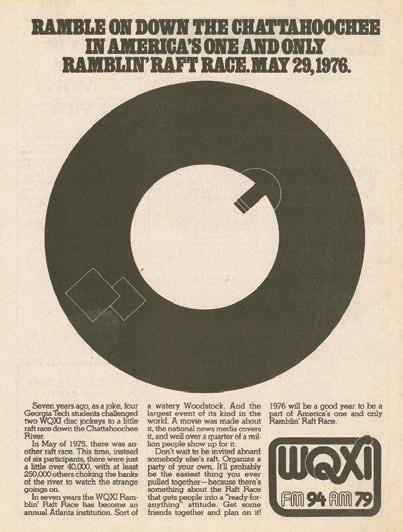


WQXI radio station was an early partner, eventually taking over the raft race in 1980 before it was shut down.
40 SPRING 2024 | GTALUMNI.ORG/MAGAZINE

The race drew 400,000 spectators during its peak in the late ‘70s.
of seaworthiness. “The number of people was incredible,” says Deborah Staudinger, CE 78. “It was a day for young people in Atlanta from every walk of life to have fun on the river.
Everyone was welcome.”
This juggernaut started a decade earlier on a whim, really, something fun that Patrick dreamed up to do with his Delta Sigma Phi fraternity brothers who were bored on campus during the summer of 1969. He called WQXI radio station and challenged the DJs, on the air, to a ra race on the Chattahoochee. More than 50 participants and around 2,500 spectators showed up for the inaugural event in July 1969, a grueling 34-mile race that lasted about 30 hours.
“Nobody quit talking about it,” Larry Patrick said in a Living History
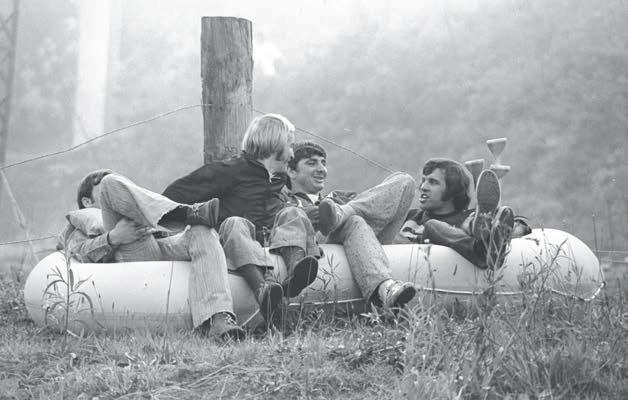
interview in 2013, two years before his death. “You started to hear, ‘Next year, next year.’” Patrick recognized the potential to make the race something bigger—much, much bigger.
“Larry was a combination of P.T. Barnum and Walt Disney,” says Gil
Patrick, Text 77, his younger brother and right-hand man on running the race. “He was full of imaginative, grandiose ideas and plans and a true showman.” Gil was widely regarded as the Roy Disney to Larry’s Walt, the man who made the dreams a reality.
GTALUMNI.ORG/MAGAZINE | SPRING 2024 41
Soon after its start in 1969, the raft race became an annual Atlanta tradition.
“Larry was the visionary; Gilbert was the backbone,” says Mike Knaszak, ME 81. “Gilbert made it work.”
LAYING THE FOUNDATION FOR “THIS INSANE RACE”
e 1970 race set the template, tone, and momentum for nearly all that followed. A new, much-shorter course ran 9.2 miles from below the Morgan Falls Dam to Paces Ferry, providing spectators an easier route to gather along. In addition to WQXI as a race partner, the Coca-Cola Company signed on as one of the first of what would become many corporate sponsors. New race classes were created for homemade rafts to encourage creativity, if not necessarily engineering prowess. And while the event was technically a race, it was truly all about fun. Even the paddle awarded to winners in later years acknowledged it, congratulating victors for the “bravery, perseverance, sportsmanship, and whatever else was needed to win this insane race.”
Larry’s fraternity brothers fully

embraced that philosophy of fun. Delta Sigma Phi’s ra in 1970 was e Chattahoochee Queen, a 34-foot-long tri-deck pirate ship that was beautiful in form but short on function; it sank 2 miles shy of the nish line.
Larry assigned Ron Edwards, IM 70, and other fraternity brothers to fire a pair of cannons—one homemade, one on loan from a confederate Civil War reenactor group—from opposite blu s 150 feet above the river to greet the 1,066 ra s with showers of confetti.
Edwards and his two co-gunners on the Civil War cannon, all decked out in pirate garb, wanted a much bigger bang for their efforts. So they increased the powder and added a softball-sized wad of wet newspaper on top of dry paper to capture and compress the sound.

“As the next group of rafters rounded the bend, we red ‘ol’ Betsy,’” Edwards remembers.
“ e roar of the cannon was indeed louder, and its concussion resonated
strongly across the waters. But most surprisingly and terrifying to both cannon crew and ra ers was the sight of an approximately two-pound wad of paper ying across the river at great speed and impacting the far-side bank. e cannon crew had just created the greatest spitball of all time.”
ALL HANDS ON DECK
An event of such magnitude required as many hands on deck as possible. Over the years, Larry and Gil recruited all across the Tech campus, especially among other textiles majors. Charley Cheney, Text 72, even earned three industrial and systems engineering credit hours for his race work. “Any course you could ace outside of your major or the ‘weed out’ courses was always a bonus,” he says.
The Patricks enlisted their Delta Sigma Phi and Pi Kappa Alpha brothers, fellow members of the Ramblin’ Reck Club, ROTC members, and members of the GT wrestling team along with residents of Eastgate, the private dorm that Larry managed and which served as race HQ for several years. Volunteers pitched tents, heaved ra s out of the water, stamped timecards, helped locate lost people
42 SPRING 2024 | GTALUMNI.ORG/MAGAZINE
Founder Larry Patrick presented a paddle to the winning team.
Decked in pirate garb, Delta Sigma Phi fraternity brothers fired a cannon across the river.
of the race and share your own at gtalumni.org/RaftRace.

and possessions, and spent two to three weeks a er the race—the weeks leading up to nal exams—cleaning debris and sunken ra s from the river. “It was amazing the things you could get people to do for a free T-shirt or a case of beer,” says Tom Robertson, IM 76.
In 1971 the race mushroomed far beyond what the volunteer sta had anticipated. Gil Patrick and two other crew members “borrowed” a nearby bulldozer to level out the finish line for an easier exit for the 4,700 rafts that came from as far away as Michigan and Canada and for those ra ers whose levels of sobriety and clothing had diminished along the route. Tra c around town ground to a halt as 180,000 spectators packed in to party along the Hooch. “Atlanta was
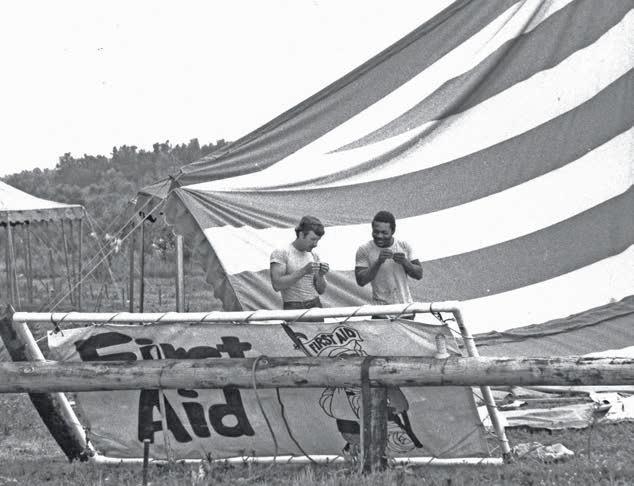
a growing town,” says Orvin Holland, TE 77. “It was beginning to flex its muscles as the capital of the South. e ra race grew along with that.” City o cials and the Department of Natural Resources decried the chaos and threatened to cancel the
race. Larry Patrick and team sprang into action. He established the nonpro t American Ra ing Association (ARA), in order to accept donations and to promote and advance recreational river activities. He ampli ed his message of the Chattahoochee’s
GTALUMNI.ORG/MAGAZINE | SPRING 2024 43
READ MORE MEMORIES
The environmental impact of the race brought awareness of the need for river protections.
Volunteers from Georgia Tech and the community helped staff the event.

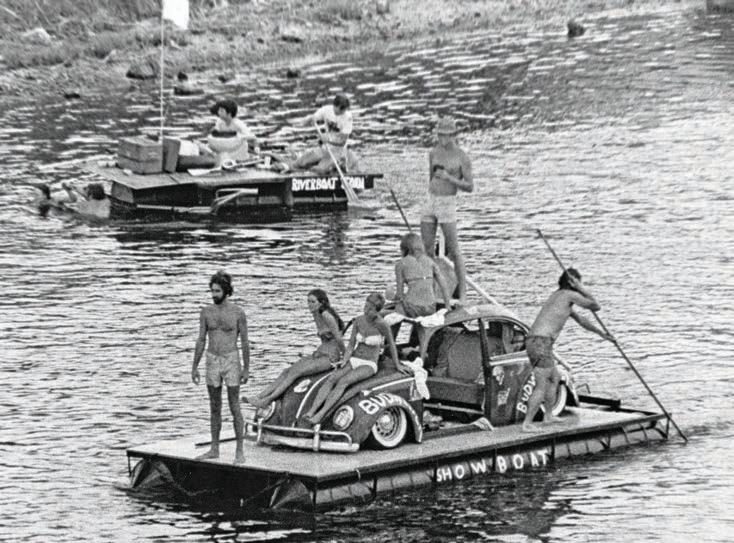
importance as a vital natural resource, one under direct threat from Atlanta’s rapid development. And he recruited Jim Underwood, IE 72, to develop the necessary transit and parking systems to make the race run more safely and smoothly.
“Larry’s energy and enthusiasm about the race was infectious,” Underwood says. “We were a bunch of kids in school, talking to fairly important people and convincing them that we had what it takes, as a group, to create a structure and plan that would work
for such a big event.”
Underwood spent the 1972 race not among the fun and frivolity of the crowds but in a metal trailer under the power lines at the Morgan Falls dam. “Every time you touched the door, you got a shock,” he says. From there, he managed tra c control via walkie-talkie, transporting ra ers on MARTA buses between the Lockheed parking lot and the starting and nish lines. It was a successful system that
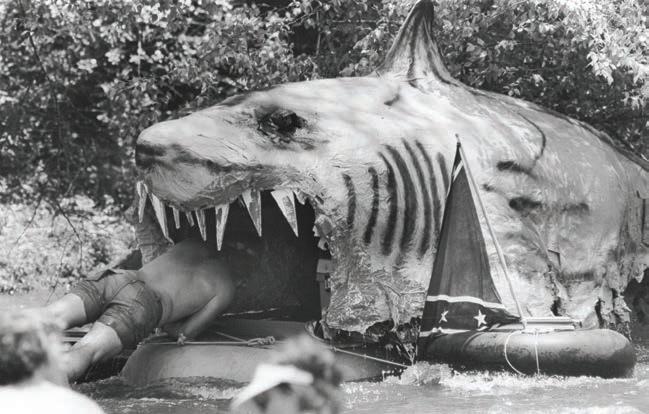
stood for every race after. “We took what had been a disastrous year in 1971 and made it into a success that allowed the race to go on for years to come,” he says.
FULL-SCALE FUN
Each year after, the Ramblin’ Raft Race grew into an ever larger and grander spectacle. Hot-air balloons floated above the river. AnheuserBusch became a major sponsor and sold more beer at the race than at any other event it underwrote at the time. Concerts by Charlie Daniels and Mother’s Finest drew in larger crowds. Playboy’s 25th Anniversary

44 SPRING 2024 | GTALUMNI.ORG/MAGAZINE
Organizers worked with local officials to make the race run smoothly.
New race categories were added for homemade rafts to encourage creativity and fun.
Homemade vessels of varying degrees of seaworthiness stood out among the tubes floating down the Chattahoochee.

playmate Candy Loving attracted a crowd of her own when she attended the race. Several couples even got married on the river during the race.
National media outlets from Sports Illustrated to CBS News covered the event. e race was memorialized in the movie The Great American Raft Race! It even had its own song. “ e Ballad of the Chattahoochee Ramblin’ Ra Race,” written by the ARA’s promotions and campaign manager Tom Freeman, catalogued some of the creative cra s on the water:
beds and cots all oatin’ like yachts/ ra s with rails and bedsheet sails/ pontoons, rowboats, sternwheel paddlers/ Viking, slowboats, bicycle straddlers. ere were even crazier entries in the race’s armada over the years: a full-sized replica of a 53-foot tractor trailer, an airplane, Luke Skywalker’s cruiser from Star Wars, the Monitor and Merrimack Civil War battleships. There were floating pianos, Volkswagens, tropical islands, bathtubs, coffins, even a Jaws-inspired shark. And in between them, “enough inner tubes lashed together to supply every citizen in Atlanta with a new tube,” says Gil Patrick.
Through the ARA, the Patrick Brothers and several paid crew members took the ra race concept on the road to nearly a dozen cities, ranging from Tampa to Washington, D.C., to New Orleans. Knaszak earned three years of co-op credit for that work and was one of several ARA team members bestowed the designation of “Kentucky Colonel” from the Bluegrass State’s governor for their work on the Louisville race. “ ere was tremendous camaraderie working on the races,” Knaszak says.
Scott Shipley, ME 01, MS ME 02, is a veteran of three Olympic games and holder of four world titles. When he’s not riding the rapids, he’s the president of S₂O, now part of Calibre Engineering, a global leader in whitewater park design.

HOW TO SAFELY “SHOOT THE HOOCH” – OR ANY RIVER – FROM AN OLYMPIC KAYAKER







Here are Shipley’s best tips for enjoying your time on the water:
Know the first rule. Always wear a life jacket or personal flotation device (PFD) when you are on the water, no matter how experienced you are. It also helps to have safe and reliable equipment for the task at hand!
Make a plan. Recall that James Dickey, the author of Deliverance, was once Georgia Tech’s poet laureate. James Dickey would recommend being prepared. Check online for commonly floated sections of the river, pick a put-in and a take-out that are a reasonable distance apart (4 miles is a long float on the “Hooch”—I wouldn’t go longer), read the signs when you put in, and watch for warning signs on the river.
Know the river and its levels. The Hooch goes up and down quite a bit with flow rates and it is best to check to make sure you are going on a day that has reasonable flows and to avoid the high, flooded water. As a rule of thumb, you’ll see rocky shoals anytime you put in on the Hooch. If you are looking at brown water with no rocks—the water is up and you should wait for another day!
Go when it is warm. A float trip is never fun on a cold day, and should something go wrong, the cold is going to make a bad bit of luck into a terrible bit of luck. Best to go on sunny days.
Avoid danger. Make sure you are capable of floating the section you are on. Know that logs are likely the most dangerous thing you see on the river. As a three-time Olympian, I paddle to the other side of the river when I see them—you should, too. Think about how stuck that spaghetti is in the strainer and imagine it was you…
Go with a group and tell others where you went. Rely on the buddy system for this one and, if you can, leave a paper trail. Leaving a sheet of paper in your dash saying when you put in and where you are going can help. Worst case scenario is that, if you are uncomfortable with the river or something happens, you just have to pull over and wait for the cavalry.
Wear sunscreen and have fun. For all the serious stuff in these tips, just know that you are enjoying Atlanta’s greatest natural resource. It is beautiful, fun, challenging, and fulfilling. Put on a little sunscreen, spend some time with friends, and enjoy your day!
P.s., for goodness’ sake, don’t drink the water! —Scott Shipley
GTALUMNI.ORG/MAGAZINE | SPRING 2024 45
PHOTOGRAPH MARC HUNT

“And I learned a lot of business skills that an engineering student wouldn’t necessarily have gotten at Tech.”
In 1978, when President Jimmy Carter created the Chattahoochee River National Recreation Area, “Larry was elated,” says Gil Patrick. “ is was a goal he had been diligently working and campaigning for. With the national attention of the race and people experiencing and seeing the beauty of the river, it became personal to them. It helped save the river from urban development.”
AN ENDURING LEGACY
1979 was truly the peak of the Ramblin’ Raft Race. Following a struggle between ARA and WQXI, the station took over the event in 1980, which was the race’s nal year.
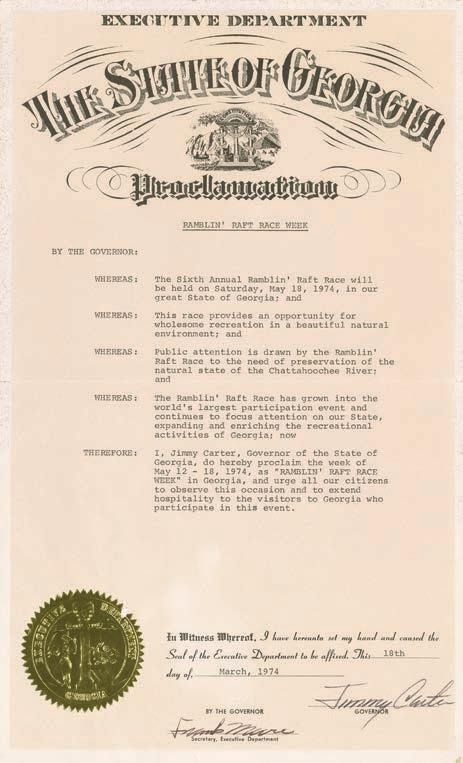
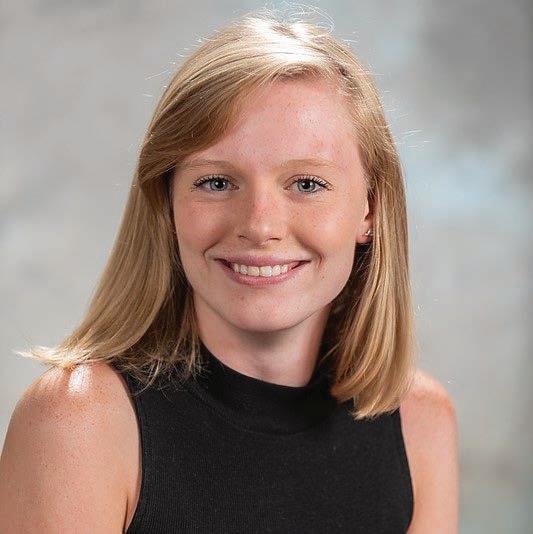

Yet the legacy of the Ramblin’ Raft Race lives on. The race put the Chattahoochee on the map as a recreation destination. In 2021, for example, more than 3.2 million people visited the Chattahoochee River National Recreation Area. Alumni from the race era cherish their memories of a rollicking and carefree
day prior to finals spent on the river with friends, enjoying “a beautiful day in a beautiful place,” as the lyrics of the race ballad recall. “ e joy that it brought to people was incredible,” Knaszak says.
As for the leaders and volunteers, they still feel a tremendous sense of pride and amazement in pulling off such a monumental cultural phenomenon. “The organizers of Woodstock only managed to do it once,” says Gil Patrick. “We did it every year.”

46 SPRING 2024 | GTALUMNI.ORG/MAGAZINE
hooch”
race’s heyday?
fellow rafters and share
own at gtalumni.org/RaftRace or point
at the QR code.
What memories do you have of “shooting the
during the
Read stories from
your
your phone
Then-Governor Jimmy Carter, Cls 46, presenting Larry Patrick and race organizers with a state proclamation.
Larry Patrick established the American Rafting Association to support river recreation.
Ramblin' Raft Race Remembered Ramblin' Raft Race Remembered
The proclamation recognized Ramblin’ Raft Race Week.
What does Roll Call mean to you?
Thousands of alumni make a gi to Roll Call every year – each for a reason that is important to them:


Some give to help students achieve their fullest potential as engineers and leaders.
Students like Maria Rain Jennings, MS ChBE 21, PhD ChBE 24, who has not only benefited from a Roll Call funded Georgia Tech President’s Fellowship, but also learned so much about mentorship and professional networking as an active member and mentor in the Roll Call supported Georgia Tech Women in Engineering (WIE) program.
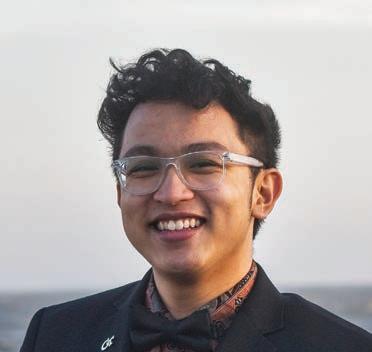

Some give to help make the best-in-class student experience possible for the next generation of leaders and problem solvers.
For leaders like Jason Sodikin, the Roll Call supported Tech Promise program broke down the walls of financial insecurity and made the Tech experience a reality. Now the President of Tour Guides at Georgia Tech, Jason exemplifies the Tech spirit by sharing his insights with new Tech students.
And others give to help ensure the future excellence of Georgia Tech.
Being the best means providing unmatched experiences for students, like the internship in the United States Senate that Kyle J. Smith, PP 22, experienced through Tech’s Roll Call supported Federal Jackets Fellowship.
No ma er the reason, when you support Roll Call, you are supporting superlative students just like Maria, Jason, and Kyle. Whether it helps fund the next generation of engineers, provides unmatched opportunities, or helps bring the very best to Tech, a gi to Roll Call preserves and enhances Georgia Tech’s legacy of excellence.
Scan to see a special video message about what Roll Call means to Georgia Tech President Ángel Cabrera
GTalumni.org/RC

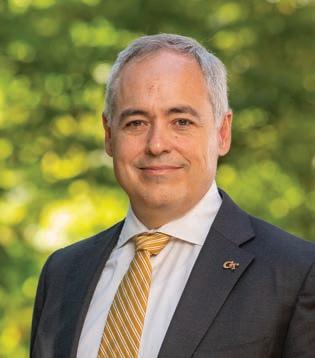
GTALUMNI.ORG/MAGAZINE | SPRING 2024 47
GGeorgia Tech alumni can build just about anything. Here are 10 examples of their ingenuity pushing upward and outward. From a 12-foot-tall skeleton towering over trickor-treaters to a 103-foot-long pirate ship docked in a stadium, explore examples of their architectural and engineering might.






















































GTALUMNI.ORG/MAGAZINE
48 SPRING 2024 | GTALUMNI.ORG/MAGAZINE
ILLUSTRATIONS BY CHARLIE LAYTON


























































GTALUMNI.ORG/MAGAZINE | 49
BY JENNIFER HERSEIM


If you needed one more reason to love Halloween, every time you see Skelly, the shockingly tall skeleton that towers over trick-or-treaters in your neighborhood, know that there’s a Georgia Tech engineer behind the phenomenon.
Rachel Little, BME 15, is a senior product engineer at e Home Depot, where she works on the company’s Halloween and Christmas decorations. Her team was responsible for bringing Skelly to life, engineering the 12-foot-tall skeleton from skull to bony toes.





skeleton, Little thought, “OK, this is a good challenge.” Fortunately, Skelly has a lot of bones that wind can pass through.


“A lot of the work I get to do is similar to what I did at the Invention Studio at Georgia Tech,” Little says. She reviews 3D-printed models of the products before they move forward with manufacturing and then ship to stores. Often, the trickiest part in the design process is concealing structural frames and making the products withstand weather. “Wind is always the biggest challenge for me,”
Little says. In 2020, when her senior merchant of decorative holidays came to her and the team with the idea for a giant


When Skelly was first released, he sold out within a few weeks. “It was the perfect storm,” Little says, “It was the first year of Covid and everyone was stuck at home, so people really leaned into doing exterior decorations.” e skeleton’s oversized presence brought smiles to people’s faces and even spawned its own viral videos on social media, where people shared videos of the skeleton strapped to the top of small cars.
Since engineering Skelly, Little and her team also introduced a 13-foot-tall animatronic Jack Skellington from The Nightmare Before Christmas
Little’s advice for holiday decorating is simple: Have fun with it and don’t take it too seriously. “Spider webs and Halloween string lights can go a long way in enhancing your set. And fog. I always love fog.”

ATLANTA’SSKYLINE “SKELLY”






Atlanta would be unrecognizable without the iconic buildings designed by late architect and Yellow Jacket John Portman, Arch 50. His soaring structures include three of the city’s tallest buildings: the 47story Atlanta Marriott Marquis, which was the largest hotel in Atlanta when it was built in 1985; the Westin Peachtree Plaza, which was the tallest hotel in the world when it was completed in 1976; and the Truist Plaza, which at 871 feet is second in height in Atlanta only to the Bank of America Plaza building (932 feet).



























50 SPRING 2024 | GTALUMNI.ORG/MAGAZINE
TRUIST PLAZA 871 FEET WESTIN PEACHTREE PLAZA 723 FEET SKELLY, THE VIRAL HALLOWEEN SKELETON 12 FEET
554 FEET
ATLANTA MARRIOTT MARQUIS















THE WORLD’S LARGEST MAN-MADE WHITEWATER RIVER
For an Olympic kayaker like Scott Shipley, navigating a path through Georgia Tech while also participating in competitive kayaking required good balance and a bit of humor.
For example, during his last semester, Shipley’s professor asked each member of the class to introduce themselves. e rst student stated his name and said that he was a third-year senior, the next said she was a fifth-year senior, and so on. And, then it was Shipley’s turn. “Hi, I’m Scott,” Shipley said. “And I’m a 13-year senior.”
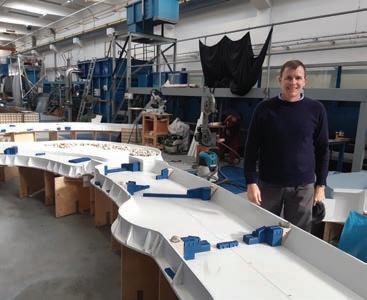
Shipley tests his whitewater course designs on a small-scale model.
Who could blame Shipley for his winding path to graduation when he was also competing for world championships and Olympic medals? When he did reach the nish line in 2001 with a bachelor’s in mechanical engineering and in 2002 with his master’s in ME, he held an impressive four world titles and had competed in three Olympics (1992, ’96, and ’00). His senior Tech project was designing a new kayak that he used to win one of those World Championships.
A er graduation, Shipley leveraged his experience and degrees from Tech to design more than 20 premier whitewater centers around the world. One of his rst projects was the U.S. National Whitewater Center, which features an enormous 3,750-foot man-made whitewater river. It was the largest man-made whitewater river in the world— until Shipley built the Montgomery Whitewater Center last year in Alabama.



1,600FOOT
2,200FOOT
e Montgomery facility boasts a 1,600-foot Olympic standard competition channel and a 2,200foot creek channel that provides an approachable path for new and experienced paddlers.
“You can show up with your family and ra on the same channel that Olympians win gold medals on,” Shipley says. “But we know that not everyone wants to get wet,” he adds. The facility also includes plenty of spaces for dry activities like a conference center, ropes course, and mountain biking and jogging trails. “We set out to create this whitewater center, but what we’ve created in the end was an outdoor adventure center where everybody can nd their adventure,” he says.
Shipley’s rm has revolutionized the design of whitewater courses. For the 2012 Olympic games, he was challenged to design a course that would be state-of-theart 10 years into the future. e result was the invention of Rapid Blocs, a patented system of moveable blocks that allows for an in nite number of whitewater course design combinations. e polyethylene blocks can be moved to create new eddies or new waves.
Shipley says it wouldn’t have been possible without Georgia Tech. “ e life lessons I learned from Tech have made all this possible—the ability to run a design process and completely rethink the way we’ve done things—it makes me super thankful that I had that opportunity to go to Tech and was able to spend my ‘short’ 13 years there.”
GTALUMNI.ORG/MAGAZINE | SPRING 2024 51
MONTGOMERY WHITEWATER CENTER
OLYMPIC STANDARD COMPETITION CHANNEL
CREEK CHANNEL


AWORLD-CLASS RACETRACK



The 750-acre Michelin Raceway Road Atlanta, one of the world’s premier road courses, got its start in 1969 with Ramblin’ Wreck Earl Walker, AE 61, and his business partners David Sloyer and Arthur Montgomery.
A er graduating from Georgia Tech, Walker became hooked on road racing. While working on Chrysler’s Saturn Space Vehicle in Huntsville, Ala., he raced his family’s Sunbeam Alpine, which he had modi ed with a roll bar, scatter shield, and a shoulder harness. “I was young and naïve and luckily never wrecked it,” he shared.
By the time he moved back to Atlanta and met Sloyer, a southeast road racing champion, Walker was racing every chance he got. He and Sloyer read Dave Carnegie’s classic, How To Win Friends and In uence People, and decided to apply the business guru’s approach to their shared dream of building a world-class racetrack in Georgia. “We were young and indestructible and the positive attitude worked,” Walker recalls. A er their rst attempt at buying and developing land failed, they found a piece of farmland in Hall County, Ga., and went to work transforming it into a racetrack. eir big break came in 1970 when a storm damaged a course in New York that was set to host the Can-Am series, which at the time was the most popular professional road race.




















e series needed a new track fast and moved the race to Road Atlanta, even as the course was still under construction. Walker and his partners accelerated their plans to nish the track and added new bathrooms, a concession stand, and other facilities for the event. With days le before the big race, they realized they needed a new building for ticket control. Walker found a company with a new quick-construction method, and they poured the foundation and framed the building with expanding foam over cloth. “It wasn’t uniform and looked like a toadstool, which is what we called it.
e woodpeckers loved it and it leaked when it rained but it served its purpose,” Walker remembers. On the day of the race, he was outside the venue, directing tra c as tens of thousands of spectators rolled in. e race was an overwhelming success, but they didn’t have time to celebrate because they were already preparing to host an even bigger race, the American Road Race of Champions, a couple months later. In 1978, Road Atlanta was sold to new owners, and it changed hands several times during the decades that followed. Today, Michelin Raceway Road Atlanta is owned by NASCAR Holdings and receives more than 400,000 annual visitors.










REFLECTING ABSENCE
The serene sounds of falling water bathe visitors as they gaze into two pools, each nearly an acre in size, that rest in the footprints of the North and South Towers of the World Trade Center. Along the edges of the pools are the names of the 2,983 people who lost their lives in the attacks on Sept. 11, 2001. Architect Michael Arad, M Arch 99, designed the pools to represent “absence made visible.” Water descends 30 feet into a square basin and then another 20 feet into a central void, making the pools the largest man-made waterfalls in North America.
52 SPRING 2024 | GTALUMNI.ORG/MAGAZINE
9/11 MEMORIAL 30FOOT WATERFALLS ROAD ATLANTA 2.54 MILES
THE

PONCE CITY MARKET REVITALIZATION
2.1 MILLION SQUARE FEET





A swarm of Yellow Jackets played a role in transforming this historic building into a bustling hub for pedestrians and visitors. e revitalization of Ponce City Market in Atlanta’s Old Fourth Ward involved restoring the Southeast’s largest masonry structure, a 1926 building originally constructed by Sears, Roebuck & Co. Updating the building while preserving its history required the expertise of several contractors and nearly 3 million combined worker hours. Gay Construction Co., led by alumnus Tom Gay, IM 66,











spearheaded the base building and site renovations. Several other Yellow Jackets at the construction company played crucial roles in the project, including Joe ompson, CE 71, Mark Whitney, ME 03, David Martin, CE 93, MS BC 94, Rick Carswell, ID 94, and Tommy Herrington, IM 82.
e rst phase of the 2.1 million-square-foot redevelopment opened in 2013 and has become a pedestrian-friendly economic hub in the Fourth Ward neighborhood.
THE BIG CHICKEN











Georgia Tech alumnus Hubert Puckett, Arch 57, designed the 56-foot-tall structure that over the last six decades has become a point of pride and a local landmark for the city of Marietta, Georgia. e Big Chicken was constructed in 1963 and restored in 1993 following storm damage. It underwent another renovation in 2017, when the rooster’s moving eyes and beak were added. At 90, Puckett still designs buildings through his company U.S. Building Technology. He never expected the Big Chicken to become such a local phenomenon.













GTALUMNI.ORG/MAGAZINE | SPRING 2024 53
PONCE CITY MARKET
MARIETTA’S BIG CHICKEN 56 FEET
TAMPABAYBUCS’PIRATESHIP















THE PIRATE SHIP 103 FEET

Chip Hayward, Arch 79, M Arch 81, was project manager and architect, representing the Tampa Bay Buccaneers, for the design and construction of Raymond James Stadium—an impressive 65,000-seat structure—
but it’s the 103-foot-long ship docked in the stands that was a dream come true for the architect and sailing enthusiast. “I got to ful ll my dream of designing a ship, even though it is still in and has never le dry dock,” Hayward shared in 2009 with the Alumni Magazine
Hayward says the biggest challenge was constructing the ship while the stadium construction was ongoing. e pirate ship was designed to be disassembled in quadrants so it could be removed to make room for the expanded temporary seating required for the Super Bowl; however the TV networks loved the ship and requested it remain for gameday broadcasts.
e stadium has been the location of three Super Bowls and, this past December, saw the Yellow Jackets beat the UCF Knights 30-17 in the Gasparilla Bowl.
“The Tampa Bay Yellow Jackets love when the Yellow Jackets come to Tampa,” Hayward says. “We all feel more connected to Ma Tech when this happens, and we get to see our fellow alumni and families in a great venue. Go Jackets! THWg!”
ATLANTABELTLINE








From a master’s thesis to a reality, the 22-mile Atlanta BeltLine was the brainchild of Georgia Tech grad Ryan








Gravel, Arch 95, M Arch and M CRP 99. Gravel’s idea to convert unused railroad corridors into a system of pedestrianfriendly trails connecting Atlanta has become an inspiration for sustainable growth and connectivity. By the end of 2024, 85% of the BeltLine’s projects will be complete or actively under construction, with 10.4 miles of the main loop and 10.3 miles of connector trails nished.













22 MILES
54 SPRING 2024 | GTALUMNI.ORG/MAGAZINE
THE ATLANTA BELTLINE
Dinal Andreasen, EE 77
GTRI’S ARTS-VI


















One of the largest systems ever built by the Georgia Tech Research Institute (GTRI) is a new 142-ton threat simulator system that rolled out to the U.S. Air Force last June. e ARTS-V1 system, the rst of three contracts with the Air Force, is designed to help pilots train for a variety of scenarios they might encounter in contested airspace and help them prepare for real combat situations. To put the size of the system in perspective, the radar unit is housed in a trailer that’s 81 feet long and the operator unit requires a trailer that’s more than 94 feet long. Transporting the system required the Air Force’s largest aircra , the C-5M Super Galaxy. More than 50 GTRI researchers and technicians contributed to the design of the system. Check out the list of alumni and students involved.
Samuel Bass, MS ME 25, ME 23
Vince Camp, EE 83
Robert Case, MS ME 17
Henry Cotten, MS ME 74, ME 68
Dante Dimenichi, ME 14, MS ME 19
Robert Dunning, ME 23, MS ME 24
Zachary Eaton, ME 04, MS ME 06
Brian Faust, CmpE 04, MS ECE 06, MBA 18
Justin Fox, EE 03, MS ECE 06
Ian Harrison, ME 13, MS ME 20
Brian Holman, EE 06
Jacob Houck, ME 10, MS EE 12, MBA 17
Joshua Hurt, ME 19, MS ME 21
Burt Jennings, ME 81
Steven Johnston, ME 18, MS ME 19, PhD candidate ME 24
Joshua Judson, ME 22
Christopher Keel, MS ME 23
Daniel Kotten, ME 22, MS ME 24
Jeffrey McMichael, ME 18
Nicholas McGilvray, EE 18
Matt Rash, ME 11, CE 16, MS CE 19,
Barry Sharp, EE 76, MS EE 81
Scott Travis, EE 08, M ASE 16
Max Tannenbaum, ME 14, MS ME 19
Michael Witten, MS EE 85
Current Students:
Kevin Kamperman II, MS ME 24
Austin Pettit, MS ECE 26
Daniel Polito, M ASE 24
Tyler Russell, MS ECE 24
GTALUMNI.ORG/MAGAZINE | SPRING 2024 55
ADVANCED RADAR THREAT SYSTEM (ARTSV1) 142 TONS HOUSED IN AN 81FOOT LONG TRAILER Tech Tower – 145 feet tall 150 feet 100 50 0 Pirate Ship – 103 feet Big Chicken - 56 feet Skeleton – 12 feet
TOWER STACK UP?
ALUMNI INVOLVED IN GTRI’S ARTSV1
HOW DOES TECH
GEORGIA TECH
SEE WHERE “GOING BIG” HAS LED THESE YELLOW JACKETS.
BIG IDEAS ON LIVING
What happens when you super-size an idea?
At Georgia Tech, students grow their ideas into ambitious projects for good. Their ideas sprout into companies through programs such as CREATE-X. They tackle entrenched issues using a multidisciplinary approach through the Vertically Integrated Projects Program, which pairs students with faculty to work on long-term project teams. Georgia Tech instills the skills to help Yellow Jackets bring their ideas to fruition.
On the next pages, the Alumni Magazine takes a look at what happens when you super-size an idea. From a researcher taking on a deep problem facing big tech to a couple, who took a giant leap in their personal and professional lives, gain insight into what happens when you “go big.”
56 SPRING 2024 | GTALUMNI.ORG/MAGAZINE

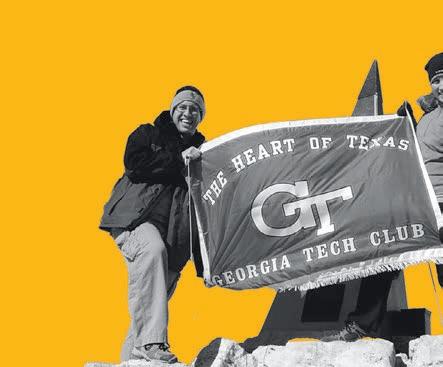

TECH GRADS TURNED GLOBETROTTERS
Digital nomads make their home and office wherever they happen to be.

JT GENTER, MGT 07, remembers thinking there had to be a better way. It was 2014, and the Georgia Tech grad was working as an accountant in Austin, while his wife and fellow Yellow Jacket, Katie Genter, CS 09, worked toward her doctorate at the University of Texas. She was also involved in competitive robot soccer (yes, that’s a thing), and that year’s world championship, the RoboCup, was in Hefei, China. In years past, the couple had used the annual RoboCup as an excuse to indulge a shared passion for globetrotting, but this time, JT struggled to find an affordable ight. “I had always found cheap ways to go with her,” he says. “But the cheapest way to Hefei was going to be $2,000.”
At the time, JT was following The Points Guy, a blog about maximizing airline, hotel, and credit card loyalty reward programs. JT decided to give it a shot. He applied for a Chase credit card that o ered 70,000 bonus points, since he discovered he could transfer those earnings into 70,000 United Airlines miles, good for round-trip award ights to China. It was a revelation.
Within a few years the Genters had moved out of their house, sold o or given away any possessions that couldn’t t into their two cars, and embarked on the rootless existence of digital nomads, living and working remotely from whatever coordinates they happened to occupy. Since then, they have own more than 1.3 million miles on 84 airlines to 236 airports across 60 countries. They’ve stayed in 58 countries, redeeming over 6 million points through six different hotel loyalty programs. And they’ve done it spending about $910 a month for lodging (a reasonable rent) and less than $5,000 per person per year on airfare. ey o set that out-of-pocket cost by accumulating even more points and
getting paid to write about their experiences, strategies, and systems for AwardWallet, NerdWallet, and e Points Guy.
Funny that their relationship started with a 2-mile road trip across downtown Atlanta in 2004. JT met Katie when he was a student manager for the Tech volleyball team. e Yellow Jackets were playing at Georgia State, and Katie was at the game with a friend. JT gave them a li in his car back to Tech.
He had grown up on planes with a family that loved to travel, and even in college, he’d use an AirTran standby pass to get cheap one-way ights all over the country. A er graduation, he began a career as an accountant but found o ce life sti ing. “I would always try to negotiate for more time o —I’d forgo a raise,” he says via Zoom from Alexandria, Egypt. “ at’s how I fell into points and miles to save money.” But it was during a “gap month” leading up to Katie starting grad school in Texas that the couple fell into wanderlust when they extended an Alaska cruise with his grandparents into a weeks-long tour of the West Coast. “We thought, is is incredible, ” he says. “Why don’t we just do that for longer? ”
So they took a big leap and now do it perpetually. The key, they say, is to avoid true loyalty to one airline, hotel chain, or credit card, and spread the love across brands and programs that feature transferrable points. at way, when one program devalues their points, you have other transfer partners to turn to. eir other advice: It’s not for everyone. You must be diligent about the ever-changing rules of each rewards program and willing to continually tweak your system. e couple also currently has 58 di erent credit cards open, which they don’t recommend to anyone.
As for the Genters, their goal is to travel a little less—not come home, wherever that might be, but spend more than three or four days in each spot. “Most digital nomads will be in one place for a month,” says Katie. “Our favorite thing to do is wander, walk around, eat local food, and interact with the people. It makes us feel alive.” — Tony
Rehagen
GTALUMNI.ORG/MAGAZINE | SPRING 2024 57




THE RESEARCHER ‘UNMASKING AI’

With evidence and conviction—two important ingredients to tackling a vast societal issue—Dr. Joy Buolamwini is taking on big tech and the lingering issue of algorithmic bias.
ON THE SEPTEMBER 2020 cover of Fast Company magazine, the glaring brown eyes of Dr. Joy Buolamwini, CS 12, rest beneath oversized white frames. Under the headline “ e Most Creative People in Business,” the esteemed business magazine introduces Buolamwini as “ e Researcher Who Took on Big Tech—and Won.”
In the digital age, where tech aunts an outsized impact on society, the thought of battling corporate behemoths like Amazon, Microsoft, and IBM would seem a futile, foolish pursuit.
But Buolamwini, with her eyes pointed ahead, isn’t much for kowtowing to long odds. Her pioneering research on facial recognition and arti cial intelligence (AI) biases convinced leading tech companies to slow and re-evaluate their development of such algorithms. Meanwhile, her recent national bestseller, Unmasking AI: My Mission to Protect What Is Human in a World of Machines, urges the larger populace to embrace a deeply critical look at AI’s continued rush into daily life.
“If we’re going to be in a world where AI is so integrated in our life, then how do we make sure this technology is actually moving all of us forward?” Buolamwini asks.
LEADING THE CHARGE
e seeds for Buolamwini’s crusade against inadequate AI were planted at Georgia Tech.
As an undergraduate, Buolamwini worked on a project called Peekaboo Simon, which used facial detection to facilitate human-robot interaction. When the technology failed to catch her face, Buolamwini thought it odd. Months later, she encountered a similar experience while attending a student entrepreneurship contest in Hong Kong. e two events spurred questions about the limitations of facial recognition, which Buolamwini initially attributed to issues like lighting or background.


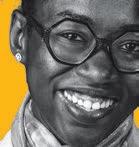











While pursuing graduate work at MIT six years later, Buolamwini again confronted facial detection so ware struggling to read her face. When she grabbed a white mask, however, the technology responded.




An issue Buolamwini assumed had been addressed lingered, and she questioned if the algorithmic ine ciencies were less about environmental conditions like lighting or background and more about bias. Who holds the power to shape priorities and preferences in technological innovations, she wondered, and how do subjective human choices factor into these emerging technologies?
Quickly, Buolamwini found herself engrossed in research and advocacy, spotlighting an issue with swelling concerns as institutions from law enforcement to healthcare to education pulled AI into their work at an accelerating pace.
Buolamwini tested commercially available AI products and generated powerful empirical evidence of algorithmic bias, e orts enabling her to bat away scrutiny and skepticism.
She published papers capturing the attention of mainstream media and gave a spirited TED Talk—now viewed more than 1.7 million times—introducing the idea of algorithm bias. She launched the Algorithmic Justice League (AJL) and starred in the celebrated documentary Coded Bias. She testi ed before Congress and spoke at the World Economic Forum.
“ is issue needed to be brought to light,” she says.

58 SPRING 2024 | GTALUMNI.ORG/MAGAZINE
DRIVING AWARENESS
Unmasking AI, which dropped last Halloween, represents Buolamwini’s latest attempt to counter the AI global hype machine and encourage conscientious action from technology leaders and everyday citizens alike. Blending her own personal experiences and diligent research, Buolamwini’s debut work highlights AI’s adverse impact and encourages speci c e orts to capture AI’s bene cial promises.
“If people have a face, they have a place in this conversation,” Buolamwini says.
She calls the stakes massive, especially as AI proliferates and governs opportunity, including access to employment, education, and healthcare. If the problem is ignored, she fears progress in areas like women’s rights or accessibility could crumble under the guise of machine neutrality.
“Once we have AI serving as the gatekeepers, it’s imperative we make sure that gatekeeping isn’t narrowing opportunities,” she says.
And slowly, she notes, people are beginning to recognize AI’s limits and issues of algorithmic bias.

AS A KID GROWING UP IN CUBA, Yaima Valdivia had a fascination with science, which extended into computer science, robotics, and AI thanks to a required course in the sixth grade and the novel e Bicentennial Man. After earning her bachelor’s degree, she moved to the United States, where the realities of immigration sidelined her academic aspirations. Valdivia worked as a so ware engineer for some credit unions in Atlanta and was inspired by Tech’s






“If people have a face, they have a place in this conversation,” Buolamwini says.
ey’re seeing ubiquitous AI tools misclassifying the iconic faces of people like Oprah Winfrey and Serena Williams. Or they’re reading about people like the eight-months pregnant Porcha Woodru , who was arrested for carjacking and robbery in Detroit due to a facial recognition mismatch.
“ e biggest win will be to change the mindset and perspective of people and organizations,” says Buolamwini, whose work has expanded from biometric rights and into creative rights with generative AI.
An admittedly colossal challenge, but Buolamwini isn’t backing down.
“It’s too important,” she says. “We have to get this right.”
—Daniel P. Smith
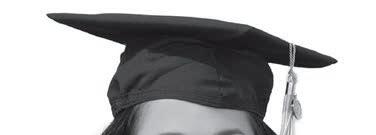
A BIG IDEA LEADS TO ‘THE GREATEST DEGREE PROGRAM EVER’
In only 10 years, the Online Master of Science in Computer Science program at Georgia Tech has grown to more than 11,000 alumni.


vibrant community; that exposure grew her admiration for the Institute long before she considered enrolling in any of its programs. When Valdivia was ready to continue her education, the prestige of a Georgia Tech degree, the exibility of a curriculum that allowed her to continue her career as a senior engineer in Silicon Valley, and the low cost drew her to the Institute’s Online Master of Science in Computer Science (OMSCS).


GTALUMNI.ORG/MAGAZINE | SPRING 2024 59
Since its founding 10 years ago, Georgia Tech’s OMSCS program has helped more than 11,000 students like Valdivia earn an advanced degree from a world-renowned institution for less than $7,000, thanks to the power of technology.
e average cost of a master’s degree in the United States according to the Education Data Initiative is about $66,000. For Zvi Galil, who served as the dean of the College of Computing from 2010 to 2019, that high price tag makes him question the value of higher education. Which is why in 2012, when an education company at the forefront of the creation of massive open online courses (MOOCs) approached him about creating an a ordable online program using MOOC technology, Galil jumped at the opportunity.
“I immediately liked the idea because I wanted to improve access to higher education,” Galil says. “There are two parts to this concept of access. One is the tuition, which excludes quite a number of people. e second is the infrastructure and the capacity of the university to support a certain number of students. e solution was to create a high-quality online program that was more a ordable than an on-campus program.”
anks to a partnership with education company Udacity, a $4 million grant from AT&T, and support from Tech administration and faculty, the Institute’s OMSCS program launched in January 2014 with 380 students. While college enrollment in the United States has dropped 7.4 percent in the last decade, Georgia Tech’s online program is bucking that trend. Today, over 13,300 students from 120 countries are enrolled. In November, a contributor for Forbes.com called OMSCS the greatest degree program ever.
According to David Joyner, CS 08, MS HCI 09, PhD HCC 15, who serves as the executive director of online
education and OMSCS, Tech’s program is unique not just because of its a ordability.
“Many universities develop online programs that are very distinct from what is offered on campus,” he says. “Ours is the same degree; it’s just o -campus. We started from a foundation of what we were already doing in person and found the minimum number of compromises to go online. at ensures we’re keeping as much of the quality of the in-person program as possible and ensures we’re preserving the rigor and reputation of the degree.”
The online program does differ from its on-campus counterpart on one count: admission requirements. e GRE is not required, and students are accepted tentatively and must earn two As or Bs during their first year to be fully admitted.

“That’s totally opposite from what’s going on in other American universities,” Galil says. “ e more students they reject, the prouder they are. In some sense, these universities cannot ful ll their missions. ey speak about equity, but they are selective, and they are not accessible. OMSCS came about to help show what’s possible.”
Tech launched two other OMS degrees, one in cybersecurity and one in analytics, bringing OMS course options to more than 60. As the online program continues to grow, its leaders have dreams for the future. Galil says he hopes that in his lifetime the online model will extend to undergraduate education as well. Joyner hopes the program will cover more computer science topics in the future and become more interdisciplinary.

“There’s a misconception that if we’re radically increasing the number of Georgia Tech alums out there, it’s diluting what the degree means,” Joyner says. “But it’s not like that. Our OMSCS students come into the program as incredible people, they graduate with a Georgia Tech degree, and they continue to be incredible. We’re able to let people who are phenomenal now also be Georgia Tech people. at’s increasing the reputation of Georgia Tech.”
“We started from a foundation of what we were already doing in person and found the minimum number of compromises to go online,” Joyner says.


Georgia Tech will be hosting an anniversary reception for the OMSCS program April 29–May 1.
— Kelley Freund


60 SPRING 2024 | GTALUMNI.ORG/MAGAZINE



BIG IMPACTS IN TINY SPACES
This is the “Big” issue, but we carved out a tiny section on a few of the outsized ways that Georgia Tech researchers are making big impacts in small, even nano-sized, spaces.
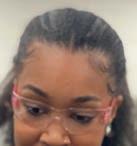








Light-Powered Yeast
Just because something comes in a small package, doesn’t mean it can’t have a big impact. Like rhodopsin, a protein that converts light into energy and is found in a wide range of organisms, from bacteria to humans. As researchers in Associate Professor William Ratcliff’s lab, Anthony Burnetti and Autumn Peterson (pictured above) study major transitions in evolution—the innovations that changed the course of life.
After engineering rhodopsin to the vacuole of singlecelled yeast, they found that the yeast, an organism with no evolutionary history of solar-powered growth, divided faster when exposed to light—2 percent faster than they did in the dark. The results can be used to study things like biofuel production and cellular aging, as well as basic evolutionary processes.

Insects and Robots

Despite having an uncomfortable close encounter with a cicada when he was 6 years old, Associate Professor of Physics and Biological Sciences Simon Sponberg still has respect for insects and their ability to maneuver through almost every environment on the planet.
Many insects use their brain to command their muscles to beat each wing stroke. But smaller insects need more wingbeats per second in order to fly, and at some point their muscles can’t contract and relax fast enough. Instead, the nervous system in insects like bees and mosquitoes sends a pulse to the muscles that causes them to vibrate quickly, before they receive another pulse from the brain. This asynchronous flight allows them to flap their wings at high rates. At least four different, large groups of insects are capable of asynchronous flight, and while it was previously thought that each group evolved the trait separately, research from Tech
“These results can help us understand how a fundamental mode of making a living is acquired by new organisms and put to use,” Ratcliff says. “And we found there was a benefit right away without having evolution to fine-tune it.”
But since the lab’s focus is evolution and multicellular life, the team is taking their results a step further by understanding why the earliest multicellular organisms are photosynthetic.
“The cells in the interior of our multicellular organisms run out of oxygen, and normally this limits their growth. We’re interested in seeing if by engineering the rhodopsins to the vacuole of multicellular yeast, light can compensate for the lack of oxygen,” says Peterson. “Here we’re looking to do an evolution experiment by having them grow for a long period and see if anything changes over time.”


and the University of California San Diego show that they most likely evolved from a common ancestor, that evolution has turned on and off this mode of flight over time, and that some insects, like moths and butterflies, have the capacity for both regular and asynchronous flight. The discovery prompted the research team to then build a robot capable of switching between the two modes. Studying the flight patterns of insects informs us not just about evolution, but about engineering small flapping systems.
“One of the big frontiers we see in robotics is the design of autonomy in small packages,” Sponberg says. “Centimeter scale is hard to design. We do really well with tiny micro robots and big robots, and we have good sensors, processors, and motors that are a centimeter long. But putting them all together in a small package in a way that it can still fly is really challenging.” — Kelley Freund

GTALUMNI.ORG/MAGAZINE | SPRING 2024 61
ALUMNI HOUSE
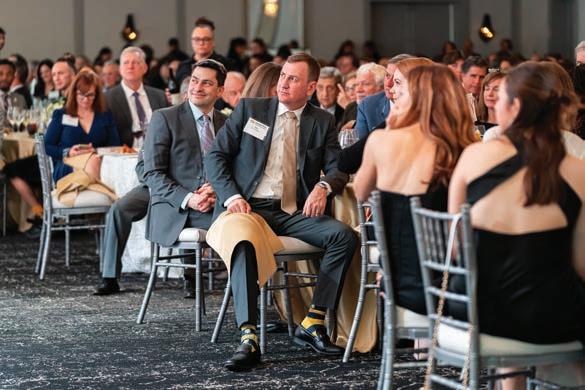

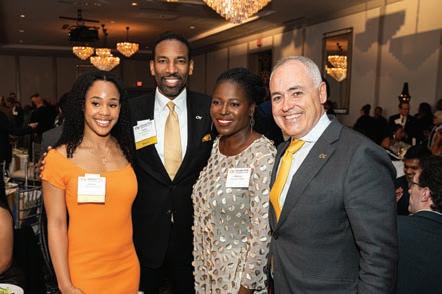
Ambassador Chisom Onyia, Mayor Andre Dickens, ChE 98, Executive Vice President for Administration and Finance Shantay Bolton, and Pres. Cabrera, MS Psy 93, PhD Psy 95.

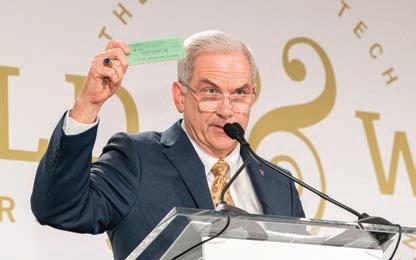

Student Ambassadors served as hosts during the Gala. From L-R: Page Franz, Elizabeth Yu (GT Student Foundation), Rileigh Daniel, Harrison Baro, Tehreem Hussain, Chisom Onyia, Ashleigh Henning, Gavin Mueller, Adaiba Nwasike, Sophie Watson, and Morgan Hathorn.
VOLUME 100 ISSUE 1
The Gold & White Honors Gala was held Feb. 15 in Atlanta.
Student Ambassadors Ashleigh Henning and Sophie Watson.
Alumni Association Chair-elect Tommy Herrington, IM 82, holds up a Junior’s Grill discount meal ticket.
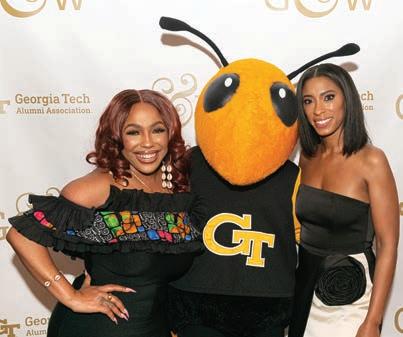
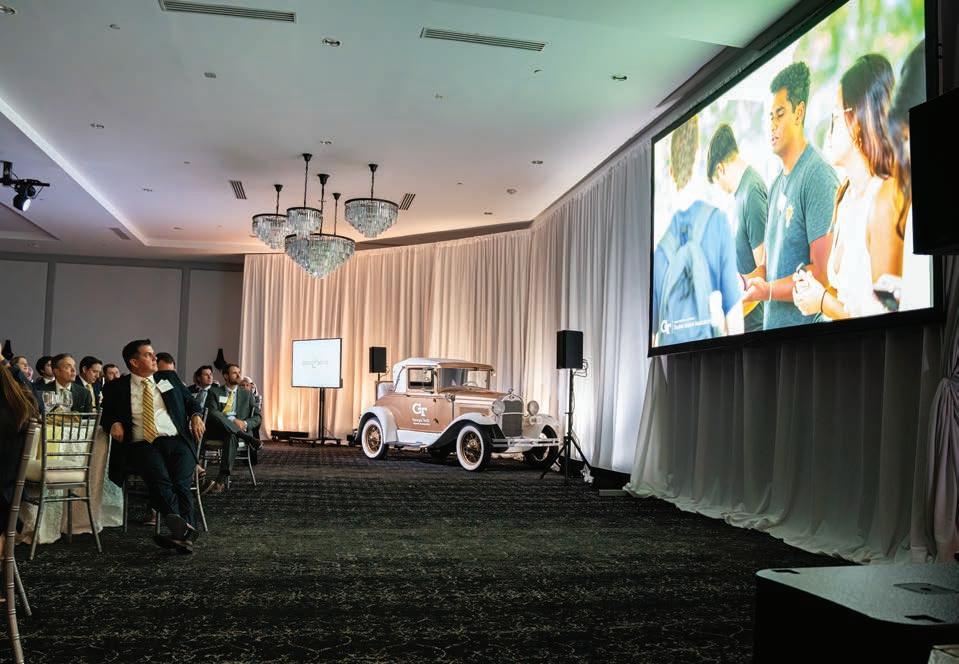
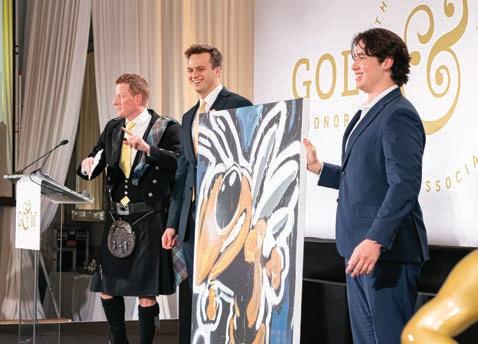
GOLD & WHITE HONORS
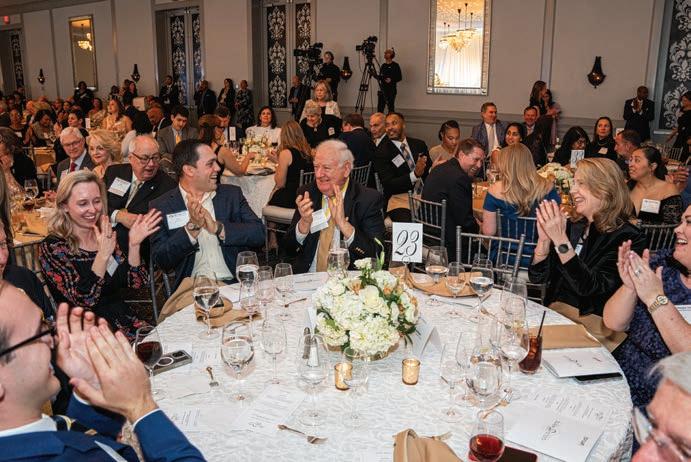
The 2024 Gold & White Honors Gala honored six outstanding members of the Georgia Tech community. Under the theme “A Lasting Legacy,” guests raised funds for the next generation of Yellow Jackets in support of three student programs.

GTALUMNI.ORG/MAGAZINE | SPRING 2024 63
Past honorees returned to support students and celebrate new Gold & White Honors recipients.
Dr. Beth Cabrera, MS Psy 93, PhD Psy 95, Carrie Sheheane, Dene Sheheane, Mgt 91, and Pres. Ángel Cabrera, MS Psy 93, PhD Psy 95.
The Gala featured a replica of the Ramblin’ Wreck donated to the Alumni Association by the family of the late John Caddell, Arch 52. Flags from the car are also displayed in the John and Joyce Caddell Building in the School of Building Construction.
Archel Bernard, STC 11, and Lindsey Owens, Mgt 07, with Buzz.
The live auction featured oneof-a-kind Tech-themed artwork.
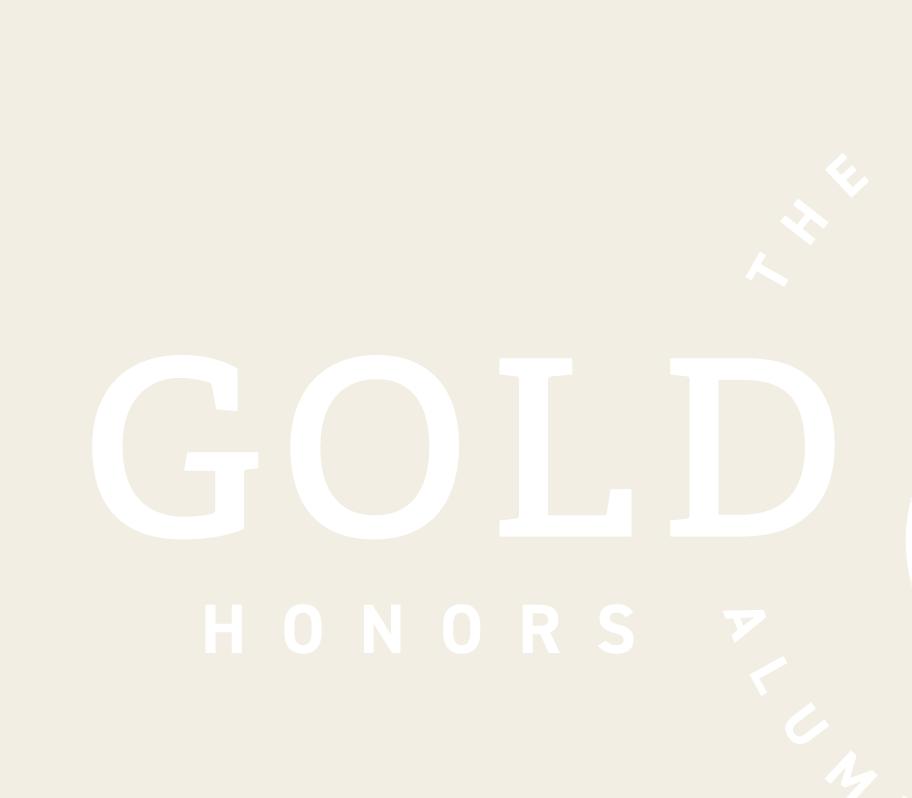














Under the theme “A Lasting Legacy,” the Georgia Tech community came together for an evening of inspiration and celebration at the 2024 Gold & White Honors Gala.
“The Gold & White Honors Gala is a chance for us to celebrate individuals who live out the values of a Yellow Jacket. Each year’s nominees renew my pride in being a part of the Georgia Tech community,” said Dene Sheheane, Mgt 91, president of the Georgia Tech Alumni Association.
The Gala is the Georgia Tech Alumni Association’s premier event and primary fundraiser for three nationally acclaimed student programs: the Student Alumni Association, the Georgia Tech Student Foundation, and the Student Ambassadors.
Through the generosity of our 25 corporate sponsors, individual ticket sales, and live auction proceeds, the evening raised more than $470,000 to support these dynamic student programs.
During the event, honorees spoke about the impact that Georgia Tech has had on their lives. In his speech, Walt Ehmer, IE 89, the Joseph Mayo Pettit Distinguished Service Award recipient, discussed how being a part of the Georgia Tech community recently changed his journey. “Three months ago, I was told I had two to three months left to live. Through a relationship in this room, I found the right doctors at the right hospital with the right medicine, and I got in the right trial. I am here tonight when I thought I was never going to be. That was all due to relationships,” said Ehmer, who was diagnosed with pancreatic cancer.

Special thanks go to the Alumni Association Chair Betsy Bulat, IAML 04, and Alumni Association Chair-Elect and Gold & White Honors Gala Chair Tommy Herrington, IM 82.

Host Committee Members

Host Committee Members
Committee Chair, Jacquelyn Renée Schneider, BC 06,
MBA 18

Erik Bryant, MBA 15

Jacky Cheng, IE 17

Maddie Cook, IAML 12
Maddie Cook, IAML 12

Carson Earnest, IE 21

Jenny Fotia, MGT 08
Joe Gammie, ME 13
Susan Piña, IE 93

Stacey Sapp, IM 80



Simi Singh, IM 86
Sam Westbrook, IE 99


Student Committee Tehreem Hussain, NEUR 24
Simi Singh, IM 86 (Co-Chair)

Sadie McIntyre, BA 26

(Co-Chair)

Anushya Shankar, CS 26

(Co-Chair)

Kiran Balakrishnan, BA 25

Arjun Bhatia, CS 26

Page Franz, BME 25
Page Franz, BME 25

Ashleigh Henning, BCh 25
Ashleigh Henning, BCh 25

Martin Lachev, CE 25



Sophie Watson, IE 25




Special thanks to the Georgia Tech Office of Development for their support of the Alumni Association student programs and for hosting our Gold & White honorees.


64 SPRING 2024


A BIG LEGACY
MEET THE 2024 GOLD & WHITE HONORS RECIPIENTS


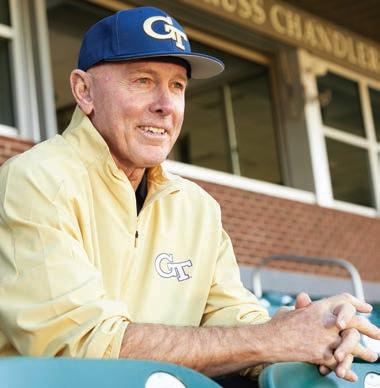
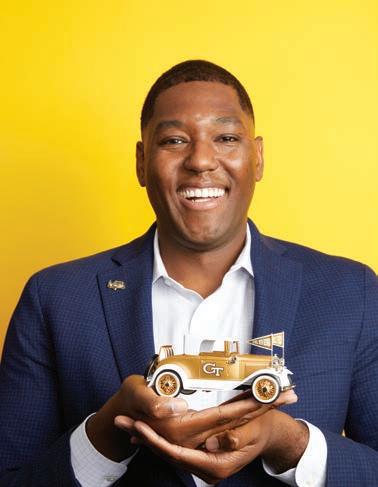
We can’t boast enough about this year’s Gold & White Honors recipients and their contributions to Georgia Tech and the community. These distinguished members of the Yellow Jacket family represent the best that Georgia Tech has to offer. This year’s honorees include two selfless leaders in the restaurant industry, a personal stylist dressed to the nines in Tech spirit, the Institute’s winningest baseball coach, a rising young leader, and Atlanta’s 61st mayor. The honorees were celebrated Feb. 15 in Atlanta at the Gold & White Honors Gala under the theme “A Lasting Legacy.” On the next pages, read about each honoree and their lasting impact.
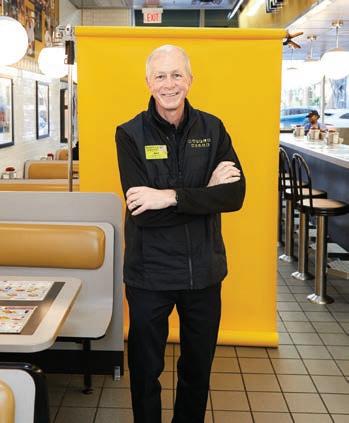
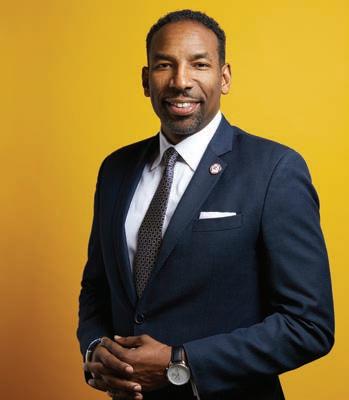

GTALUMNI.ORG/MAGAZINE | SPRING 2024 65
PROFILES BY JENNIFER HERSEIM AND MATT SOWELL | PHOTOGRAPHY BY KAYLINN GILSTRAP

 JOHN B. CARTER, JR. SPIRIT OF GEORGIA TECH
JOHN B. CARTER, JR. SPIRIT OF GEORGIA TECH
TOMMY KLEMIS, CLS 71
Retired Owner of Junior’s Grill
Generations of alumni remember their order at Junior’s Grill, a restaurant that served good food and comfort to Yellow Jackets for 63 years. But it wasn’t only the food that made Junior’s beloved. It was in large part the owner, Tommy Klemis, whose kindness and concern for students made Yellow Jackets cherish the restaurant. Klemis, along with his mother, Lula, his aunt “Miss Anne,”
Walter, who was known as “Junior’s poet laureate,” and other employees, ensured that Junior’s was a place of solace for students, staff, and faculty. Running Junior’s wasn’t part of Klemis’ original plan. He enrolled at Georgia Tech to study electrical engineering in 1970. Those plans were interrupted with the birth of his first child,
WHAT DOES IT MEAN TO YOU TO RECEIVE THIS HONOR?
“It shows me the incredible opportunities I have been given to engage with people. I thank God for allowing me to return to Georgia Tech. Caring and getting to know these students personally was what Junior’s was all about. To sit down with students and share stories over breakfast or lunch has truly been our joy. Receiving this honor shows me again how the legacy of a family business of 63 years has impacted so many students and makes me appreciate the spirit of our community here at Georgia Tech.”
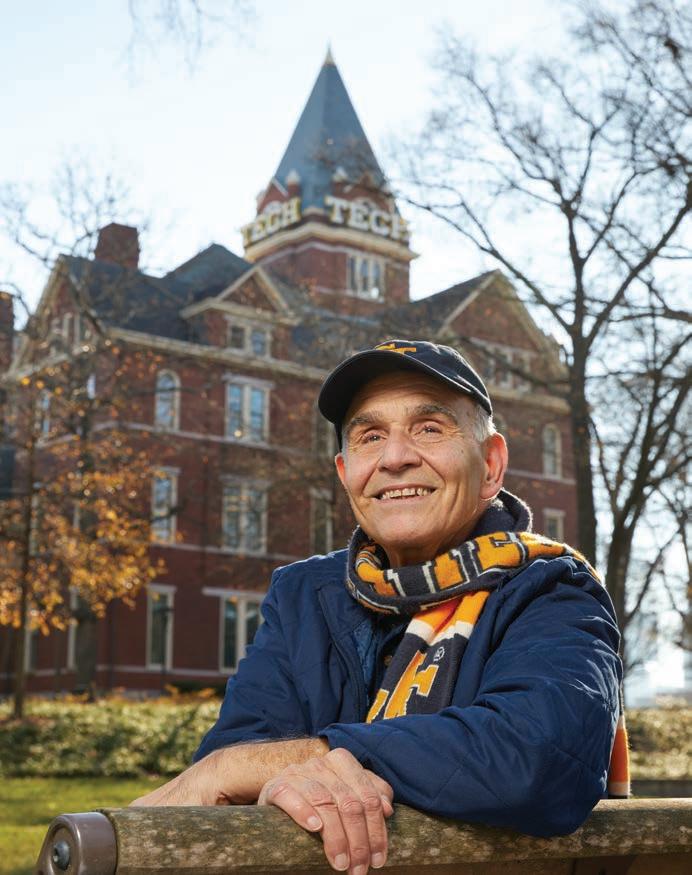
Jimmy, and shortly after a second child, Leigh Anne. Klemis left Tech for a job at Western Electric with intentions of returning to finish school. Klemis’ father, James, and brother-in-law John Chaknis owned Junior’s, but after his father passed away and Chaknis suffered a heart attack, Klemis stepped in to run the business with his mother in 1975. “God had other plans for me,” he says. “He brought me back to Georgia Tech. This time not as a student, but to serve them.” In 1993, when the family business was being torn down to make way for the Olympics, the Georgia Tech community brought Junior’s onto campus in 1994 as a new Tech tradition. When Junior’s finally closed in 2011, the line of well-wishers extended around the block. Klemis was overwhelmed by the show of appreciation. He was also proud to see his son graduate from Tech. In 2015, Tech paid tribute to Tommy Klemis’ legacy by opening Klemis Kitchen, an on-campus food pantry for students.
66 SPRING 2024 | GTALUMNI.ORG/MAGAZINE

 JOHN B. CARTER, JR. SPIRIT OF GEORGIA TECH
JOHN B. CARTER, JR. SPIRIT OF GEORGIA TECH
Those who know Cheryl Weldon, ChE 85, know she embodies the Tech spirit. After graduating from Georgia Tech, Weldon moved to Florida for her first job, then to Illinois for an MBA at Northwestern, then to the New York area to start her career in the healthcare industry. She says, “During that time, I missed my connection to Georgia Tech.” Fortunately for the Yellow Jacket community, she found a way to truly reconnect when she moved back to Atlanta in 1992. Her innovative spirit had led her to be part of the founding management team of Novoste Corporation, a medical device company that developed a specialized coronary catheter to treat patients with failed stents. Over the last three decades, Weldon has served on the Georgia Tech School of Chemical and Biomolecular Engineering External Advisory Board, the Alumni Association Board, the Georgia Tech Women Alumnae Network (GTWAN), the Georgia Tech Advisory Board, and as chair of her 25th Reunion Fund Committee. Since retiring in 2001, a common
WHAT DOES IT MEAN TO YOU TO RECEIVE THIS AWARD?
“To receive this award, named in his honor, is humbling and incredibly touching. I’ve known John Carter for a long time, and I’ve always admired his dedication and service to the Institute.
Receiving this award reinforces my desire to stay connected and to continue to give back to the school, in terms of my time and my treasure. For those who haven’t been as engaged, I would encourage them to do so, as I feel that they’re missing out on one of the best gifts of your student experience... the alumni experience.”
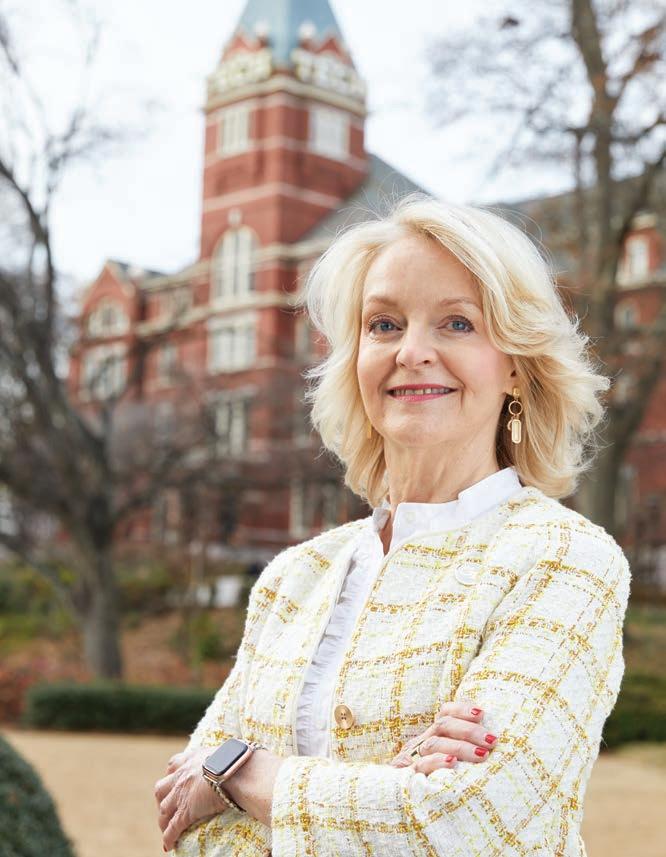
thread through Weldon’s volunteer work and entrepreneurial ventures has been a passion for providing opportunities for women. She was integrally involved with the creation of the GTWAN Women’s Day Forum. She has served her sorority, Alpha Xi Delta, for the past 20 years and spent the last 10 years as their delegate
to the Atlanta Alumnae Panhellenic Association. Additionally, Weldon began a successful post-retirement career as a personal stylist. She says it has allowed her to “serve inspiring women and to help them feel more confident and beautiful.” Weldon says the impact Tech has made on her life is tremendous. “Georgia Tech is usually one of the first things I mention when I’m meeting someone for the first time,” she says.
GTALUMNI.ORG/MAGAZINE | SPRING 2024 67
C E YL O SO EL O , C E Entrepreneur and Personal Stylist


DEAN GRIFFIN COMMUNITY SERVICE AWARD
Avisionary leader, Andre Dickens is the first Black alumnus from Georgia Tech to be elected mayor of Atlanta and only the second alumnus to hold the position. Even before being sworn in at Bobby Dodd Stadium as Atlanta’s 61st mayor, Dickens was dedicated to creating a better future for Atlantans and Yellow Jackets. It was at Georgia Tech that he first learned to govern and address constituent concerns, as president of his fraternity, Kappa Alpha Psi, and the African American Student Union and as a member of the Student Government Association. He returned to Tech in 2010 to serve as assistant director of outreach initiatives in OMED: Educational Services. In this role, he worked to provide access and opportunities for minority students on campus. He spearheaded Tech’s African American Male Initiative (AAMI), which led to significant increases in the GPA and graduation rate among Black male students. His dedication to equity and access led him to a role as chief development officer for TechBridge, a nonprofit aimed at bringing affordable technology and expertise to other nonprofit organizations. From 2014 to 2021 he served as an At-Large City Council member, advocating for issues affecting education, transportation, and workforce development. A proud Yellow Jacket, Dickens also served as a trustee of the Georgia Tech Alumni Association. “The Georgia Tech
Mayor of the City of Atlanta

community is a massive network. You are offered support and you offer support and the community keeps growing. To keep paying that support forward is a lasting impact,” Dickens says.
HOW HAS GEORGIA TECH INFLUENCED YOU?
“Georgia Tech still looms large in my life, 25 years after I graduated, because of the community I was a part of there. The Institute’s motto, ‘Progress and Service,’ became something of a mantra for me. And when I became mayor, it served as a basis for my Moving Atlanta Forward, Together platform. Georgia Tech didn’t just make me think I can change the world. It made me want to change the world. That’s quite an impact.”
68 SPRING 2024 | GTALUMNI.ORG/MAGAZINE
E ICKE S, C E
PRESENTING SPONSOR

GOLD SPONSORS




SILVER SPONSORS












OUTSTANDING YOUNG ALUMNI
CSIMS, 1
Vice President of Marketing for VayK Life

Chad Sims has been a driven Yellow Jacket from the moment he stepped onto campus. He served as a board member for several organizations across Georgia Tech, including the Student Foundation and the Student Alumni Association. After two successful internships, one
WHAT DOES IT MEAN TO YOU TO RECEIVE THIS AWARD?
“As a student and an alumnus, I’ve had the chance to engage and volunteer with the Gold & White Honors. I have a great deal of reverence for what these awards mean and what impact the previous honorees have had. It’s truly special to be considered with this cohort of Yellow Jackets. I was inspired by Walt, Andre, and Cheryl as a student. They’re part of the many reasons I continue to give back today.”
at Chick-fil-A and the other at NASA, Sims graduated in 2015 with a bachelor’s in business administration, concentrating on operations and supply chain management. Sims celebrated a successful eight years with Focus Brands, where he was promoted on average every year.
He recently made a career change from a director at Focus Brands to the vice president of marketing at VayK Life. Beyond his professional career, Sims has kept close ties to the Institute through countless hours of volunteer work. Sims has been an Alumni Network leader for many years, bridging a community of Yellow Jackets in his area through network events. His work as a network leader has been so successful that other leaders look to him for advice. Sims says that during his time as a student, he drew inspiration through his work with and leadership in numerous student programs. “When I was first accepted to Tech, I wasn’t even sure how I was going to pay for it, but I knew that choosing Georgia Tech would set me up for success,” says Sims. “And so far, it has. The friendships, relationships, and connections that I’ve made along the way have shaped who I am. Tech taught me how to think through problems and to live my life in a way that gives me the courage to take on challenges I would have never considered.”
70 SPRING 2024 | GTALUMNI.ORG/MAGAZINE


LT E ME , IE Waffle House Chairman
Waffle House’s commitment to staying open for the community starts at the top with Chairman Walt Ehmer, IE 89.
“I’m a product of our culture at Waffle House and that’s to lead from the front,”
he says. That means Ehmer often spends more time in a Waffle House than in his office. Having joined the company in 1992, Ehmer quickly rose to senior leadership and assumed the role of president in 2006, CEO in 2012, and chairman in 2022. Throughout his

HOW HAS GEORGIA TECH MADE AN IMPACT ON YOU?
“Tech taught me the value of hard work and how to solve difficult problems. Most of my lifelong friends are from Tech. My three children all graduated from Tech. I met my wife through Georgia Tech. I got my first job opportunity and my 31-plus-year career at Waffle House because of the relationships I made at Tech. My entire life is related to Tech in some way. Georgia Tech is an incredible school, but what is even more valuable and powerful than a degree is the network of ‘good people’ associated with Tech who help you on your pathway of life.”
career, he has focused on building relationships and serving others, both within and beyond Waffle House. He serves on numerous boards, including Aaron’s, the Children’s Healthcare of Atlanta Foundation, the Atlanta Police Foundation, and the Metro Atlanta Chamber of Commerce. A lifelong Yellow Jacket, Ehmer was chair of the Alumni Association Board from 2012 to 2013 and chair of his class 25th Reunion Committee. He is a trustee of the Georgia Tech Foundation and has served on the Georgia Tech Advisory Board, ISyE Advisory Board, GTAB, and the steering committee for Transforming Tomorrow. He explains that his dedication to his alma mater is rooted in three things: the admirable people he’s met through Georgia Tech, the impact Tech’s teachings have had on his own life, and the opportunity to share the tradition of Georgia Tech with his family. His wife and children have strong Georgia Tech ties. “It’s a tremendous source of pride for us. It’s another derivative—to use a GT word—of something we can all share and love, our pride for Georgia Tech.”
GTALUMNI.ORG/MAGAZINE | SPRING 2024 71
JOSEPH MAYO PETTIT ALUMNI DISTINGUISHED SERVICE AWARD


HONORARY ALUMNUS
DANNY HALL Georgia Tech Head Baseball Coach

Baseball at Georgia Tech has become synonymous with Danny Hall. Four-time ACC Coach of the Year, Hall has led the Yellow Jackets through 30 successful seasons and is the all-time winningest coach at Georgia Tech. Under his leadership, the Yellow Jackets have celebrated 23 NCAA Tournaments and five ACC tournament titles, and won the ACC regular season or division seven times. The team also made it to three College World Series appearances, the only times in Georgia Tech’s history. Coach Hall was recently inducted into the American Baseball Coaches Association Hall of Fame. He’s known for his no-nonsense, professional approach to coaching, and his studentathletes have celebrated notable
achievements with his guidance. A total of 139 Yellow Jackets have been selected in drafts, including 15 as first-round picks, and 32 of them made it to the Big Leagues. His players have also received 120 All-American Honors, 140 all-ACC selections, and 28 freshman All-America awards. Coach Hall says he is always proud to see what his players accomplish once baseball ends. Through his guidance, his players are as successful in the classroom as on the field. More than 200 of his student-athletes have been named to the ACC honor roll, and 11 have earned academic All-America honors on 17 occasions. Coach Hall says that he is most proud that he has been able to be a good husband, a good father to his three sons, and a good coach. Regarding Georgia
WHEN YOU THINK ABOUT THE LASTING IMPACT OF THE GEORGIA TECH COMMUNITY, WHAT COMES TO MIND?
“Georgia Tech is one of the world’s most recognized academic institutions. While my work gives me the opportunity to work with outstanding baseball players, I know that for most of them baseball will not be a long-lasting career. The value of their GT degree and the connections of our incredible alumni will ensure that they are successful in careers outside of baseball.”
Tech’s impact on his life, he says, “First and foremost it has given me the opportunity to coach at a top academic institution in one of the most prestigious conferences in the country, the ACC. The players, coaches, administrators, and alumni have allowed me to compete at the highest level, fostering an environment where success is not only expected but celebrated with the utmost pride and passion.”


72 SPRING 2024 | GTALUMNI.ORG/MAGAZINE



















74 SPRING 2024 | GTALUMNI.ORG/MAGAZINE To learn how you can get started with McKenney’s, Contact: 404-622-5000 info@mckenneys.com www.mckenneys.com Proud Supporter of The Gold &White Honors Gala As the Southeast’s most trusted name in facility construction, operation and maintenance, McKenney’s provides high-quality, energy-efficient solutions at every stage of a building—Design, Build, Manage, and Maintain. With over seven decades of experience, McKenney’s builds to a higher standard. Commercial Mechanical Contractor HVAC Service & Maintenance Construction • Interiors & Special Projects • Automation & Controls Plumbing Services • Energy Services • Commissioning Follow us: © 2024 CFA Properties, Inc. Chick-fil-A®, Chick-fil-A Stylized® and the Chick-fil-A Cows® are registered trademarks of CFA Properties, Inc. Proud to be a Gold Sponsor of the 2024 Gold & White Honors Gala
The Georgia Tech Marching Band welcomes guests with the Fight Song!
Chair Betsy Bulat, IAML 04, presents Andre Dickens, ChE 98, with the Dean Griffin Community Service Award.
Tom Sulkowski raises a paddle during the live auction.
Buzz with Student Ambassador Adaiba Nwasike. GOLD SPONSORS



We are pleased to honor Georgia Tech’s alumniand support the Alumni Association’s student programs





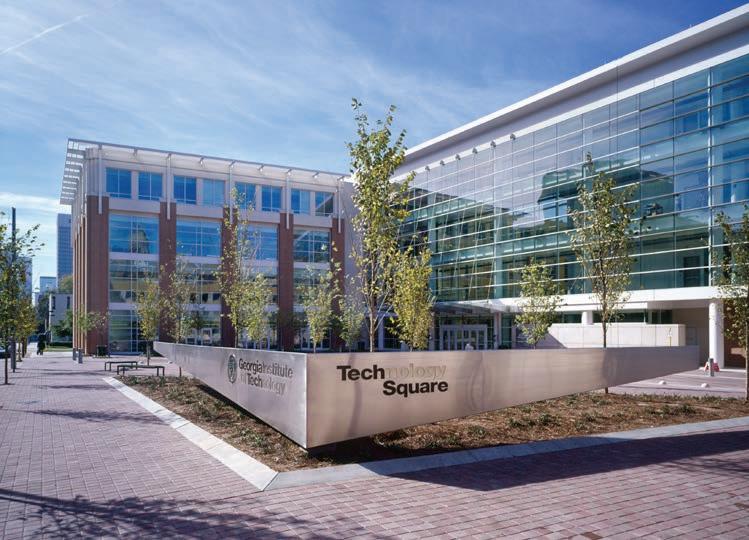



It's an honor to support the Georgia Tech Alumni Association student programs and the Gold & White Honors Gala.

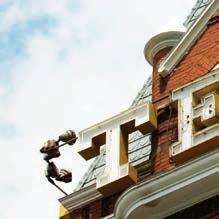
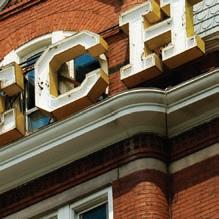




GTALUMNI.ORG/MAGAZINE | SPRING 2024 75
Honorees
Inspire is
includes
alo Wild
Jimmy
SONIC
global
50
LEARN MORE AT InspireBrands.com A RESTAURANT COMPANY UNLIKE ANY OTHER Empowering extraordinary leaders
CONGRATULATIONS TO THIS YEAR’S HONOREES! We are more than a company and a builder. We are a family of individuals with a passion to share our culture in ways that enhance and enrich the communities we serve. www.holderconstruction.com Holder Construction is proud to support The Gold & White Honors Gala. GOLD SPONSORS
a multi-brand restaurant company whose portfolio
more than 32,000 Arby’s, BaskinRobbins, Bu
Wings, Dunkin’,
John’s, and
restaurants across nearly 60
markets and all
states.
LET US WRECKSPLAIN
How does Buzz get to events without being seen?
When Buzz comes to an event, a student arrives 30 minutes early and is escorted discreetly by an event contact to a secret location.

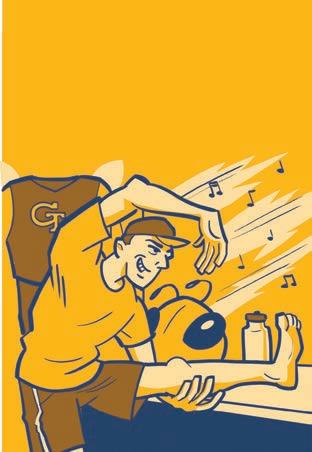
Buzz never changes in a restroom. There’s always a private, locked room where they can get into character. Each student has a different routine like listening to music or chugging water.
WE SPOKE WITH Jocelyn Kavanagh, MT 22, MS MT 23, technical director at the Georgia Tech School of Music, o cial Buzz Mascot Coordinator, and former Buzz herself, to get the details. “Buzz is one busy yellow jacket (not bee),” says Kavanagh. She explains that Buzz, the national 2023 mascot champion, attends every home football, volleyball, basketball, baseball, and so ball game, and a handful of special appearances at tennis matches and swim-and-dive meets. Buzz travels to football away games and represents Georgia Tech at all ACC championship and tournament games. “Buzz also
BIG HONORS
THE 2023 GOLDEN TEAMMATES were selected for living out the Georgia Tech Alumni Association’s values. The following staff members (pictured L-R) were chosen from 26 nominations: Ed Saunders, IT coordinator, for the value of Innovation. Saunders goes above and beyond to support the team. Beth Johnson, customer service specialist, for the value of Respect. Johnson was nominated for the kindness she shows at the front desk, where she greets everyone with respect and a
Got a campus-related question you’re dying to ask? Submit it at gtalumni.org/ Wrecksplain and we’ll find the answer.
Once prepared, the student suits up and struts into the event as Buzz, ready to bring Tech spirit!


goes to around 300 events on and o campus each year,” she says. Behind Buzz is a dedicated team of student-athletes who commit 20 hours a week on top of their demanding course loads. They meet twice a week for 3-hour practices and train three days a week in the weight room. What’s more, they manage Buzz’s social media, organize fundraisers, and support Buzz’s appearances. e students behind Buzz are only revealed at commencement when Buzz carries them across the stage. Before then, they keep their identity as Buzz a secret.

smile. Rachel Clark, student engagement coordinator, for the value of Community. Clark was recognized for her success in creating impactful communities in her work with new
alumni engagement and with the Student Ambassadors. Cristina Martin, biographical & gift processing coordinator, for the value of Integrity. Martin was chosen for her immense knowledge of alumni database processes and policies. Matt Sowell, copywriter, for the value of Collaboration. Sowell was nominated for establishing a cohesive brand voice for the Alumni Association’s “For a Lifetime” campaign.
76 SPRING 2024 | GTALUMNI.ORG/MAGAZINE
PHOTOGRAPH SCOTT DINERMAN, STC 03 ILLUSTRATION ROB ULLMAN
ALUMNI HOUSE




Find your career path with

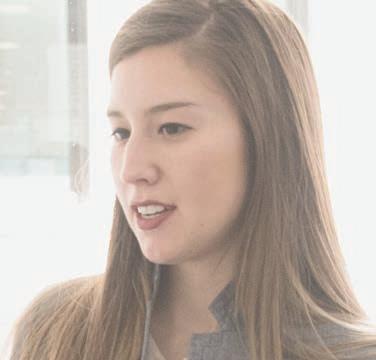

























today! connect.gtalumni.org Engage. Search hundreds of job listings and take advantage of development workshops. Connect. Chat with fellow Yellow Jackets in your field and beyond.












Network. Meet new mentors and reconnect with classmates.

























Register


RAMBLIN’ ROLL




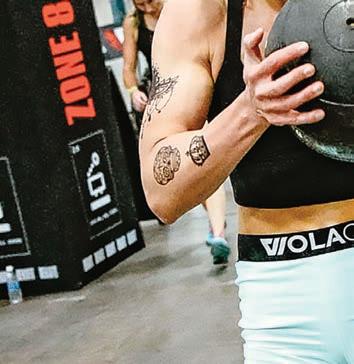
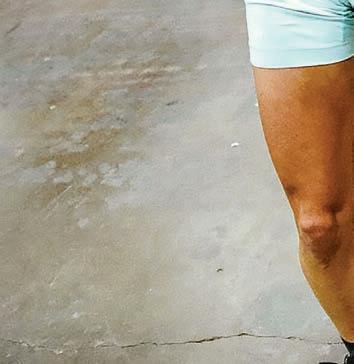





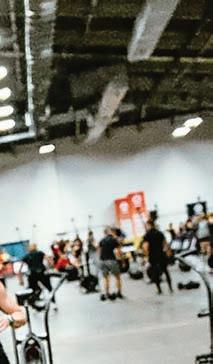




won first place in her age group at the 2023 Spartan Deka World Championships last December in Dallas, Texas. The Spartan Deka includes 10 challenging fitness exercises. She also earned a second-place finish in the Deka Strong Teams division with her teammate Valeria Dalmastro Mendez. Their time of 10:47 was just four seconds shy of the first-place finish. Already back in the gym, the two have their eyes set on a 2024 world

championship title.




| GTALUMNI.ORG/MAGAZINE
CLASS
NOTES & ALUMNI UPDATES
CLASS NOTES


LATANZA ADJEI, IE 98, has become senior vice president of Customer Experience, formerly named Customer Strategy and Solutions, for Georgia Power Company.
KENT BRITTON, MGT 92, assumed the role of chief executive officer at the Port of Corpus Christi on Sept. 6, 2023. Britton’s journey to this leadership position included nearly four years as the Port’s chief financial officer. His extensive career spans senior roles with industry giants like Alcoa and Glencore, as well as service with software and solutions provider Blackbaud.
JACKY CHENG, IE 17, is a recipient of the 2023 Young Nonprofit Professionals Network of Atlanta 30 Under 30 Nonprofit Leaders award. This accolade recognizes his leadership, innovation, and dedication to community service in Atlanta. Cheng was a recipient of the 2023 Gold & White Honors, receiving the Outstanding Young Alumnus distinction.

PIONEERING ARCHITECTURE ALUMNI RECEIVE CITY PROCLAMATION
THE ATLANTA CITY COUNCIL presented Ivenue Love-Stanley, Arch 77, and William J. Stanley, III, Arch 72, each with a city proclamation on Dec. 4, 2023, in recognition of their personal and professional contributions to the city through architecture.

The two Yellow Jackets were also recognized for their contributions to the Atlanta Way and for paving the way for Black students at Georgia Tech to follow in their footsteps. Their firm, Stanley, Love-Stanley, P.C., is responsible for several award-winning design projects, including the modernization
of the Hartsfield-Jackson Atlanta International Airport and the Olympic Aquatic Center.
Atlanta Mayor and fellow Yellow Jacket Andre Dickens, ChE 98, spoke at the ceremony, where Councilman Byron Amos presented the proclamations.
SIX YELLOW JACKETS CLAIM SPOTS ON FORBES’ ‘30 UNDER 30’
THE YOUNG ENTREPRENEURS on the 2024 Forbes “30 Under 30” list includes six Georgia Tech alumni. The annual list recognizes outstanding young achievers across 20 categories. The Yellow Jackets on this year’s list were recognized in consumer technology, energy, science, and manufacturing & industry.
CONSUMER TECHNOLOGY
VEDANT PRADEEP, CHBE 19, CMPE 19, CEO & Co-founder of Reframe
ENERGY

MAËL DISSEAU, AE 94, MS AE 95, PHD AE 02, was recently appointed to the Dr. Charles F. Stanley Chair of Theology at Truett McConnell University in Cleveland, Ga. Besides this role, he serves as an associate professor of Biblical and Theological Studies, chairs the Balthasar Hubmaier School of Theology and Missions, and now holds the position of dean of the College of Arts and Letters.


MICHAEL L. FULTON II, ME 21, appeared on the Portia television show, broadcast on FOX5 Atlanta. Fulton talked with the host about his company, Bizinc.
RYAN BABAIE, PHYS 20, Co-founder of Wattch
JARED DUNCAN, CS 19, Co-founder of Wattch
ALEX NUSSEY, CMPE 19, Co-founder of Wattch

SCIENCE

ANDREW SINGLETARY, ME 17, NRE 17, Co-founder of 3Laws Robotics
MANUFACTURING & INDUSTRY
IDICULA MATHEW, BME 17, CEO and Co-founder of Hera Health Solutions
GTALUMNI.ORG/MAGAZINE | SPRING 2024 79

JOHNSON NAMED PRESIDENT OF YOUNGSTOWN STATE UNIVERSITY
U.S. REP. BILL JOHNSON, MS ICS 84, became president of Youngstown State University in Ohio. In accepting his new role, Johnson said he will not seek an eighth term in Congress. He has represented eastern Ohio in the U.S. House since 2010. Prior to taking office, he served as chief information officer for a global manufacturer in the

transportation industry and co-founded an information technology consulting company. He served in the U.S. Air Force and has served as director of the Air Force’s Chief Information Officer Staff at U.S. Special Operations Command. He retired as a lieutenant colonel after a distinguished military career spanning two decades.
EIGHT YELLOW JACKETS NAMED ‘MOST INFLUENTIAL GEORGIANS’
EACH YEAR , Georgia Trend names the “100 Most Influential Georgians,” and eight Yellow Jackets earned recognition:
M. BRIAN BLAKE, EE 94, president of Georgia State University
ÁNGEL CABRERA, MS PSY 93, PHD PSY 95, president of Georgia Tech
LISA CUPID, ME 00, chair of the Cobb County Board of Commissioners
ANDRE DICKENS, CHE 98, mayor of the City of Atlanta
RODERICK McLEAN, MS EE 93, vice president and general manager of Air Mobility & Maritime Missions for Lockheed Martin
JANNINE MILLER, MBA 13, executive director of SRTA, GRTA, and Atlanta-Region Transit Link Authority
JERALD MITCHELL, MBA 11, president and CEO of The Greater Columbus Georgia Chamber of Commerce
DR. VALERIE MONTGOMERY RICE, CHEM 83, president and dean of Morehouse School of Medicine
PERCY LEADS ENGINEERING FOR NASA’S HUMAN LANDING SYSTEMS PROGRAM
THOMAS PERCY, MS AE 03, was appointed Systems Engineering and Integration (SE&I) manager for NASA’s Human Landing System program. In this role, his office will have a direct impact on the agency’s missions to return humans to the moon and to send humans to Mars.
Percy has served in various roles since joining NASA in 2016, including as the integrated performance lead for the Human Landing System and as a space systems analyst. He served as the chief architect of the Advanced
DONALD GREEN, MS
ARCH 11, was recognized by the U.S. Green Building Council Carolinas Chapter for his work in sustainable design and advocacy. He worked to implement the City of Charlotte’s new Strategic Energy Action Plan, and more recently, led the Buildings Working Group to aid the city’s Office of Sustainability in the development of the “Power Down the Crown” webpage.


KÄREN (SULLIVAN) HALEY, MGT 01, was named a 2023 Woman of Influence by The Indianapolis Business Journal. She was recognized for her work as the executive director for the Indianapolis Cultural Trail, Inc.
DRÉA LEWIS, STC 04, is the owner of Dream of Dréa LLC, which received the 2023 Invest Atlanta Creative Artist Grant, and was welcomed into the 2023 National Arts and Letters Film Festival inaugural cohort by Delta Sigma Theta Sorority, Inc. The LLC was also named a 2023 Atlanta Black Parade Route business, selected by the BeyGood Foundation.
KRISTYN LONG, BA 12, was named executive counsel for the Office of Georgia Governor Brian Kemp.
JOSCELYN MEJÍAS, MS BME 19, is one of five recipients of the 2023 L’Oréal For Women in Science Award.

Concepts Office at Marshall Space Flight Center, where he helped bring the Human Landing Systems program to fruition and where he was involved in the development of various robotic spacecraft concepts.
RAMBLIN’ ROLL
80 SPRING 24 | GTALUMNI.ORG/MAGAZINE
COL. ROBERT “BOBBY” O’KEEFE, IA 00, became the commandant and dean of the School of Advanced Air and Space Studies (SAASS) at Air University for the U.S. Air Force. O’Keefe was commissioned through Georgia Tech’s ROTC program in 2000.
FRED PUCCIANO, ARCH 74, MS ARCH 76, sold Studio for Housing Design to the Denver-based AE firm, the Galloway Company. Pucciano will remain with the company, serving as the regional team leader for a minimum of one year.
GEORGE RAY, MGT 09, PP 09, was named partner at the law firm of Nelson Mullins. Ray is a former trustee of the Georgia Tech Alumni Association Board.
BRIAN ROBINSON, EE 90, assumed the role of technical director at Great British Nuclear (GBN), a new entity under the British government. GBN’s mission is to oversee the government’s extensive nuclear program, aimed at delivering up to 24GW of nuclear power in the U.K. by 2050.
JEAN MARIE RICHARDSON, MGT 02, the CEO of iFOLIO, has been named the winner of a gold and silver Stevie Award in the Best Female Entrepreneur categories for Business Products in the 20th annual Stevie Awards for Women in Business. The Stevie Awards for Women in Business honor the achievements of women executives,
entrepreneurs, employees, and the companies they run worldwide.
NASHLIE SEPHUS, MS ECE 10, PHD ECE 14, received the BEYA 2024 Black Engineer of the Year award.
FRANKLIN G. SHULER, JR, MGT 77, has been elected to Turner Padget’s executive committee. Since joining Turner Padget in 1993, he has provided legal counsel to clients across South Carolina and also acts as a certified mediator named by the South Carolina Supreme Court.


WRECKS AT WORK
BIG DOGS AT WORK
JUSTIN NGUYEN, MS ME 12, applies analytics to help drive and differentiate Chewy’s nationally recognized customer experience. His best customer is also his programming buddy, Scarlett, who often falls asleep by his side. #WrecksAtWork
WRECKS AT WORK
The Alumni Association is celebrating the amazing work of our alumni. Send us your on-the-job selfies featuring cool views at gtalumni.org/wrecksatwork

GTALUMNI.ORG/MAGAZINE | SPRING 2024 81
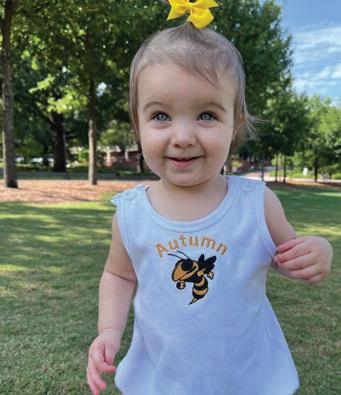
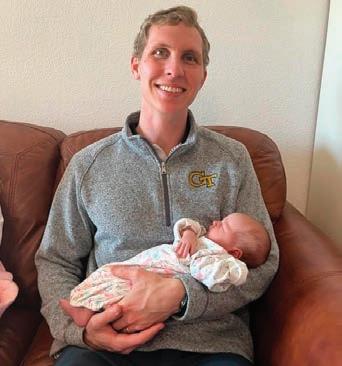

1. NOLAN ALEXANDER, BA 14, and LAURA ALEXANDER, IE 16, welcomed the birth of their daughter, Autumn, in July 2022. As former Reck Club members, they proudly dressed Autumn in White and Gold for her first campus visit.
2. MERRY HUNTER CAUDLE, PP 13, MBA 21, and DAN CAUDLE, IE 12, welcomed their daughter Kathleen “Kat” Dowling Caudle on Oct. 10, 2023.
3. ERIC JOHNSTON, BA 16, and his wife, Bree, welcomed their new daughter, Madeline, in December 2023.
OUT & ABOUT
ZOO CREW
AMANDA SMITH, IA 01, education outreach manager at Georgia Tech CEISMC, led a group of 20 K-12 teachers, which included two Georgia Tech alumni, on a visit to Zoo Atlanta. The visit featured a twilight trek and Bio-Inspired Design talk, all part of the newly launched Georgia Tech STEM Educators’ Network (GTSEN). GTSEN’s mission is to foster connections between K-12 STEM educators and the Georgia Tech community, facilitating collaboration, recognition, and support.
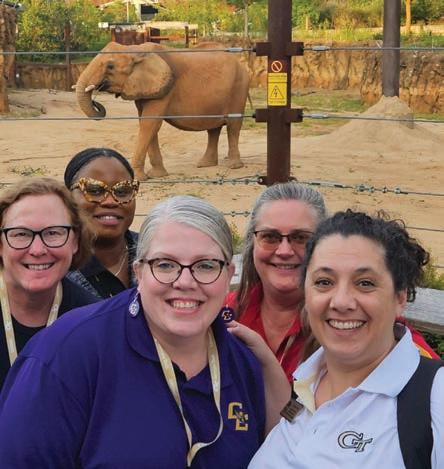
82 SPRING 24 | GTALUMNI.ORG/MAGAZINE RAMBLIN’ ROLL BIRTHS 1 3 2
WEDDINGS

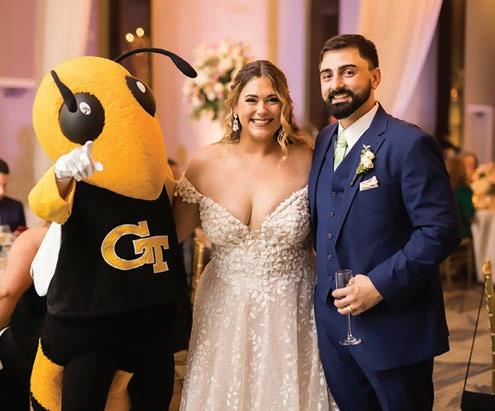
1. LAUREN BOHLING, BA 20, and TUCKER LOCICERO, CM 18, were married on Nov. 4, 2023, in Atlanta. Lauren has recently returned to Georgia Tech as a graduate student in the Online Master of Science in Computer Science program.
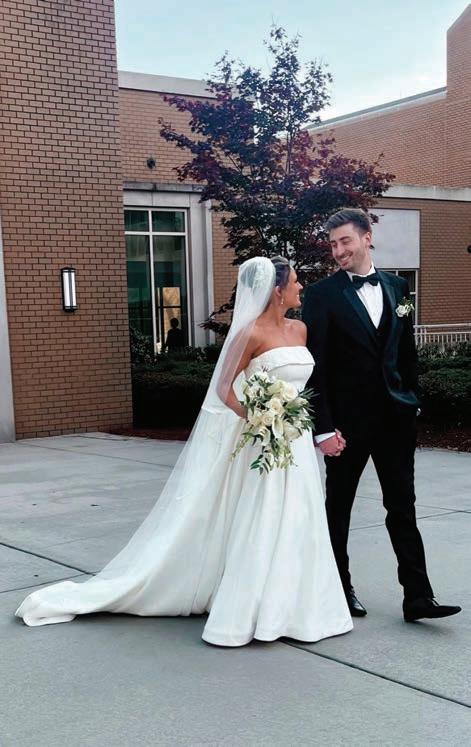
2. KAYLA (WILLIAMS) KRANENBURG, BA 19, and STEFAN KRANENBURG, AE 19, were married on Oct. 20, 2023. College sweethearts, they’re excited to start their future together!
3. ABBY PARNELL, IE 16, and JOE PELUSO, IE 14, were married on Sept. 30, 2023, in Midtown Atlanta. While they didn’t know each other at Georgia Tech, they met in Atlanta in 2020 and have been inseparable ever since. Georgia Tech is a strong tradition in Abby’s family, as her parents, CLAY PARNELL, IE 88, and KATHLEEN PARNELL, IE 89, also met at Georgia Tech and her sister, CLAIRE PARNELL, BME 17, met her husband, NICK McGILVRAY, EE 18, at Georgia Tech. Another Georgia Tech grad and close family friend, CATHERINE SINGER, IE 91, married the happy couple in September. Joe secretly worked with Buzz on a surprise appearance at their wedding reception! Joe is back at Georgia Tech as a student, working on a second degree in Computer Science.
GTALUMNI.ORG/MAGAZINE | SPRING 2024 83
1 3 2









IN MEMORIAM



















GTALUMNI.ORG/MAGAZINE
WE REMEMBER & HONOR THE FOLLOWING
1940 s
Armand Cifelli, Cls 45, of Sewall’s Point, Fla., on Aug. 18, 2023.
John B. Cummings, AE 46, of Brookhaven, Ga., on Dec. 6, 2023.
William J. Gilmore, TE 46, of Pensacola, Fla., on July 18, 2022.
John J. Glover, ChE 46, of Dallas, Texas, on Sept. 29, 2023.
Maurice W. Long, EE 47, MS Phys 57, PhD Phys 59, of Fernandina Beach, Fla., on Oct. 14, 2023.
Norman R. “Dick” Miller, IE 47, of Durham, N.C., on Oct. 25, 2023.
Gene T. Rice Sr., EE 49, of Elberton, Ga., on Jan. 29, 2023.
Irvin I. Rosenblum, EE 48, of Arcadia, Calif., on July 21, 2022.
1950 s
Alfred M. “Bud” Alexander, IE 52, of St. Petersburg, Fla., on Nov. 10, 2023.
Larry R. Baird Sr., TE 56, of Tallahassee, Fla., on Nov. 21, 2023.
David B. Baldwin, Chem 55, of Dallas, Texas, on Nov. 17, 2023.
Theodore T. “Ted” Bledsoe, ME 54, of Huntsville, Ala., on Oct. 17, 2023.
Patrick E. “Pat” Bolger, IE 57, of Allen, Texas, on Dec. 14, 2021.
MARILYN SOMERS: BELOVED FOUNDER OF THE LIVING HISTORY PROGRAM
MARILYN SOMERS, HON 08, of Atlanta, on Jan. 3. Through decades of pioneering work preserving Georgia Tech’s history, Marilyn Somers left an indelible mark on the Institute and touched the lives of thousands of Yellow Jackets in the process.
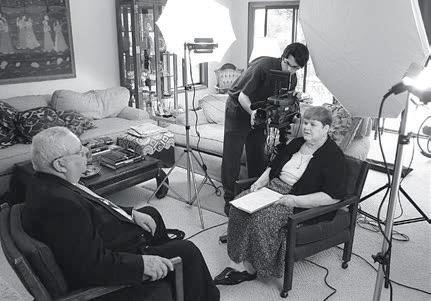
In 1994, Somers, then director of communication at the Georgia Tech Alumni Association, created the Living History Program after receiving a call from a nursing home asking for a recording of the fight song for an alumnus’s 100th birthday party. She served as the Living History Program’s director for 26 years before retiring on Dec. 31, 2020. During her time as director, Somers conducted 1,192 video interviews of alumni, faculty, and former staff members. Among those interviewed were Georgia Tech presidents, former President Jimmy Carter, astronauts, and even George P. Burdell.
The videos and transcripts from these interviews not only provide a more complete history of the Institute as told through the voices of those who lived its history, but the recordings have also become cherished mementos for families.
Somers’ impressive knowledge of the Institute and her ability to recall names and facts from memory made her Georgia Tech’s de facto historian. A natural storyteller, she captivated audiences each year with her popular Homecoming talks.
In 2008, the Alumni Association recognized her many contributions by naming her an honorary alumna.
To further commemorate her work preserving Tech’s history, the Marilyn Somers Living History Program Collection, 1994–2020, was unveiled in 2021. The collection is housed in the Georgia Tech Archives and Special Collections. The Georgia Historical Records Advisory Council recognized her decades of distinguished work with the 2021 Award for Excellence in Lifetime Achievement.
Somers most enjoyed working with students, often keeping in touch with her student interns long after they graduated. She started a newsletter for former interns to share family photos and news with her and each other.
Even in retirement, Somers continued to stay in touch with a vast network of alumni and friends whom she had met at Georgia Tech. She continued writing hundreds of birthday and holiday cards to alumni.
A Celebration of Life will be held April 27 from 2 to 4 p.m. at the Historic Academy of Medicine at 875 W. Peachtree St. NW.
Donations in honor of Somers can be made to the Marilyn Somers Endowment Fund for Living History and Archives in the Georgia Tech Library and the Brian L. Somers Fellowship Endowment in the School of Earth and Atmospheric Sciences.
GTALUMNI.ORG/MAGAZINE | SPRING 2024 85
Robert G. “Bob” Bowman, IM 56, of Marietta, Ga., on Oct. 24, 2023.
William P. Bryant Jr., IE 50, of Gallatin, Tenn., on Sept. 10, 2017.
Robert G. “Bob” Chenoweth Jr., ChE 53, of Charleston, W.Va., on Dec. 18, 2016.
Jong M. “Ming” Chew, ChE 57, of Honolulu, Hawaii, on May 19, 2023.
William H. Coley, IE 50, of Gainesville, Ga., on Nov. 20, 2023.
Elbert D. “Darrell” Crawford, IM 53, of Marietta, Ga., on Oct. 24, 2023.
John B. Day, IE 53, of Dublin, Ohio, on Nov. 16, 2023.
William F. Denson, ME 59, of Gainesville, Ga., on Oct. 27, 2023.
John R. Dillehay, IM 55, of Richmond, Va., on Nov. 23, 2023.
Thomas M. “Tom” Dixon Sr., EE 52, of Woodstock, Ga., on Dec. 8, 2023.
Harry G. Dulaney Jr., Phys 55, PhD Phys 62, of Marietta, Ga., on Aug. 16, 2023.
Robert S. Durling Jr., EE 58, of Pasadena, Md., on Oct. 19, 2023.
John A. Flinchum, ME 58, of Vero Beach, Fla., on April 24, 2021.
Robert F. “Bob” Fowler Jr., IE 54, of St. Simons Island, Ga., on Nov. 20, 2023.
William D. Gaulden, IE 52, of Easton, Md., on Oct. 7, 2023.
William D. “Bill” Griffiths, IE 55, of Reidsville, N.C., on Sept. 23, 2023.
Cuyler M. Gunn, IM 51, of Creedmoor, N.C., on Sept. 20, 2023.
Dalhart M. Handrop, IE 51, of Cumming, Ga., on Oct. 2, 2023.
Everett L. Hill Jr., ME 57, of Leesville, S.C., on Aug. 12, 2023.
Philip G. Howe, IM 59, of Atlantic Beach, Fla., on Oct. 6, 2023.
Douglas F. “Doug” Huie, ME 59, of Marietta, Ga., on Sept. 12, 2023.
John Hume, AE 58, of Peachtree City, Ga., on Sept. 25, 2023.
Richard H. Inman, ME 55, of South Glastonbury, Conn., on July 6, 2023.
Edward C. Jones, IM 52, of Cumming, Ga., on Nov. 20, 2023.
Martin J. Keller, IM 56, of Jasper, Ga.,on July 22, 2023.
Jerry C. Kelley, IE 57, of Savannah, Ga., on Oct. 20, 2023.
Blaine H. King, EE 51, of Glenville, N.Y., on Nov. 24, 2023.
Ralph W. King, IM 55, of Atlanta, on Nov. 8, 2023.
John A. Lasch, IM 59, of Indio, Calif., on Nov. 24, 2023.
Harry L. Mahl Jr., ChE 50, of Wilmington, N.C., on Oct. 20, 2023.
Richard J. Mannheimer, ChE 55, MS ChE 56, of San Antonio, Texas, on Oct. 30, 2023.
Claude A. McGinnis III, ChE 51, of Roswell, Ga., on Dec. 1, 2023.
Thomas R. McWhorter, CE 57, MS SanE 64, of Savannah, Ga., on Oct. 7, 2023.
Richard T. Mustin, ChE 58, of Old Fort, N.C., on Oct. 16, 2023.
Otis H. Ogburn, EE 59, of Desoto, Texas, on Oct. 24, 2023.
Floyd B. O’Neal, PhD Chem 59, of Augusta, Ga., on Oct. 14, 2023.
Robert J. Pegg, AE 59, of Hampton, Va., on Oct. 11, 2023.
Robert B. “Brooks” Powell, Arch 54, Arch 56, of Macon, Ga., on Nov. 9, 2023.
Richard B. Pratt Jr., TE 57, of Monroe, Ga., on Oct. 14, 2023.
Robert R. “Bob” Propp, EE 57, MS EE 58, of Newport Beach, Calif., on Oct. 23, 2023.
Gerald B. Rosenberger, EE 55, of Camp Hill, Pa., on Nov. 14, 2023.
Lawrence N. Sanders, IM 54, of Altus, Okla., on Oct. 19, 2023.
86 SPRING 2024 | GTALUMNI.ORG/MAGAZINE
IN MEMORIAM
BUCK SHAMBURGER, JR.: FOOTBALL STAR & ORIGINAL “DODD BOY”
ELLIS L. “BUCK” SHAMBURGER, JR., IM 55, of Atlanta, on Oct. 25, 2023. Family and friends remember Shamburger for his wonderful sense of humor, his love of all sports, and his genuine kindness. He loved making connections, and he fostered those relationships throughout his lifetime.
Shamburger was born in Meridian, Mississippi, but settled in Atlanta after graduating from Georgia Tech and serving as a pilot and lieutenant in the U.S. Air Force. An incredible athlete, he played football for Coach Bobby Dodd from 1951 to 1955 and was a proud member of the 1952 National Championship team. His love for Tech football never wavered. He organized a regular lunch group
with a number of former players and alumni. That group, now fondly referred to as the “Dodd Boys,” has grown to over 100 members. This unique group has been instrumental in raising money for a number of projects, including the iconic Bobby Dodd statue in the courtyard outside of the stadium.
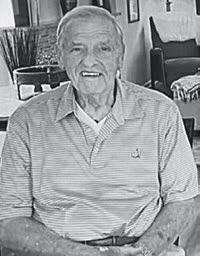
Although Shamburger was a salesman by trade, his true passion was coaching football. He coached many young men over 17 years at Northside Youth Organization at Chastain Park. Even after hanging up his whistle, he was never far from the sidelines and
Albert C. Sewell III, IM 56, of Memphis, Tenn.,on Oct. 17, 2023.
Carl F. Shaw, EE 58, of Atlanta,on Nov. 4, 2023.
Alfred A. Siess, CE 56, of Coopersburg, Pa., on Nov. 9, 2023.
Charles C. Space, ME 57, of Hoschton, Ga., on Sept. 29, 2023.
Robert B. Stephens, Cls 57, of Atlanta, on Nov. 5, 2023.
Robert L. Stephens, ME 57, of Doerun, Ga., on Oct. 27, 2023.
Robert O. Swift, IE 58, of Austin, Texas, on Nov. 28, 2023.
Harry E. Teasley Jr., IE 59, of Brunnen, Switzerland,on Oct. 9, 2023.
Jerry L. Terrell, IM 56, of Jacksonville, Fla., on Oct. 27, 2023.
Harry T. “Bud” Thurman Jr., IM 59, of Fort Mitchell, Ky., on Nov. 24, 2023.
Robert J. Vanden-Heuvel Jr., AE 51, of Shalimar, Fla., on Oct. 4, 2023.
Allen D. “Duane” Wills, IM 55, of Fairfax, Va., on Nov. 19, 2023.
Ernest W. “Walter” Wilson, IE 57, of Athens, Ga., on Nov. 5, 2023.
William H. “Bill” Wright, ChE 51, MS ChE 60, of Lexington, Va., on Nov. 26, 2023.
1960 s
Bobby R. Adams, Phys 64, of Augusta, Ga., on Nov. 24, 2023.
could always be found in the stands watching his 12 grandchildren’s sporting events.
Shamburger is survived by his three children: daughter Temple (Shamburger) Romberg and his two sons, Ellis L. “Bucky” Shamburger, III (Claire) and J. Denton Shamburger (Nancy), as well as the mother of his children, Joyce Temple Shamburger.
He is survived by 12 grandchildren and one great-granddaughter, who affectionately called him “PopPop.” He is also survived by his dear and devoted friend and companion, Angela Harvey.
Joe M. Ansley, IE 61, of Fort Worth, Texas, on Nov. 4, 2023.
Tracy A. Barnes, IM 65, of Easley, S.C., on Oct. 12, 2023.
Walker L. Baumgardner, IM 63, MS IM 64, of Gainesville, Ga., on Oct. 28, 2023.
Charles M. Bowen, IM 60, of Metter, Ga., on Sept. 23, 2023.
Nathaniel V. “Brad” Bradford, TE 60, of Bainbridge, Ga., on Oct. 24, 2023.
Michael B. Briles, Arch 62, Arch 64, of Annapolis, Md., on Nov. 20, 2023.
Ronald S. Brunsvold, AE 68, of Easton, Md., on Oct. 3, 2023.
GTALUMNI.ORG/MAGAZINE | SPRING 2024 87
James B. “Jim” Carey, AE 64, of Hernando, Miss., on Aug. 19, 2023.
Manson D. “Drew” Case, ME 66, of Hartsville, S.C.,on Nov. 2, 2023.
James A. “Jim” Cook Jr., IE 60, of Waynesboro, Va., on Oct. 26, 2023.
Donald L. Davis, CE 60, of Atlanta, on Dec. 27, 2023.
Robert F. “Bob” DeHaye, Phys 64, of Huntsville, Ala., on Nov. 5, 2023.
Spencer G. Edgar, TE 64, of Rome, Ga., on Oct. 21, 2023.
Roy C. Forward Jr., IM 60, of Greensboro, Ga., on Dec. 9, 2021.
John B. Hamrick, IM 65, of Roswell, Ga., on Nov. 4, 2023.
Karl H. Harms, IE 68, of Brunswick, Ga., on Sept. 23, 2023.
Gareth S. Harris, Phys 65, of Austin, Texas, on Oct. 23, 2023.
Robert D. “Bob” Hayes, IM 62, of Toledo, Ohio, on Sept. 30, 2023.
John L. Herbert, IM 65, of Griffin, Ga., on Oct. 9, 2023.
James K. “Jim” Humphries, IM 63, of Winston-Salem, N.C., on Sept. 25, 2023.
Edwin B. Jelks III, IM 63, of St. Petersburg, Fla., on Nov. 5, 2023.
Robert A. Jenkins, IM 68, of St. Simons Island, Ga., on Nov. 6, 2023.
William H. Johnson, IM 68, of Smyrna, Ga., on Nov. 3, 2023.
Robert H. Kirkland, Arch 65, of Sautee Nacoochee, Ga., on Nov. 7, 2023.
Manfred W. Klein, IE 61, of Orange Beach, Ala., on Sept. 4, 2023.
Alvin C. Levy, ChEM 64, MS Chem 67, PhD Chem 76, of Dunwoody, Ga., on Oct. 20, 2023.
William C. “Carl” Lineberger, EE 61, MS EE 63, PhD EE 65, of Boulder, Colo., on Oct. 17, 2023.
Gerald D. “Jerry” McInvale, IE 67, of Newnan, Ga., on Sept. 7, 2022.
William W. McKee Jr., CE 60, of Spring, Texas, on Oct. 20, 2023.
John T. Means, IM 62, of Cumming, Ga., on Sept. 23, 2023.
George E. Mouchahoir, MS CE 68, M CP 69, PhD CE 70, of Vienna, Va., on June 5, 2020.
Frank C. Moye, IM 66, of Avera, Ga., on Nov. 18, 2023.
Walter W. Mullen Jr., EE 62, of Wetumpka, Ala., on Oct. 30, 2023.
Ronald A. Ostertag, IE 67, of Sonoma, Calif., on Oct. 22, 2023.
Apostolos N. Papadea, TE 64, of Columbia, S.C., on Oct. 15, 2023.
Kevin M. Phillips, IM 67, of Miami, Fla., on May 5, 2023.
Joseph A. “Joe” Pleasants, Chem 64, of Hoschton, Ga., on Nov. 8, 2021.
Ray Pope Jr., CE 65, of Richland, Wash., on Nov. 4, 2023.
Robert M. “Bob” Reznik, EE 62, of Atlanta, on Oct. 27, 2023.
John B. “Byers” Rogan, ME 69, of Roswell, Ga., on Nov. 17, 2023.
Gary C. Schuler, Cls 61, of Denver, Colo., on Oct. 22, 2023.
James P. “Jimmy” Seward Jr., IM 66, of Valdosta, Ga., on Oct. 31, 2023.
Jack W. Shelton, EE 66, of Jupiter, Fla., on Nov. 11, 2023.
Coleman D. Smith, CE 65, of Hartselle, Ala., on Nov. 20, 2023.
Richard “Rich” Stephens, IE 66, of Travelers Rest, S.C., on Sept. 24, 2023.
Eugene L. “Gene” Surber, Arch 61, Arch 65, of Atlanta, on Dec. 12, 2023.
Lucius H. “Harold” Usher, ME 61, of Ringgold, Ga., on Sept. 21, 2023.
Robert E. Walters, CE 68, of Golden, Colo., on Sept. 12, 2023.
Bobby D. Widdice, MS CE 68, of Seattle, Wash., on Feb. 6, 2023.
88 SPRING 2024 | GTALUMNI.ORG/MAGAZINE IN MEMORIAM
1970 s
Charles W. Alexander, CE 70, of Buckhead, Ga., on Nov. 17, 2023.
Larry D. Carroll, TE 70, of Lawrenceville, Ga., on Nov. 17, 2023.
Stephen W. Day, EES 74, of Dacula, Ga., on Oct. 30, 2023.
Tommy W. Dempsey, IM 79, of Peachtree City, Ga., on Nov. 24, 2023.
William D. Denson, Cls 72, of Hot Springs Village,Ark., on Nov. 18, 2023.
James M. Dougherty, MS CE 73, of Naples, Fla., on Oct. 26, 2023.
Van E. Epps, Arch 71, of Canton, Ga., on Nov. 6, 2023.
Mark E. Fierberg, BC 79, of West Hartford, Conn., on Nov. 4, 2023.
Steven W. Fox, ChE 76, of Denton, Texas, on Oct. 6, 2023.
Thomas F. Fox, MS IM 77, of Douglasville, Ga., on Oct. 16, 2023.
Robyn P. Henderson Jr., IE 70, of Loganville, Ga., on Oct. 14, 2023.
Marion T. “Tony” Henderson, Mgt 72, of Albany, Ga., on Sept. 11, 2023.
Norris W. Hendrix III, IM 70, of Wilson, N.C., on Oct. 19, 2023.
TERRY L. MAPLE: TRANSFORMATIVE ZOO LEADER & FORMER PROFESSOR
TERRY L. MAPLE, of Atlanta, on Dec. 3, 2023. Dr. Terry Maple, who is best known for transforming Atlanta’s zoo, touched countless lives, both two- and four-legged. Tasked by then-Atlanta Mayor Andrew Young with turning around the Atlanta zoo in the 1980s, Maple created a capable core team, raised money, and instituted an expansive rebuild and rebranding program. The program included the birth of the moniker Zoo Atlanta, establishing corporate partnerships that helped foot the bills, and transforming the zoo into a top-drawer educational and research facility. All this was in the span of just a few years.
“He was a dynamic man,” said Gail Eaton, who once served the zoo as vice president of marketing and communications under Maple. “He knew what he wanted and he kept going until he got it.”
Combining his relentless optimism with canny marketing, he used tools such as the zoo’s best-known resident, gorilla Willie B., and local media to get the community behind his plans.
Friends and family say a bond with animals infused Maple’s childhood, igniting a passion that led to a PhD in psychobiology at the University of California-Davis and later his professorship at Georgia Tech before he came to the Atlanta zoo.
Maple kept a part-time position with the Institute while running Zoo Atlanta.
EDITOR’S NOTE
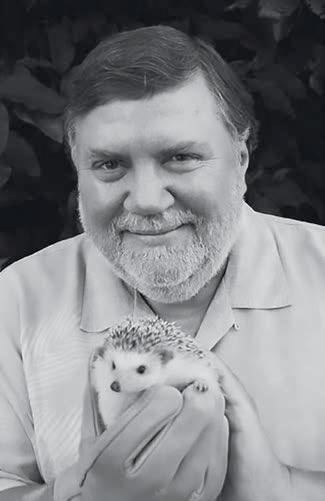
He brought Georgia Tech graduate psychology students to Grant Park to study all animals great and small. In 2022, he reflected on his dual roles as zoo leader and professor, telling the Alumni Magazine , “It opened the door for all my students to get a very unique opportunity. We had a tabula rasa, and so for 18 years, and even after that, my students and I just really changed that zoo, and we studied that change.”
The veteran zoo administrator left the zoo in 2002, returning to Georgia Tech, and later helming the Palm Beach Zoo. Through his time at Georgia Tech, Maple inspired a herd of students to pursue careers in zoology and conservation around the world.
For the In Memoriam section of the Georgia Tech Alumni Magazine, we will include an abbreviated version of each obituary in print. Full obituaries can be found at gtalumni.org/InMemoriam. To report a death, please email bioupdate@gtalumni.org.
GTALUMNI.ORG/MAGAZINE | SPRING 2024 89
William K. Jann Jr., Chem 74, of Atlanta, on Sept. 20, 2023.
Alan B. Mann, EE 71, of Chapel Hill, N.C., on June 23, 2017.
Michael R. Nicholson, Cls 73, of Vilas, N.C., on Oct. 27, 2023.
Allyn J. Palmer, MS IE 71, of Jacksonville, Fla., on Oct. 23, 2023.
Jacobo E. Simonet, IE 71, of Atlanta,on July 2, 2020.
Daniel F. Skelley, Math 70, MS Math 72, of Columbus, Ga.,on Nov. 6, 2023.
Gerald W. Staton Jr., Chem 72, of Maggie Valley, N.C., on Nov. 30, 2023.
Gary T. Steele, IM 70, of San Mateo, Calif., on Sept. 1, 2023.
John L. Wallace, ME 75, of Mansfield, Ga., on Nov. 6, 2023.
David T. Wells, CE 77, of Ponte Vedra Beach, Fla., on Sept. 18, 2023.
James H. Wheeler, NE 74, of Navasota, Texas, on Sept. 23, 2023.
Ghulam J. Zalmai, IE 70, MS EE 74, MS IE 74, PhD IE 78, of Marquette, Mich., on March 31, 2023.
1980 s
Walter C. Barry, Phys 81, MS EE 82, of Toano, Va., on Nov. 20, 2023.
Sarah R. Flynn, MS Phys 82, of
Decatur, Ga., on Oct. 11, 2023.
Douglas N. “Doug” Fuller, IE 82, of Roswell, Ga., on Oct. 19, 2023.
Michael W. Ginn, MS CerE 80, of Sandersville, Ga.,on Oct. 7, 2023.
Kenneth W. Hawkins, EE 81, of Stockbridge, Ga., on Oct. 27, 2023.
Robert E. Hawkins, MS EE 87, of Bacliff, Texas, on Oct. 19, 2023.
Gregory J. Hembree, EE 88, of Clearwater, Fla., on Nov. 7, 2021.
Jacquelyn A. “Jackie” (Boswell) Hightower, IE 85, of Winter Park, Fla.,on Nov. 15, 2023.
Grant R. Petersen, Mgt 84, of Taylor, Mich., on Aug. 7, 2023.
James R. “Jim” Poole, EE 88, of Roswell, Ga., on Oct. 6, 2023.
George P. Russell Jr., Econ 80, of Canton, Ga., on Oct. 7, 2023.
Kirk A. Rutland, AE 82, of Manchester, Tenn., on Oct. 19, 2023.
Nelson L. Wright, InfoSci 85, of Atlanta, on Nov. 18, 2023.
1990 s
James T. “Jim” Bell, MS ME 98, of Dallas, Ga., on Nov. 1, 2023.
Brian K. Deakin, IE 93, of Stockbridge, Ga.,on Oct. 9, 2023.
Ronald W. Mills, MS MoT 99, of Smyrna, Ga., on Nov. 27, 2023.
Alan G. Roberts Jr., ME 95, of Moore, S.C., on Oct. 1, 2023.
Richard R. “Rich” Wallace, MS TSP 91, of Ann Arbor, Mich., on Oct. 6, 2023.
2000 s
Katy E. Aultman, IA 00, of Annapolis, Md., on Oct. 24, 2023.
Cody B. Broome, Mgt 02, of Valdosta, Ga., on Nov. 24, 2023.
William F. Haber, MS BC 04, of Roswell, Ga., on Sept. 6, 2022.
Nicole M. Jones, ChE 03, of Atlanta, on Sept. 18, 2023.
Ferdinand H. Pietz, MS PP 03, of Avondale Estates, Ga., on Nov. 1, 2023.
Eric N. Reynolds, Mgt 00, of Fayetteville, Ga.,on Oct. 23, 2023.
Michael R. Stewart, CmpE 06, of Daly City, Calif., on Oct. 7, 2023.
Anna M. “Mitchi” (McKnight) Wade, Mgt 00, of Columbus, Ga., on Nov. 3, 2023.
2010 s
Erika N. (Dommond) Anderson, ME 14, of Beaumont, Texas, on Sept. 20, 2023.
Christopher K. Brakhage, Cls 13, of Atlanta, on Sept. 16, 2023.
IN MEMORIAM 90 SPRING 2024 | GTALUMNI.ORG/MAGAZINE
Brian F. Palmer, EE 13, of Sonoma, Calif., on Oct. 19, 2023.
2020 s
Brian D. Ellingson, MS CS 21, of Rockledge, Fla., on Oct. 7, 2023.
FRIENDS
Gregory M. Colson, of Smyrna, Ga., on Oct. 6, 2020.
Ann H. David, of Bedminster, N.J., on Oct. 21, 2023.
Marvin G. Mitchell, of Chattanooga, Tenn.,on Feb. 18, 2022.
Steve Taylor, of Atlanta, on March 25, 2023.
MICHAEL NICHOLSON: COFOUNDER OF MELLOW MUSHROOM
MICHAEL R. NICHOLSON, CLS 73, of Vilas, N.C., on Oct. 27, 2023.Michael
Nicholson lived a life marked by patience, kindness, generosity, and love for others.
Nicholson was born in Rabun County, Ga., and lived most of his life in northeast Georgia before retiring to Vilas, N.C. After attending Georgia Tech, he co-founded the Mellow Mushroom restaurant chain in 1974 with fellow Yellow Jacket Rocky Reeves, IM 79, and later a third partner. Their first restaurant was opened on Spring Street, and their business grew into one of the top 100 pizza companies in the country.
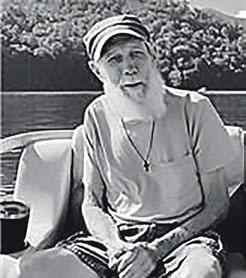
Timothy Orthodox Church in Toccoa, Ga., and Saints Peter and Paul Orthodox Church in Jefferson, N.C.A beloved father and grandfather, his patience was endless, his advice was measured and practical, and the example he set was one of selflessness and simplicity.
Nicholson was a member of St.
He is survived by his children: Sierra Nicholson (Ryan Hull), Zachary (Lindsay), Anna Shinafelt (Justin), Lily Ippolito (Scott), Luke (Allison Game), Zane, Seth, and Jude, as well as five grandchildren, sisters June Thomas and Ruth Smith, and brothers Kenneth (Brenda) and Roy.
JAMES “JIM” REEDY: FORMER PROFESSOR & DEPARTMENT CHAIR
JAMES A. “JIM” REEDY , of Atlanta, on Oct. 4, 2023. Reedy, a former professor and department chair in the College of Sciences, joined Georgia Tech in 1978. He served as department chair for 20 years and retired in 2000. He led major changes across his unit, the college’s former Department of Health & Physical Education. “Dr. Reedy was a charismatic, passionate, and gifted administrator who had a lasting impact on the GT community,” said Phillip Sparling, professor emeritus in the School of Biological Sciences.

Reedy began his career at Bridgewater College and finished at Georgia Tech. A life-long educator, he served in many roles including teacher, coach, athletic director, and college administrator. He graduated from John Marshall High School in Richmond, Virginia, and Bridgewater College, where he is in the Hall of Fame for men’s basketball.
integrity and dedication to the field of health and physical education.
Reedy enjoyed daily exercise, delicious food, a good old movie, anything sports related, and especially time with family. He had a gift for storytelling and could captivate an audience with his humorous tales and poems. Over the past several years, he began to write novels and had several published.
He earned a master’s degree from Long Beach State and a doctorate degree from Vanderbilt University. He had a strong Christian faith grounded in his youth and his parents’ teachings. This led to a work ethic that was admired for its
Reedy was preceded in death by his parents Corbett and Lelia Reedy, loving wife Kay Reedy, and sister Nancy Olson. He is survived by his children: Jody Reedy Andrade (Billy), Betsy Reedy Sawyer (Ryan), Bryan Dunlap (Kelley), Bo Dunlap (Jill), and Greg Kershner (Leigh), and 14 grandchildren.
GTALUMNI.ORG/MAGAZINE | SPRING 2024 91

THE BIG MOMENT
“THE SOUTH STANDS AT ARMAGEDDON”: GEORGIA TECH AND THE RACIAL POLITICS OF THE 1956 SUGAR BOWL
IIN 1961 , Georgia Tech integrated peacefully, without a court order—the first university in the Deep South to do so. Perhaps less well known is the Institute’s role in an earlier step toward racial integration: the 1956 Sugar Bowl.
At the time, Tech belonged to the Southeastern Conference and commanded respect as a national football powerhouse. Under Coach Bobby Dodd, the team earned its third national championship in 1952 (shared with Michigan State) and enjoyed successive winning seasons, including multiple victories against the University of Georgia and in bowl games. So when the Yellow Jackets accepted an invitation to the Sugar Bowl, Tech supporters didn’t expect anything other than a possibly hard-fought win in New Orleans against the University of Pittsburgh Panthers.
This all changed when political officials in Georgia— staunch segregationists who had taken an openly defiant stance toward the U.S. Supreme Court’s 1954 Brown v. Board of Education ruling—discovered that the Panthers fielded an
 BY SHELLEY WUNDERSMITH
BY SHELLEY WUNDERSMITH
integrated team. Pitt had one Black player, fullback Bobby Grier. And Grier’s appearance in New Orleans would make the Sugar Bowl the Deep South’s first racially integrated bowl game.
What followed was a storm that entangled politics and athletics and, for about a month, focused the eyes of the nation on Georgia. Governor Marvin Griffin demanded that the Yellow Jackets not go to the Sugar Bowl. At the prospect of their beloved Jackets being barred from play, Tech students rioted and burned the governor in effigy. After much contention, the University System of Georgia’s Board of Regents (BOR) voted overwhelmingly to allow the Institute to fulfill its signed contract with the Sugar Bowl. This was not exactly an achievement for integration, however. The BOR also mandated that no desegregated games, including teams and audiences, would be played within Georgia’s borders—a rule that was ultimately never enforced.
That said, the game itself represented a step toward racial equality. When Tech and Pitt met in Tulane Stadium on Jan. 2, 1956, no racial incidents occurred, and the
92 SPRING 2024 | GTALUMNI.ORG/MAGAZINE TECH HISTORY




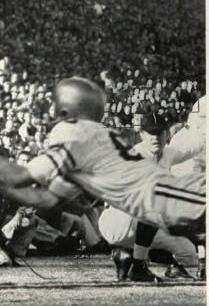
Georgia Tech–specific milestones
Black athletes in sports milestones
Civil Rights milestones
1889 Three Black students—William Henry Lewis (Amherst), W.T.S. Jackson (Amherst), and Thomas James Fisher (Beloit)—break the color barrier for college football.
1892 Georgia Tech fields its inaugural, all-white football team.







1896 The U.S. Supreme Court upholds Plessy v. Ferguson, enshrining racial segregation as a means of keeping whites and non-whites “separate but equal.”
1899 Marshall Taylor, “the Black Cyclone,” wins the onemile cycling sprint at the World Track Championships in Montreal—the first Black American to become a world champion in any sport, and only the second Black athlete in the world to do so.



overwhelmingly white, Southern crowd clapped for and cheered Grier’s performance.
According to Georgia Tech Professor Johnny Smith, who teaches a class on the history of American sports, “The color line was smudged here and there, erased and then redrawn. The history of civil rights and racial progress is complicated. Sometimes victories were followed by two steps backward.”
1904 Georgia Tech hires John Heisman as college football’s first paid coach.
1917 Tech wins its first national college football championship.
1920 Fritz Pollard joins the Akron Pros as both coach and star player. He is the first Black coach in the National Football League. The next year he leads the Akron Pros to their first NFL championship.
1928 Tech defeats the University of California in the Rose Bowl (Jan. 1, 1929), the Jackets’ first-ever bowl appearance, and earns its second national championship.
1934 Georgia Tech refuses to play the University of Michigan until the Wolverines agree to keep Black star end Willis Ward on the sidelines. Under the “gentlemen’s agreement,” Georgia Tech benches star end Hoot Gibson in return.
THE “GENTLEMEN’S AGREEMENT”
Events after the Sugar Bowl exemplified this. While the national Civil Rights Movement rapidly accelerated, Louisiana politicians, in an attempt to enforce segregation, passed Act 257, prohibiting integrated sports within the state. The Sugar Bowl did not host another Northern team for eight more years. On the other hand, just four years later, three young men set foot on campus as the Institute’s first Black students.
As college sports grew in popularity in the late 1800s, segregated universities—most of them in the South—pushed to keep teams all-white. After 1910, many Northern universities began integrating their teams but informally agreed to keep their Black players out of games played in the South; in return, Southern schools would bench their players of similar skill and talent to ensure a fair contest. This was the so-called “gentlemen’s agreement.” Eventually, Northern schools balked at leaving their Black players on the sidelines, and so some Southern schools quietly acquiesced to playing opponents with integrated teams—when the games took place above the Mason-Dixon line. Georgia Tech and UGA each played against integrated teams in the early 1950s.
1935 The Sugar Bowl is established. It is racially segregated.
1947 Jackie Robinson joins the Brooklyn Dodgers as Major League Baseball’s first Black player.
GTALUMNI.ORG/MAGAZINE | SPRING 2024 93
TECH HISTORY
1948 President Harry Truman signs an executive order ending segregation in the U.S. military services.
In Dallas, Texas, the Cotton Bowl hosts its first integrated game.
At the London Olympics, American Alice Coachman becomes the first Black female athlete to win a gold medal—for the high jump.
1952 President Blake Van Leer opens the Institute to female students for the first time.
Michigan State and Georgia Tech, both undefeated, are designated national football co-champions.
1953 Georgia Tech plays an integrated Notre Dame football team at South Bend, Indiana. Notre Dame wins (27-14), breaking Tech’s 31-game winning streak. The Sun Bowl, held in El Paso, Texas, holds its first integrated game.
1954 The Supreme Court rules segregated schools are unlawful in Brown v. Board of Education.
1955 August 28: Fourteen-year-old Emmett Till is lynched in Mississippi. His two murderers, white men, are later acquitted by an all-white, all-male jury.
November 22: Sugar Bowl officials formally invite the Pittsburgh Panthers, a racially integrated team, to play in the Sugar Bowl. Although Tulane Stadium is segregated, officials will permit the Pitt spectator section to be unsegregated.
November 26: At the annual Georgia Tech–UGA rivalry match, President Van Leer casually mentions to newly elected Georgia Governor Marvin Griffin that should Tech prevail, the Yellow Jackets will receive—and accept—an invitation to play in the Sugar Bowl. “Fine,” is the governor’s response. Tech wins, 21-3.
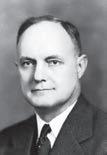


1955 cont’d
Georgia Tech–specific milestones
Black athletes in sports milestones
Civil Rights milestones
That same weekend, Dodd polls his Yellow Jackets regarding the Sugar Bowl invitation, noting they will play against an integrated Pittsburgh team. The entire team votes to play.
THE TEAM VOTES

Later, when the press eventually asked Tech’s star quarterback Wade Mitchell, Text 57, for his opinion about the furor, he said, “I personally have no objection to playing a team with a [Black] member on it, and, as far as I know, the rest of the boys felt the same way.”




November 29: Coach Dodd receives a telegram from former U.S. Ambassador Hugh Grant, one of the founders of the segregationist group the States’ Rights Council of Georgia, urging Dodd to uphold “our laws, customs, and traditions of segregation.”
Dodd gives the telegram to Van Leer and informs Griffin about it. A Griffin aide tells Dodd “not to worry about it.”
November 30: Robert Arnold, chairman of Georgia’s Board of Regents (BOR), which oversees Georgia’s higher-education institutions, notes that both Georgia Tech and UGA have previously played integrated teams (in the North). Arnold says he will not bring up the question of whether Tech should play in the Sugar Bowl because the BOR does not supervise the schools’ athletic events.
December 1: Rosa Parks refuses to give up her bus seat to a white man, which eventually leads to the months-long Montgomery Bus Boycott. The following November, the Supreme Court rules that segregated buses are unconstitutional.
December 2: Governor Griffin sends his now-infamous segregationist screed to the BOR. His telegram declares, “The South stands at Armageddon,” and demands that the regents prevent the Yellow Jackets from playing in the Sugar Bowl.
GOVERNOR GRIFFIN’S STANCE
“The South stands at Armageddon. The battle is joined. We cannot make the slightest concession to the enemy in this dark and lamentable hour of struggle. There is no more difference in compromising integrity of race on the playing field than in doing so in the classrooms. One break in the dike and the relentless enemy will rush in and destroy us.” —Text of Griffin’s telegram to the Board of Regents dated Dec. 2, 1955
Meanwhile, the University of Pittsburgh announces that Grier will go to the Sugar Bowl and will “travel, eat, live, practice, and play” with the rest of the Panthers.
Late that evening, a crowd of around 2,500 students and supporters of Georgia Tech riot in protest of Griffin’s stance.
94
THE STUDENTS PROTEST
Around 2,500 Tech students protested Griffin’s stance. They were not all rioting on behalf of racial justice. Rather, as Charles Griffin (no relation to the governor), a Tech freshman at the time of the riot, recently recalled, “We did not want to be denied the chance to play in the Sugar Bowl. Our team had a good record, and it just didn’t make sense. We decided we needed to do something about it, and we realized that if we only had a small crowd, the governor could chalk the protest up to the Northern students. So we went through all the dorms and got the students to all come out. We gathered at Peters Park and lit a bonfire.”
The crowd went to Little Five Points, where they hung an effigy of the governor from a light post. Charles Griffin explained, “My father worked for the railroad, and I had gotten a railroad flare from him and used it to light the dummy on fire. Then everyone marched up to the Capitol, where some of them tore up the bushes around the building and again burned the governor’s effigy.”
By 1:30 early the next morning, the crowd had gathered at the governor’s mansion, where Gov. Griffin was inside

with the lights off. They were eventually convinced to disperse by a former Tech football player and state legislator, Milton M. Smith, who promised the protesters that Tech would go to New Orleans. The governor had been burned in effigy at least three times during the evening.
Tech’s quarterback, Wade Mitchell, would later tell his son, Wright, that his most vivid pre-game memory was “standing at his dorm room window, watching the students march up Techwood Drive toward the governor’s mansion” (at the time located in Ansley Park). Mitchell did not participate in the protest because
December 4: A front-page editorial in the Atlanta Journal calls the Sugar Bowl controversy “Griffin’s Teapot Tempest” and excoriates the governor for possibly damaging the state’s reputation among prospective business interests.
Georgia Tech’s student body president, George Harris, apologizes via telegram to the University of Pittsburgh for the governor’s actions, saying, “We look forward to seeing your entire team and student body in the Sugar Bowl.” Pitt’s student government responded with a telegram of their own: “The Pitt student body greatly appreciates the spirit shown by the Georgia Tech student body. We are looking forward to a great game on Jan. 2.”
THE GAME AND AFTER
The Yellow Jackets–Panthers clash was a fierce defensive struggle. After a call against Grier with seconds left in the game, Georgia Tech won, 7-0. While the call was controversial, and the referee later admitted it was a mistake, no one thought it was racially motivated. Grier was the game’s leading rusher, with 51 yards.
Following the game, a banquet honoring the two teams was held at New Orleans’ St. Charles Hotel, which had a segregationist policy. When Grier got off the bus at the hotel, several Georgia Tech players asked him to eat with them, an invitation he accepted. Grier said later he assumed these were Northern players, but in actuality, the entire Yellow Jackets team was from the South.

Coach Dodd had told his players to “focus on football, not politics.”
Despite Dodd’s dictate, however, some football players joined the crowd of protesters. Carl Vereen, IM 57, a junior tackle on the 1956 team, recently said, “I participated, and there were quite a number of other players who did as well. We wanted to be allowed to play.”
On December 5, most unusually, a large crowd of UGA students gathered in support of the Tech protesters, carrying signs that read, “For Once, We’re for Tech.” Smaller groups of Emory and Mercer students also burned the governor in effigy on Tech’s behalf.
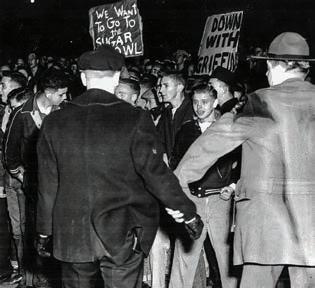
Students from Tech and UGA protested together.
December 5: The BOR convenes a special session to decide whether Georgia Tech can play in the Sugar Bowl. After several hours of debate, Van Leer declares, “Either we’re going to the Sugar Bowl, or you can find yourself another damn president of Georgia Tech.”
The BOR settles the matter by voting to allow Tech to adhere to its previously signed contract with the Sugar Bowl. However, it also upholds the state’s segregationist policies, mandating that no integrated games (teams or audiences) will be played within Georgia’s borders.
1956 January 2: The No. 7–ranked Yellow Jackets play the No. 11–ranked Pittsburgh Panthers in New Orleans. Pitt fullback Bobby Grier takes the field, making this the first racially integrated bowl game in the Deep South.
January 24: President Van Leer dies of a heart attack, attributed to the stress of events surrounding the Sugar Bowl.



March: 19 U.S. senators and 77 U.S. representatives sign the “Southern Manifesto,” pledging to oppose racial integration.
December 29: Georgia Tech and Pitt meet for a rematch, this time in the Gator Bowl. Tech prevails, 21-14. This is Wade Mitchell’s last turn at QB for the Yellow Jackets; Grier had already graduated and as such did not play.
GTALUMNI.ORG/MAGAZINE | SPRING 2024 95
1955 cont’d
1955 cont’d
Charles Griffin pictured at the student protest.
TECH HISTORY
1960 By a large majority, Georgia Tech students vote to give qualified applicants admission to the Institute, regardless of race.
1961 The Freedom Rides begin, a seven-month campaign to test the Supreme Court ruling (Boynton v. Virginia, 1960) in favor of desegregated interstate travel.
1975 Jan Hilliard becomes Tech’s first Black female student-athlete to play for and letter in women’s basketball.
Arthur Ashe defeats defending champion Jimmy Connors, becoming the first Black men’s tennis player to win at Wimbledon.



making the Institute the South
Three Black students— Ford C. Greene, Ralph A. Long, Jr., and Lawrence Williams—begin attending classes at Tech, making the Institute the first university in the Deep South to be integrated peacefully, without a court order.
1963 The March on Washington is attended by over 250,000 Americans of all races.
1964 President Lyndon Johnson signs the Civil Rights Act into law, ending discrimination on the basis of race, sex, religion, and national origin.

Ronald Yancey earns an undergraduate degree in electrical engineering, becoming Tech’s first Black alumnus.
President Johnson also signs the Voting Rights Act into law.
1967 Harvey Webb, a first-year Black student, plays for Tech’s freshman men’s basketball team against UGA.
1969 Karl Barnes walks on to the football team, eventually becoming Tech’s first Black student-athlete and letterwinner to graduate. Barnes goes on to earn an undergraduate degree in industrial management (1973) and a master’s degree in architecture (1977).
Eddie McAshan, at quarterback, becomes the first Black player to receive a football scholarship and to start and play for Georgia Tech.
1970 The first Black women—Adesola Kujoure Nurudeen, Tawana (Derricotte) Miller, Grace Hammonds, and Clemmie Whatley—enroll at Georgia Tech. Whatley and Hammonds complete master’s degrees in math to become Tech’s first Black alumnae.
1985 Outfielder K.G. White becomes Georgia Tech’s first Black baseball player.
1986 Debi Thomas wins the U.S. figure-skating singles championship, the first Black woman to do so, and also wins the world championship. Two years later, Thomas becomes the Winter Olympics’ first-ever Black female medalist, winning bronze at Calgary.
1990 Georgia Tech wins its fourth national football championship.
2022 Bobby Grier travels to Atlanta in honor of Juneteenth; at Bobby Dodd Stadium, he and Wade Mitchell shake hands for the first time since 1956.
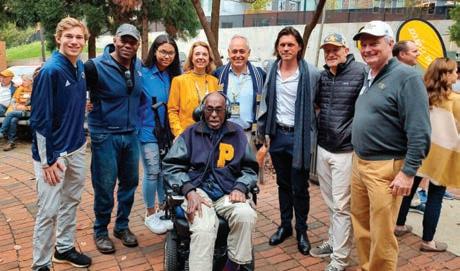


1971 Karl Binns joins the Yellow Jackets men’s varsity basketball team as its first Black player.
WADE MITCHELL AND BOBBY GRIER MEET AGAIN
In June of 2022, Bobby Grier—then 89 years old—made a trip to Atlanta in honor of Juneteenth. Together with his son Rob and President Van Leer’s grandson, Blake, they toured the National Civil and Human Rights Museum, the College Football Hall of Fame, and Georgia Tech. In a special surprise, Wade Mitchell met and shook hands with Grier for the first time since 1956. The group shared a meal at a local Atlanta restaurant, along with Mitchell’s son, Wright.
Blake Van Leer and Rob Grier are currently working together on a film called Bowl Game Armageddon. It will focus on Bobby Grier and Tech President Blake R. Van Leer, the 1956 Sugar Bowl, and the two men’s legacies. In a statement for a 2022 Atlanta Journal-Constitution article, Wade Mitchell said, “I greatly admired Bobby [Grier]’s courage during that time… There was a lot of pressure on Bobby, but he remained true to his values, and I hope that his legacy can be shared more widely through this project.”
96 SPRING 2024 | GTALUMNI.ORG/MAGAZINE





GTALUMNI.ORG/MAGAZINE | SPRING 2024 97 ADVERTISEMENT TECH MARKETPLACE The easiest decision of your trip. Delivering the exceptional stay you deserve,everywhere you want to be. Intuitively designed for both function and comfort, it’s our priority to give you a seamless experience — every time. With a variety of amenities you can count on, you’ll have everything you need to stay on track.
Located just steps away from Bobby Dodd Stadium, you will be welcomed with a warm smile and thoughtful service that makes you happybecause that's what makes us happy. That’s the 100% Hampton Guarantee™. Want Your Company Featured HERE? BUZZ DOES! Reach out to Darius Woody and sign up today! 678-592-6472 Director of Business Development A newday inWealthManagement TransformyourportfoliowithReveille. Isyourportfoliostrugglingintoday'smarket?Areyousearchingfor bettersolutionsthanjust"hanginginthere"or"ridingitout"?Reveille canhelp.Weactivelymanageyourinvestmentstoadapttochanging marketconditions,alwayskeeping your needsandgoalsinmind. Wecanhelpyoutotakechargeofyourfinancialfuture. Askushow. Securities offered through Raymond James Financial Services, Inc., member FINRA/SIPC. Investment advisory services are offered through Raymond James Financial Services Advisors, Inc. Reveille Wealth Management is not a registered broker/dealer and is independent of Raymond James Financial Services 525WestparkDrive,Suite100 PeachtreeCity,GA30269 info@reveillewealth.com 678.489.7314
•Free,hotbreakfast •Modernfitnesscenter •Pet-friendlyaccommodations •ContactlessArrivalwithDigitalKey HamptonInnAtlGeorgiaTech 244NorthAvenue NW Atlanta GA30313 404-881-0881 www.hilton.com/en/hotels/atlgthx
HOW BIG IS BIG BUZZ?

TOWERING AT 40 FEET TALL, “BIG BUZZ” LIVES UP TO ITS MAMMOTH MONIKER. SEE HOW THE REST OF THESE CAMPUS FEATURES STACK UP.
BY JENNIFER HERSEIM
WHILE ENGROSSED IN THE CALCULATION of the velocity of a falling object in physics class, you might have overlooked the size of these iconic campus objects towering overhead. We took out our measuring stick to nd the dimensions of some of these favorite campus features.

BIG BUZZ

40 feet
The Ramblin’ Reck Club hauls this larger-than-life inflatable Buzz to events around campus. The new Reck Garage includes a specially designed closet to store it.

80 feet

KESSLER CAMPANILE
The obelisk served as the centerpiece of the Olympic Village during the 1996 Olympics. The space surrounding the water feature was redesigned in 2023 for greater accessibility.
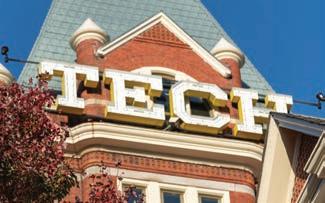
TECH LETTERS
Added in 1918, these iconic letters atop the academic building are the reason we call it “Tech Tower.”
5 feet










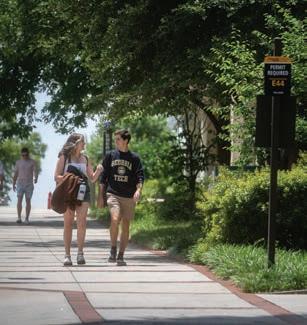
56 feet of elevation
FRESHMAN HILL
1,056 feet long and 56 feet of elevation. Surely, this massive hill grows bigger depending on how late you are for class.

200 feet
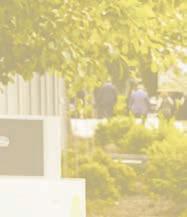
CODA’S SPIRAL STAIRCASE
The dizzying staircase located inside the Coda building at Tech Square is the largest freestanding spiral staircase in the world.

How tall is Bobby Dodd Stadium?
?
Think you can correctly guess the heights of campus buildings and objects? Test your ability at gtalumni.org/BigCampusQuiz

BACK PAGE
98 SPRING 2024 | GTALUMNI.ORG/MAGAZINE
Be a part of Tech’s future success
Build a better Georgia Tech for future generations and continue the Institute’s legacy of excellence by being a part of Roll Call’s Leadership Circle. The generosity and dedicated giving of Leadership Circle donors builds future leaders by laying the groundwork for current student success.




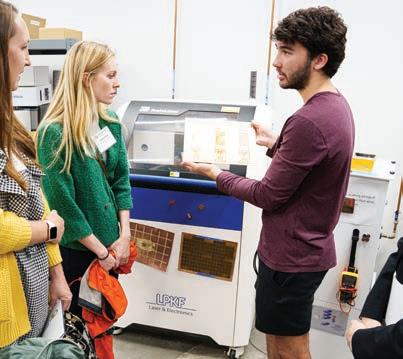










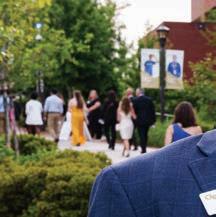



Special opportunities for recent graduates! To learn more, visit GTalumni.org/LeadershipGiving







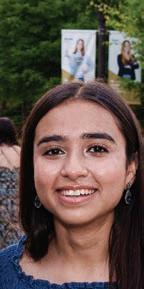







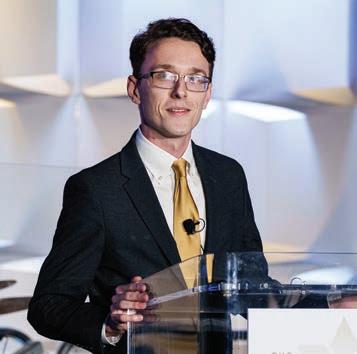







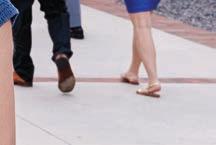

Gi s can be mailed to: Roll Call, Georgia Tech Alumni Association 190 North Ave. NW, Atlanta, GA 30313
404-385-4483 (GIVE)










Give to Roll Call today: GTalumni.org/GiveToday





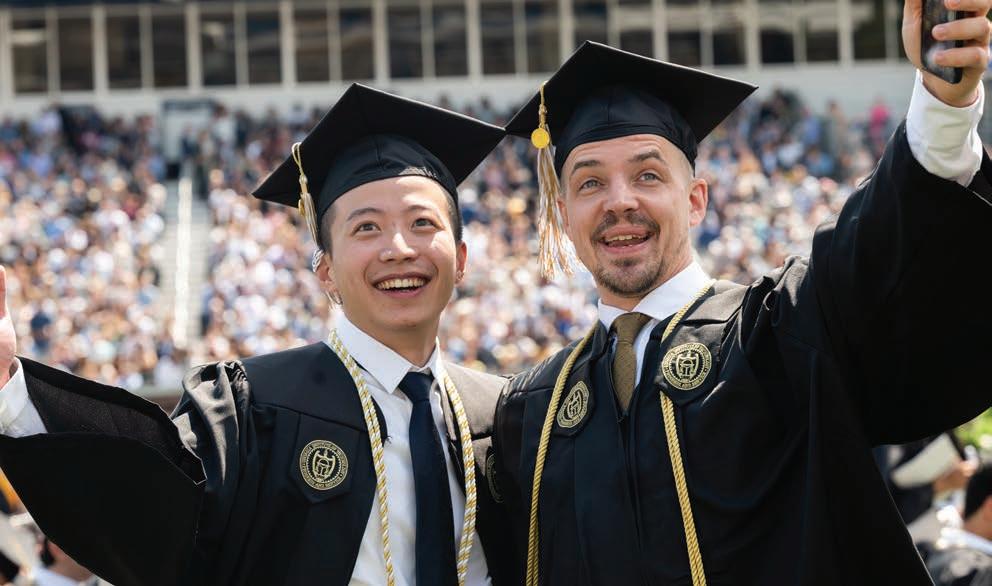
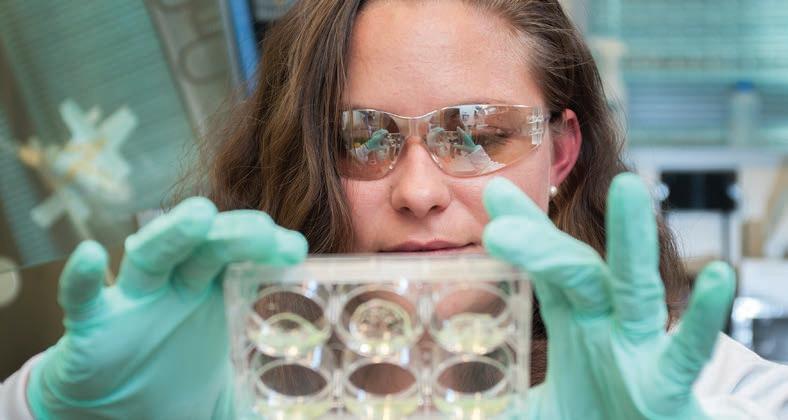



Transforming Tomorrow: The Campaign for Georgia Tech is securing the resources that are advancing the Institute and its impact — on our students, faculty, and society — as we work together to learn, discover, and create innovative solutions that will benefit the world for decades to come.


Invest today and transform tomorrow at transformingtomorrow.gatech.edu
X N Questions? Call 1-866-664-4621 or
1 Go to Gtalumni.benefithub.com/welcome/register/TFEQ65 2 Sign up & start saving! Scan the code
celebrate
on
travel, entertainment, and more!
email customercare@benefithub.com
Shop our discount marketplace and
savings
health & wellness, insurance,
Save on getaways




















































 DENE SHEHEANE, MGT 91 PRESIDENT GEORGIA TECH ALUMNI ASSOCIATION
DENE SHEHEANE, MGT 91 PRESIDENT GEORGIA TECH ALUMNI ASSOCIATION












































































































































































































































































 BY KRISTIN BAIRD RATTINI
BY KRISTIN BAIRD RATTINI


















































































































































































































































































































































































































































































































































































































 BY SHELLEY WUNDERSMITH
BY SHELLEY WUNDERSMITH





















































































































